research report 2017





























As the new Vice-Chancellor of CPUT, it is my pleasure to share with you my thoughts on our research achievements for 2017. This report is again testimony to the dedication and hard work of our collective leadership, all our academic staff, research support and administrative staff, and our students.
Notwithstanding the fact that 2017 was a challenging year for CPuT, we managed to produce considerably more new knowledge – in the form of published research outputs – than in the previous year. Our external research funding is also growing. The research aspirations of CPuT are articulated in the RTI Blueprint and manifest themselves predominantly in seven research focus areas, namely:
• Bio-economy & biotechnology
• Space science & technology
• Energy
• Climate change & environment
• Human & social dynamics (including service delivery)
• Economic growth & international competitiveness
• Design for sustainability
I am pleased to observe that this report specifically endeavours to highlight the various research activities and accomplishments of our researchers in these seven focus areas.
Our research activities gain further impetus and traction through the dedicated hard work of three NRF SARChI Chairs, i.e. Work-Integrated Learning, Teacher education, and Innovative Small Satellite Technology and Applications for Africa. We are also proud of the two SeTA-funded Chairs in Work-Integrated Learning and Wholesale and Retail Leadership. In addition, we have four CPuT-funded Chairs, i.e. Biotechnology, Oceans economy, Innovation in
Society, and Literacy Development. These nine Research Chairs have made a significant contribution to CPuT’s research aspirations and achievements. In addition, we now have 41 NRF-rated researchers, distributed across the six faculties.
Our national and international partnerships are a key aspect of our strategic positioning within the research landscape and a significant driver of our research reach and relevance. This report reflects on these important partnerships, which we intend to expand in the years to come. CPuT is also beginning strategically to align itself to meet the challenges of the 4IR and 5IR, and further contribute towards achieving sustainable development goals and other relevant policy targets.
As the institution is keen to position itself as a leading role-player through technological and social innovation, we are proud of the numerous achievements of our Technology Transfer Office. We are committed to growing this function into one of the most effective of its kind in South Africa.
Postgraduate student numbers increased in 2017, but we are determined to grow these numbers significantly going forward, despite the challenges that we are currently experiencing in respect of throughput rates and supervision.
None of these achievements would be possible without dedicated staff, students and stakeholders. I wish to thank and congratulate our leadership and staff together with our students for the research achievements articulated in this report. They are evidence of how much more we can still achieve together.
I wish also to thank sincerely our dedicated external stakeholders, funders and especially the Department of Science and Technology and the Department of higher education and Training, which continue to support us in our research endeavours. I invite our leadership, all staff and students, together with our many friends and stakeholders, to join us in continuing to develop CPuT as one smart university.
o ur national and international partnerships are a key aspect of our strategic positioning within the research landscape and a significant driver of our research reach and relevance.

As die nuwe Visiekanselier van CPUT deel ek graag met u my indrukke van ons navorsingsprestasies vir 2017. hierdie verslag is weer eens die bewys van die toewyding en harde werk van ons leierskap, van al ons akademiese personeel, die ondersteunings- en administratiewe navorsingspersoneel, asook ons studente.
Ten spyte daarvan dat 2017 ’n uitdagende jaar vir CPuT was, het ons daarin geslaag om aansienlik meer kennis te skep in die vorm van gepubliseerde navorsingsuitsette as in die vorige jaar. Ook ons eksterne navorsingsbefondsing is besig om te groei. CPuT se navorsingsaspirasies word bewoord in die Bloudruk vir Navorsingstegnologie en Innovering en vind gestalte in sewe fokusareas, naamlik:
• Bio-ekonomie & biotegnologie
• Ruimtewetenskap & -tegnologie
• Energie
• Klimaatsverandering & die omgewing
• Menslike & sosiale dinamika (insluitende dienslewering)
• Ekonomiese groei & internasionale mededingendheid
• Ontwerp vir volhoubaarheid
ek is bly om te sien dat hierdie verslag spesifiek daarna streef om die verskillende navorsingsaktiwiteite en prestasies in hierdie sewe fokusareas uit te lig.
Ons navorsingsaktiwiteite kry verdere stukrag danksy die volgehoue harde werk van drie NNF SARChi navorsingsleerstoele, nl. Werkgeïntegreerde Leer, Onderwysersopleiding, en Innoverende Kleinsatelliet-tegnologie & Aanwending vir Afrika. Ons is ook trots op die twee SeTA-befondsde leerstoele in Werkgeïntegreerde Leer en Groot- en Kleinhandelsleierskap. Verder het ons ook vier leerstoele wat deur CPUT befonds word, nl. Biotegnologie, Oseane-ekonomie, Gemeenskapsinnovering, en Geletterdheidsontwikkeling. hierdie nege navorsingsleerstoele het
’n aansienlike bydrae gelewer tot CPuT se navorsingsambisies en -prestasies. Verder het ons tans 41 NNF-gegradeerde navorsers, versprei oor die ses fakulteite.
Ons nasionale en internasionale vennootskappe is ’n kernaspek van ons strategiese plasing binne die navorsingslandskap en ’n beduidende dryfveer van die omvang en relevansie van ons navorsing. Vanjaar se verslag gee ’n oorsig van hierdie belangrike vennootskappe waarop ons graag sal wil uitbrei in die jare wat kom. CPuT is ook besig om haarself op strategiese wyse te posisioneer om die uitdagings van die 4IR en 5IR die hoof te bied, en verder by te dra daartoe om volhoubare ontwikkelingsdoelwitte en ander relevante beleidsdoelstellings te bereik.
Aangesien die instelling haarself graag wil posisioneer as ’n leidende rolspeler wat betref tegnologiese en sosiale innovasie, is ons trots op die vele prestasies van ons Tegnologie-oordrag Kantoor. Ons is daartoe verbind om hierdie funksie uit te brei tot een van die effektiefste in sy soort in Suid-Afrika.
Nagraadse studentegetalle het toegeneem in 2017, maar ons is daartoe verbind om hierdie getalle in die toekoms verder te laat groei, ten spyte van die uitdagings wat ons tans ervaar wat betref deurvloeikoers en studieleiding.
Geen van hierdie prestasies sou moontlik gewees het sonder toegewyde personeel, studente en ander rolspelers nie.
ek wil graag ons leierskap en personeel, tesame met ons studente, bedank vir en gelukwens met die prestasies wat in hierdie verslag weergegee word. hierdie prestasies dien as bewys van hoeveel meer ons saam kan vermag.
ek wil ook graag my opregte dank oordra aan ons toegewyde eksterne medewerkers, befondsers en in die besonder die Departement van Wetenskap en Tegnologie en die Departement van hoër Onderwys en Opleiding, vir hulle volgehoue ondersteuning van ons navorsingsaktiwiteite. ek nooi ons leierskap, al die personeel en studente, saam met ons baie vennote en rolspelers, om saam met ons aan te hou werk om CPuT te ontwikkel tot ’n uitmuntende universiteit.
o ns nasionale en internasionale vennootskappe is ’n kernaspek van ons strategiese plasing binne die navorsingslandskap en ’n beduidende dryfveer van die omvang en relevansie van ons navorsing.
Njengosekela-Ngqonyela waseCPUT, kuluvuyo kum ukuba ndabelane nani ngempumelelo yophando lowama2017. Le ngxelo kwakhona ingqina ukuzinikezela nokusebenza nzima kwesikhokelo sethu, bonke abasebenzi bethu bokuphuhlisa imfundo ephakamileyo, inkxaso yophando nabasebenzi bezolawulo, kunye nabafundi bethu.
Nangona unyaka wama2017 ibingunyaka ocela umngeni e-CPuT, sikwazile ukuvelisa ulwazi olutsha oluninzi-olufana neemveliso zophando ezipapashiweyo-ukodlula kwiminyaka engaphambili. Inkxaso-mali yethu yangaphandle iyakhula kananjalo. ulangazelelo lophando e-CPuT ludandalazisiwe kumqulu wesicwangciso woPhando, ezobuChwepheshe nezokuVelisa izinto ezintsha kwaye luyazibonakalisa ingakumbi kwiinkalo ezisixhenxe zophando, ezizezi:
• Ezobom noqoqosho kunye nobuchwepheshe kwezobom
• Ezenzululwazi ngomoya ojikeleze umhlaba kunye nezobochwepheshe
• Ezamandla
• Ezokuguquka kwemozulu nokusingqongileyo
• Ezokutshintsha koluntu nezentlalo (ibandakanya unikezelo lweenkonzo)
• Ezokukhula kwezoqoqosho kunye nozokukhuphisana kumazwe ngamazwe
• Ezoyilo lokuzinzisa
Ndinovuyo ukuqaphela ukuba le ngxelo ijolise ngokukodwa ukuvakalisa uthotho lwemisebenzi yophando kunye nempumelelo yabaphandi bethu kwezi nkalo sisixhenxe. Imisebenzi yethu yophando ifumene amandla ngokuzijula ijacu kooSihlalo abathathu beNRF SARChl, kula macandelo, umsebenzi olungelelaniswe nokufunda, Izifundo zobutitshala, nezokuVelisa izinto ezintsha kwezobuchwepheshe besathelayithi encinane nasekuyisebenziseleni i-Afrika.
Sikwanebhongo ngooSihlalo abaxhaswa ngemali yiSETA kuMsebenzi olungelelaniswe nokufunda nakwisiKhokelo sehoseyile nokuthengisa ngemiyinge emincinane. ukongeza, sinooSihlalo abaxhaswa yiCPuT ngemali abane, kwezobuChwepheshe kweZobom, ezoQoqosho leeLwandle, ezokuVelisa izinto ezintsha eluntwini, nezoPhuhliso

lweLitherasi. Aba Sihlalo boPhando balithoba benze igalela elimmandla kwiintakazelelo neziphumo zophando zaseCPuT. Ukongeza, sinabaphandi abangama41 ngokwezinga leNRF (NRF-rated researchers), abachakwe kuzo zontandathu iifakhalithi.
ubambiswano esinalo kwisizwe nakumazwe ngamazwe yinkalo engundoqo yelinge lokusibeka kwisimo sophando kwaye ngumqhubi obalaseleyo wokufikelela kuphando nonxulumano. Le ngxelo sisipili solu bambiswano lubalulekileyo, esinenjongo zokulunwenwisa kwiminyaka ezayo. I-CPuT ikwaqalisa ilinge lokuzayamanisa nokufezekisa imingeni yeNtshukumo yeZamashishini yeSine kunye neNtshukumo yeZamashishini yeSihlanu, kwaye ibe negalelo elinochatha ekufezekiseni iinjongo zophuhliso oluzinzileyo kunye neminye imigaqo-nkqubo efanelekileyo ekujoliswe kuyo.
Njengoko iziko lizimisele ukuzibeka njengomthabathi-nxaxheba okhokelayo kwezobuchwepheshe nakwezokuvelisa izinto ezintsha eluntwini, sinebhongo ngentlaninge yempumelelo yeTechnology Transfer Office yethu. Sizibophelele ekukhuliseni lo msebenzi ube ngomnye waleyo isebenza kanobom eMzantsi Afrika.
Inani labafundi abasele bathweswa izidinga likhulile ngowama2017, kodwa sizimisele ukuwakhulisa la manani kakhulu ukuya phambili, naphantsi kwemingeni esijongene nayo kwicala lezinga labaphumelelayo kunye namakhankatha.
Akukho nanye kwezi mpumelelo ebinako ukwenzeka ngaphandle kwabasebenzi abazinikeleyo, abafundi kunye nabathabathi nxaxheba. Ndifuna ukubulela kwaye ndithulele umnqwazi isikhokelo sethu kunye nabasebenzi bebambisene nabafundi bethu ngempumelelo yophando edandalizisiweyo kule ngxelo. Babubungqina bokuba kukhulu kangakanani na esinako ukuphumelela ngokubambisana.
Ndifuna kwakhona ukwenza ilizwi lombulelo ngenene kubathabathi nxaxheba bangaphandle abazinikeleyo, abaxhasingemali kwaye nangakumbi kwiSebe lezeNzululwazi nezobuChwepheshe neSebe lezeMfundo ePhakamileyo noQeqesho, abathe gqolo besixhasa kwiinzame zophando lwethu. Ndihlaba ikhwelo kwisikhokelo sethu, abasebenzi bonke kunye nabafundi, ngokubambisana nabahlobo bethu abaninzi kunye nabathabathi nxaxheba ukuba bazibandakanye kunye nathi ukuphuhlisa i-CPuT njengeyunivesithi esemgangathweni.
Ubambiswano esinalo kwisizwe nakumazwe ngamazwe yinkalo engundoqo yelinge lokusibeka kwisimo sophando kwaye ngumqhubi obalaseleyo wokufikelela kuphando nonxulumano.
In August 2017, Prof sheldon was appointed as the Acting DVC: Research, Technology, Innovation & Partnerships when Dr Nhlapo became the Acting Vice-Chancellor. Later in 2017, Prof Pellissier was appointed Acting Director of strategic Initiatives & Partnerships, to start officially on 1 January 2018.

This Research Report provides an overview of CPuT’s research activities and performance for 2017. It is a great pleasure to share some of the research highlights of our very dedicated staff and students, who in spite of all the challenges faced during the year still managed to achieve a higher research output than in previous years.
CPuT’s RTI Blueprint provides the strategic directives and operational framework for all institutional research and research-related entities. The aim of the RTI Blueprint is to develop research uptake in two ways:
• Development of third-stream income by enhancing entrepreneurship opportunities
• Increasing research output by providing support mechanisms in terms of capacity building and funding
The pillars and driving forces of the RTI Blueprint are:
• Excellence
• Strategic partnerships
• Unlocking staff and student potential
• Multi- and interdisciplinary focus
CPuT’s seven focus areas are:
• Bio-economy & biotechnology
• Space science & technology
• Energy
• Climate change & environment
• Human & social dynamics (including service delivery)
• Economic growth & international competitiveness
• Design for sustainability
In 2017, CPuT had three NRF SARChi Research Chairs: Work-Integrated Learning, Teacher education, and Innovative Small Satellite Technology and Applications for Africa. It also had two SeTA-funded chairs: Work-Integrated Learning and Wholesale and Retail Leadership. In addition, four CPuT chairs were funded: Biotechnology, Oceans economy, Innovation in Society, and Literacy Development. The main goal of the research chairs initiative is to strengthen and improve the university’s research and innovation capacity, to produce high-quality postgraduate students, to deliver Research & Innovation outputs, and importantly, to contribute to research uptake with an impact on society.
Figure 1 shows that CPuT’s research output for 2017 is greater than in previous years. The graph provides research output as submitted to DHET (not yet confirmed). For the 2017 period, there has been an increase in journal publications compared with 2016, as well as an increase in output per capita to 0.31.

During 2017, SATN initiated a bibliometric assessment of research at all uoTs between 2005 and 2016. The report by Prof Mouton released in April 2018 included an analysis of research activities at CPuT as well as a comparative analysis of research at other uoTs. This study revealed that while CPuT’s overall research output was growing at an average annual rate of 15%, this was lower than the sector average of 23% over the past 12 years. A similar pattern was evident when the production of research articles alone was analysed. While CPuT’s number of research articles published was averaging an annual growth rate of 15%, this again was lower than the sector average annual growth rate of 24%.
“The CPuT distribution of publications by science domain revealed an equal distribution from Natural Sciences (30%) and Social Sciences (30%), with other contributions from Engineering (20%) and Health Sciences (13%). Twothirds (66%) of papers were in international databases including Web of Science and Scopus, 10% in journals listed in IBSS with another 19% in local SA journals. The distribution of authorships according to the race of the author for the 12-year period shows that 42% of article units were produced by white authors, 40% by black African-authors and 15% by coloured authors. African staff members are very productive and there is a trend showing a steady increase in African-authored papers (especially since 2014). What is very promising is that the biggest single proportion of articles over the past twelve years was produced by authors between the ages of 40 and 49 (34%), followed by authors between 50 and 59 (27%), while the proportion of authors in the highest age bracket (60+) was very small. It is also noteworthy that 24% of all papers were produced by academics under
the age of 39” (Mouton, 2018). These statistics are really exciting in that they indicate the growing proportion of younger researchers who are actively publishing.
At the end of 2017, CPuT had 41 NRF-rated researchers having received 11 ratings in 2017 alone. The eleven 2017 NRF ratings consisted of four upgrades, three retained ratings and four new ratings. The rating levels included two C1, three C2, four C3 and one Y1. The ratings per faculty comprised five for Applied Sciences, one for Business & Management Sciences, one for Informatics & Design, three for health & Wellness Sciences, and one for a research Institute (IBMB).
The postgraduate student complement continues to be a very important section of our student population. In 2017, CPuT enrolled 34 702 students, of whom 2 136 were postgraduates (6.16%), an increase from 5.82% in 2016. The 2 136 PG students consisted of 290 below master’s, 1 561 master’s and 285 doctoral candidates, of whom 76% were South Africans. The postgraduate success rate for 2017 was 78%. The total number of graduates in 2017 was 9 088, an increase from 8 821 in 2016. There were 377 (4.2%) postgraduate graduates altogether, of whom 320 (3.5%) were South African; 93 of them were master’s students and 17 doctoral students. The throughput rates in minimum time for postgraduate students continues to be a challenge and will be an important focus for 2018 and beyond.
The RTI-sIP provides strategic direction to the RTI, inter alia, through strategic partnerships (nationally and internationally) and management of the RTI strategy (RTI Blueprint) and its supporting mechanisms.
These mechanisms are:
• Strategic partnerships (with government, industry, higher education and the community as per the quadruple helix model of CPuT’s open innovation system)
• The seven research focus areas
• The CPUT research entities
• The research chair initiative
• Engagement with industry to ensure relevance and excellence

CPuT’s RTI follows a cradle to cradle approach in identifying and fulfilling its research purpose of research uptake as relevant to society’s problems.
The principles of the RTI Blueprint support our extended value chain as encapsulated by the above graphic, namely to:
1. enhance our partnerships and networks locally and internationally with a view to deepening research capability
2. Attract and retain excellent researchers and research support staff
3. expand our programme of staff development to capacitate more staff to do research
4. Create the optimal structures to promote research, innovation and technology transfer

5. Infuse a spirit of innovation into all our teaching and research
6. Strengthen mechanisms to maximise the benefit of intellectual property and the promotion of business incubation
CPuT is at the dawn of a new era of research relevance and excellence. The summary intent of CPuT research is environmental sustainability, as encapsulated by the circular economy represented in the Figure above. As a uoT, CPuT’s continuing emphasis on partnerships contributes to its unique focus on cradle-to-cradle research uptake. Indeed, CPuT’s technological and social innovation focus now puts the university in a strong position to inform, and be informed by, the 4IR, 5IR and the paradigm of sustainable development goals (SDGs). These are encapsulated by the seven
research focus areas that not only drive the university’s research agenda, but also support its teaching agenda.


There is a continuous drive to encourage new niche areas in support of the high-level focus areas to ensure that CPuT research remains appropriate to real-life problems.
In support of CPuT’s research agenda, the university hosts several South African Research Initiative (SARCHi) chairs as well as other funded research chairs. The research chairs are supported according to the CPuT operational framework for research chairs in the office of the DVC: RTI&P. The current list of research chairs appears below (note that expansions are planned to include Energy, Water and, possibly, Waste).
CPUT Biotechnology Prof Wentzel Gelderblom
CPUT Oceans Economy Prof Kenneth Findlay
CPUT Innovation in Society (Service Design)
Prof Thomas Thurner
CPUT Literacy Develoment Prof Rajendra Chetty (resigned March 2017)
SARCHi/DST Work Integrated Learning Prof Christine Winberg (Tier 1)
SARCHi/DST Teacher Education Prof Yusuf Sayed (Tier 1)
SARCHi/DST Small Satellite Technology and Applications in Africa
Appointment in progress
The importance of a focus on 4IR and 5IR in a u oT cannot be underestimated. Such institutions are particularly suited to technology developments and partnerships. Partnerships are essential to unlock the capabilities within an entity and, more importantly, across its partnership landscape. In the case of CPu T, there are several national and numerous international partnerships supporting our teaching and research agenda. Some of the strategic partnerships CP u T is involved in include a collaboration with the Department of Environmental Affairs, the IZIKO museum and Planetarium (Cape Town), the Cape Higher Education Consortium (CHEC) and the South African Technology Network (SATN). We are very proud of our ongoing partnerships internationally, particularly those associated with Erasmus+ funded programmes (Impala and Yebo!) and other international programmes.
Figure 4 summarises the geographical distribution of our current international footprint. The current drive is towards building a stronger African partner base.
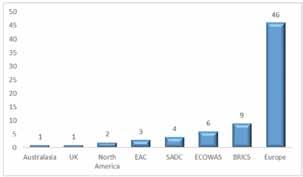
strategic international project 1: ImPALA (International and modernisation Programme for Academics, Leaders and Administrators)
The partnership seeks to develop international capacity for South African universities to augment capacity.
a. mobility toolkit
A venue on the District Six campus is being set up to host infrastructure as an international classroom for the use of CPuT
b. summer schools and short programmes
Short course on African cuisine developed by CPuT community engagement in conjunction with hotel School as possible third stream income
c. Internationalisation of the curriculum
• Decolonisation seminars unpacking elements of decolonisation and an endeavour for CPuT to disseminate the information
• COIL (Collaborative Online International Learning and Decolonising Education):
Infrastructure for the development of an international classroom is being installed
d. Project writing and management
The initiative provides for a collaboration with South African and european partner universities for joint funding
W&R SETA Wholesale & Retail Leadership Prof Roger Mason
ETDP SETA Work-Integrated Learning Prof Nothemba Nduna
strategic international project 2 Yebo!:
Internationalisation of doctoral education project
The partnership is an Erasmus+ Programme of the eu granted in the amount of €940 000. This is a capacity-building project coordinated by the university of Montpellier in order to develop international PhD programmes as a collaboration between european and South African universities. The project was launched in December 2017. The main purpose of the YEBO! project is to foster and develop the internationalisation of doctoral studies in South Africa. Based on the outcomes of the FRINDOC survey, the programme aims to address existing problems within doctoral studies.
Four main approaches were identified in response to the identified needs of the participating South African universities:
a. Completion and analyses of the international FRINDOC questionnaire on research capacity determination and statistical analysis of survey data (CPUT)
b. Development of a web-based portal that encompasses research and funding networks, identification of funding opportunities (CPUT)
c. Four themed conferences focusing on best practices for the internationalisation and promotion of doctoral education, and fostering networking and cooperation opportunities (one at CPUT)
d. Three training sessions, organised in South Africa, with a focus on supervision capacities
strategic international project 3: sAsUF (south Africa swedish University Forum)
CPuT participated in the planning of the research themes in collaboration with our Swedish counterparts. The themes have reference to CPuT’s 4IR focus. CPuT researchers continue to participate in the following six themes
Theme 1 - Climate change, natural resources and sustainability
Theme 2 - Transforming higher education curricula: The nexus between academia and society
Theme 3 - Social transformation through change: Knowledge and social development strategies for society
Theme 4 - understanding the burden of disease in Sweden and South Africa and its impact on the health systems of the two countries in the future
Theme 5 - urbanisation and cities in the 21st century
Theme 6 - Digital technologies, big data, and cybersecurity
strategic international project 4: The U6+ Consortium
The initiative is hosted by its various member institutions which include Jaramogi Oginga university of Science and Technology in Kenya, Kwara State University in Nigeria, university of The Gambia, university of Cape Coast in Ghana and university of Ilorin in Nigeria. New members were introduced this year: the university of Calabar in Nigeria and the University of Eldoret in Kenya. The initiative started as a bilateral agreement but has grown into a consortium for best practice sharing. The first initiative of the u6 Consortium was the establishment of the African Centre for herbal Research at the university of Ilorin, the Director of the centre being appointed on a rotational basis from the u6 member institutions and the knowledge gathered and shared. The centre will explore African flora, stimulate research and advise on government and stakeholder collaboration.
erasmus+ mobility
CPuT currently offers credit mobility through the following university collaborations: Aalto university, School of Science, School of Arts, Design and Architecture, Abertay University, AVANS, Hochschule Wismar (HSW), Hochschule Flensburg (HFL), Uniwersytet Szczecinski (USZ), Universitatea Lucian Blaga Din Sibiu (ULBS), Asiin Consult CMBH (ASIIN), JAMK University of Applied Sciences, Instituto Superior De Contabilidade e Administraçao Do Porto, Riga Technical university, Technical university Sofia, universitatea Romano-
Americana / Romanian-American university, university of economics in Bratislava, university of hasselt, uPeC and Yildiz Technical university.
CPUT buddy system
In support of our international students, CPuT SIP provides social support to international students. This includes the CPuT buddy system, which aims to partner a CPuT student with an international student in support of one of our main internationalisation objectives, internationalisation at home. The buddy system, being new, required potential buddies to be trained in understanding diversity.
a lone we can do so little; together we can do so much ( h elen Keller)

Research activity and productivity have again made considerable advances since our previous report.The enhancement of the management role of the Research Directorate has contributed significantly to realising our vision of rendering world-class service and support to our research community.
The report for 2017 is distinctly different from previous years in that we have commenced reporting on our research activities according to our seven focus areas, namely: (i) Bio-economy & biotechnology; (ii) Space science & technology; (iii) Energy; (iv) Climate change & environment; (v) Human & social dynamics (including service delivery); (vi) Economic growth & international competitiveness; (vii) Design for sustainability. We have retained faculty-specific reports, but from now on will report our research activities in terms of these focus areas.
As a reminder to our readers, I wish to highlight the following activities for which we are responsible as part of the portfolio of the Deputy Vice-Chancellor: Research, Technology Innovation & Partnerships:
• Institutional research policy development, implementation, monitoring and evaluation
• Direction of and support for the overall research performance targets of the institution in terms of research outputs, NRF ratings and research funding internally and externally

• Providing a comprehensive suite of research training and capacity development interventions with a focus on coaching and mentoring
• Professional grants management and administration, grants and funding communication services and support, advisory services and support
• Custodian of various university internal research funds to support research and research development across the institution
• Research financial advisory services, financial processing administration, budget control services and annual audits
• Research management and information, ensuring timely and accurate research analysis, reporting and science communication internally and externally
• Research integrity and ethics management and administration
• Annual institutional research outputs review and submission
• Various annual and monthly research reports
• Participation in national and international research forums, associations, professional bodies and foundations, placing a premium on strategic partnerships through the Cape Higher Education Consortium (CHEC)
As research activity and productivity increase, the volume of work of the Research Directorate increases as well. We are fortunate that we have strengthened our ability to deliver through a strong and productive partnership approach with our academic community and various internal and external stakeholders. In so doing, we continue to contribute to the bold ambitions of the transformation agenda of our country through research that is inspired by society and research that finds its way back to society. Our researchers are driven by their desire to contribute to the scholarship of discovery, innovation and application.
We wish to thank our leadership at all levels for their unwavering support for the work that we do. In particular, we wish to thank and congratulate our researchers for ensuring that we can celebrate our research achievements once again this year. Much more work lies ahead for all of us, but we are resolved to continue to do more, to do it better, and to be smarter.
My sincere thanks go to my staff in the Research Directorate for their dedicated hard work, giving excellent service to our research community with pride and professionalism. I invite all our readers to join us in celebrating CPuT’s research achievements of 2017.
a s research activity and productivity increase, the volume of work of the r esearch Directorate increases as well.
We are fortunate that we have strengthened our ability to deliver through a strong and productive partnership approach with our academic community and various internal and external stakeholders.
The year 2017 was yet again a productive one for the Centre for Postgraduate studies (CPGs). The CPGs prides itself on supporting, developing and enhancing postgraduate studies at CPUT, in alignment with the institution’s commitment to promoting postgraduate education and continuing to grow its own postgraduate student cohort.
During 2017, 1 563 master’s students and 286 doctoral students were registered, and 10 interns and 10 postdoctoral fellows were hosted by CPuT. In 2017, 26 students graduated with a doctoral degree, while 135 graduated with a master’s degree.
CPGS is responsible for the following postgraduate areas:
• Directs, develops and administers all postgraduate education and research at CPUT
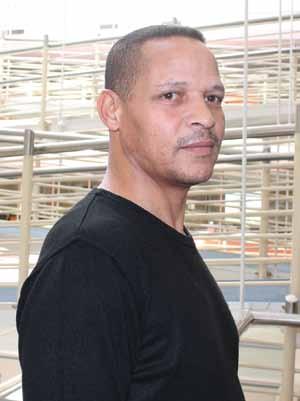
• Through established processes, offers a seamless service to registered postgraduate students
• Appoints postdoctoral fellows
• Manages the administration of postgraduate students and oversees the academic involvement of postdoctoral fellows
• Administers the DST–NRF Internship programme
• Manages some BTech student bursaries
• Coordinates all the activities of the Higher Degrees Committee (HDC), inclusive of interaction with the faculty research coordinators in respect of hDC documents, preparation of hDC meeting agendas, and submission of hDC-approved documents to Senate
The administration of higher degrees is facilitated by our own customised hDC digital system, now in its fourth year of operation with over 2 000 users. The system is continuously monitored to ensure that we improve its functionality year after year for the benefit of the institution.
We are proud to share with our readers statistics for postgraduate bursary support, which show an increase over 2016. In 2017, a total of 322 students were supported with bursaries from various sources with a total value of R17 279 000. These sources are acknowledged in the following list:
The centre organised several research development workshops and seminars during 2017, including proposal writing, research design and research methodology, statistical data analysis, article writing, and the use of plagiarism detection software (Turnitin). We are seeing an increasing number of postgraduate students and academic staff/supervisors participating in these events. The centre is busy developing a comprehensive training and capacity development programme for CPuT’s postgraduate students to be implemented in 2018.
CPGS is strenuously committed to improving its services, and to supporting and assisting supervisors and postgraduate students. I look forward to being in a position to report on progress made in our next report. Last, but not least, I wish to thank the CPGS staff for their hard work during 2017.
t he cpgs prides itself on supporting, developing and enhancing postgraduate studies at cp U t, in alignment with the institution’s commitment to promoting postgraduate education.Dr Revel Iyer

iyerr@cput.ac.za
The year 2017 saw the creation of the first CPUT spin-off company, Amaya space. Amaya space is set to become a leading Cubesat-focused space company on the African continent, with its sights set on delivering quality Cubesat innovations and information services. It also represents the first truly transformed cube satellite company, by Africans for Africans. Over the last eight years it has developed highly manufacturable solutions, perfect for reliable cube satellite constellations. Through the power of data analytics, these constellations can deliver invaluable data and insights to African governments and businesses and eventually across the globe.
The name ‘Amaya’ was derived from SA football philosophy’s ‘tsamaya’, which recognises and expresses a creative, skilful and joyful expression of flair and individual brilliance that is celebrated within the collective. This represents the ethos of the company.
The Technology Transfer Office at CPuT is a key enabler of this initiative. We have resolved that it is critical for our nation and our continent to establish a strong, African-born nanosatellite company. South Africa already has a couple of nanosatellite industry players, but these companies are not truly transformed and representative of our nation’s demographics as none of them are being run by black South Africans; none of them focus on employing young black South African engineering graduates; and none of them are well positioned to be the preferred supplier for the South African Government. The company will furthermore aim to catalyse a transformational supplier development programme.
During 2017, CPUT received its very first Technology Innovation Agency Technology Development Fund (TDF) grant. The R4.8 million TDF grant is directed at maturing the CPuT waste water reactor technology to a pilot phase. More specifically, the aim is to demonstrate the technology using real industry effluent streams at a volume of 1000 litres per hour. It is hoped that on completion of the project a spin-off company will be formed to take the product to market.
The system is a one-step waste water treatment process consisting of highly reactive nanoparticles immobilised in a specialised reactor system for the purpose of treating industrial wastewater. The system utilises a nanoparticle catalyst, which activates an oxidiser in order to produce sulphate radicals that attack and degrade inorganic
pollutants (dyes) in the textile wastewater. The system allows the re-usage of effluent water in one continuous process, thereby reducing the use of input water and lowering operating costs.
Societal impact is reflected in the licensing of a CP u T patent family to a South African company, Sozo Food. The portfolio consists of Food Supplements, Micronutrient Supplements and Omega-3 fatty acid emulsions. These were developed largely in response to the fact that Omega-3 and many micronutrients are known to be absent or deficient in the diet of the majority of people, especially in the diet of vulnerable population groups.


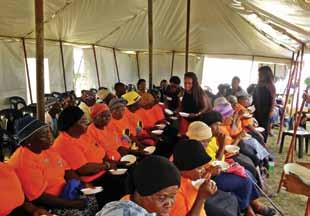
The licensee, Sozo Food, is a specialist functional food research, development and manufacturing company targeting nutritional deficiencies typically associated with lifestyle, illness, poor dietary habits, poverty and malnutrition. The company develops, manufactures and distributes scientifically researched, nutritional and functional food products for health promotion and disease prevention. Products are cost effective, affordable and accessible to the lower income consumer market.
The technologies developed at CPuT were showcased at the Innovation Bridge held at Gallagher Convention Centre. The technologies were well received, with a number of potential licensees and investors approaching us.

From publishing research papers to embarking on innovative studies, CPuT researchers have once again made the institution proud during 2017. Their efforts do not go unnoticed by the university, which planned to celebrate their activities at the annual Research Day. unfortunately, student unrest prevented the event from taking place.
We still acknowledge and congratulate the following top researchers:
AWARD ReCIPIeNT FACuLTY/ uNIT
Platinum Prof L hibbert education
Gold Dr RK Tengeh Business & Management Sciences
silver Dr D Gachago Centre for Innovative educational Technology
Bronze Prof JP Spencer Business & Management Sciences
AWARD ReCIPIeNT FACuLTY/ uNIT
Platinum Prof JC Cronjé Informatics & Design
Gold Dr AC de la harpe Informatics & Design
silver Prof J Gryzagoridis engineering
Bronze Prof R de la harpe Informatics & Design
AWARD ReCIPIeNT FACuLTY/ uNIT
Platinum Prof Te Matsha health & Wellness Sciences
Gold Prof I Masalova engineering
silver Dr P Welz Institute of Biomedical & Microbial Biotechnology
Please note this Industry Funding award was unfortunately omitted from the 2016 Research Report (for 2015 research activity)
AWARD ReCIPIeNT FACuLTY/ uNIT
Platinum Dr P Welz Institute of Biomedical & Microbial Biotechnology

The NRF is a national agency for research support and promotion. In addition to funding, human resource development and the provision of research facilities, the NRF annually invites researchers in all academic fields to apply for individual ratings.
The NRF rating categories
A Leading international researcher B Internationally acclaimed researcher C established researcher
P Prestigious awards Y Promising young researcher
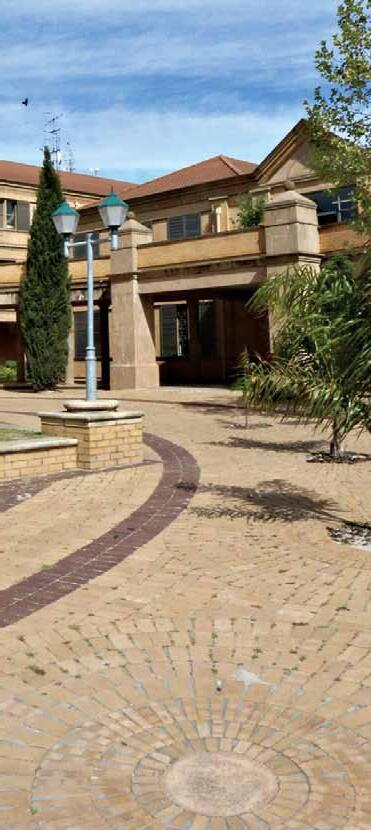
The vision of the Faculty of Applied sciences is to be the faculty of choice in science and Technology both nationally and in Africa as a whole. This is in line with the vision of the university, “to be the heart of technology education in Africa”.
In 2017, the faculty continued to meet and surpass goals that were set in 2016 for research, innovation and postgraduate education:
1. To promote a culture of research and innovation, and increase the research output of academic staff
2. To increase the number of graduate students, particularly Doctoral students, and substantially to increase their graduation rate
3. To improve the faculty’s staff profile and the capacity of staff to do research
4. To increase the number of research linkages and partnerships locally, regionally and internationally, especially within Africa
Staff in the faculty also attracted research funding from various funding agencies, such as the Cape higher education Consortium (CHEC), the Water Research Commission (WRC) and the National Research Foundation (NRF). The faculty graduated a total number of 19 research master’s and 3 doctoral students.
In 2017, 56% of the faculty’s permanent staff had doctoral degrees, and two women staff members obtained PhDs as part of the staff development programme. Once again, one of our researchers got promoted to the post of Associate Professor, to join the several Associate and full Professors who continue to demonstrate research expertise in their various fields.
Two researchers from the faculty were awarded an NRF rating in the C category, making a total of 12 Rated Researchers in the faculty, the highest number hosted by a single faculty at CPuT.
The faculty continued to support and grow its research niche areas:
Bio-resource engineering
Crystal engineering
Radiochemistry and Separation Science
Food Security (including nutrient security)
environmental and Toxicology
The CPuT Research Chair: Oceans economy and the associated proposed Centre for Sustainable Oceans have developed significant traction for the university in both the ocean governance and ocean economy arenas in the Southern African marine research space.

Bio
Climate
The Functional Food Research unit continued to shine and the Omega 3 Caro-e product is available in many pharmacies and supermarkets in South Africa. The product was approved for sale in Canada.
Several new local, regional and international linkages were established 2017, and the faculty continued to be active in the u6 Consortium. Most of our staff members attended local and international conferences, where they participated as keynote speakers or presented their research in the form of talks and posters.
I would like to thank the staff and students of the faculty for their contributions to making 2017 a successful year.
p102
2017 PUBLICATIONS (SUBMITTED TO THE DHET IN MAY 2018)
Please note that more information about this faculty’s research activities for 2017 can be found in the Focus Areas section of the Research Report
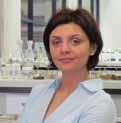
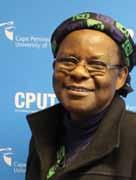

Prof Beatrice Opeolu is the new vice-president of the Society of environmental Toxicology and Chemistry (SETAC), Africa Geographic unit. She was elected by the council of the society in October, and will take over the leadership of the society in Africa in 2019. Prof Opeolu is an Associate Professor of environmental Toxicology and Faculty Coordinator, extended Curriculum Programmes, in the Faculty of Applied Sciences. She is the leader of the CPuT Climate Change & environment Research Focus Area. In the past few years, her research efforts have been focused on method development, monitoring, remediation (using biomaterials and nanomaterials), and performing ecological health risk assessments of endocrine disrupting chemicals (EDCs) in environmental matrices (water, soil and food). Currently, her research efforts are directed at the measurement and remediation of polycyclic aromatic hydrocarbons (PAHs), perfluorinated compounds (PFOS and PFOAs) and pharmaceuticals in environmental matrices, as well as their toxicities in ecological systems.
Prof Opeolu’s research efforts have established the occurrence of contaminants in food, water and soils. The next question to be addressed is “how harmful is the poison?,” since every compound is a potential poison, given a sufficient dosage. This is the rationale for the recent setting up of a laboratory for toxicity testing at CPuT. As an environmental Toxicologist in the research group environmental Chemistry, Toxicology and Remediation, Prof Opeolu established the laboratory to assess the possible human and ecological health effects of contaminants in various environmental matrices at their levels of occurrence. She will be driving this initiative within the group for the next few years. She collaborates with researchers nationally, regionally and internationally on different aspects of environmental toxicology and chemistry. Prof Opeolu also enjoys a strong network of researchers in her field through her membership of SeTAC.

She currently serves on the SeTAC World Council as a guest member, is co-chair of the SeTAC Global Membership Committee, and a member of SeTAC Global horizon Scanning Committee, Outreach and Marketing. For more information about SeTAC’s mission, governance, structure and activities, see www.setac.org.
A leading researcher at CPuT in the Faculty of Applied Sciences, Prof Victoria Jideani, has acquired two patents. This NRF-rated researcher has a patent for dietary fibre from the Bambara groundnut (Vigna subterenea) as well as a patent for probiotic yoghurt produced from a Bambara groundnut milk beverage and the method for the production thereof. The latter may lead to an exciting new business venture for the university.
“Indigenous knowledge (IK) associated with the Bambara groundnut (BGN) in SA is not documented,” she explains, adding that “despite the BGN rich IK and nutritional profile, not much is known about its nutraceutical potential.” She says that this knowledge system is at risk of becoming extinct because of the rapidly changing natural environment and fast-paced economic, political and cultural change. “There is an urgent need to document the IK and establish a relationship between it and the BGN nutraceutical. One of my publications on BGN paved the way for international collaboration between the South African Association for Food Science & Technology (SAAFoST) and the Institute of Food Technologists (IFT) in America.”
her article ‘Should the BGN remain underutilised?’ was published in the August 2015 issue of FST Magazine, which is published by SAAFoST, and subsequently republished in Food Technology (USA) by IFT as “Utilising BGN in value-added products” in 2016.
Prof Learnmore Kambizi, a lecturer in the Department of horticultural Sciences, is leading a team of academics and postgraduate students who aim to document Indigenous Knowledge Systems (IKS) and help herbalists establish, maintain and cultivate herbal gardens through hydroponics and tissue culture techniques at CPUT. Kambizi says, “we conduct a wide array of bio-assays on various medicinal plants (both pure and crude extracts) to assess their curing potential and toxicity.”
Prof Kambizi was invited to speak at the Western Cape Inyanga Forum in Mfuleni in November, where areas of possible co-operation among Cape Nature, the Department of health, academic researchers, local authorities and registered Traditional Medical Practitioners were discussed. To sustain this research project and support postgraduate training, he has been awarded funding of R1.5 million for three years by the NRF.
Steven Mapfumo, a doctoral candidate, emphasised the importance of the project, saying “Western medicine is marketed as the cleanest and most effective medicine, but previous generations that relied on plants lived longer when compared to the current generation.” Sibusiso Xego, another PhD candidate, who grew up around traditional healers, says, “we are taking the knowledge from the community to the lab and from the lab back to the community.”
Freely available indigenous fruits are a good resource for boosting your daily antioxidant intake, according to Department of Chemistry researchers. Ms Daniela Kucich and Ms Merrill Wicht have conducted a study to determine if local indigenous fruits could provide an alternative source of antioxidants. In their paper ‘South African indigenous fruits: underutilised resource for boosting daily antioxidant intake among local indigent populations?,’ they argue that a large portion of the population live below the poverty line and are unable to consume the required amount of seven portions of fruit and vegetables a day. “Advice on the importance of consuming a healthy, and at the same time affordable, diet needs to be provided by suggesting alternatives among indigenous plants that are nutritionally superior to ‘exotic’ fruits,” state the researchers.
As part of their study, Ms Kucich and Ms Wicht focused on ten indigenous South African fruits, which included the wild plum, wild olive, colpoon, christmas berry, crossberry, waterberry, tortoise berry, bietou, num-num and the sour fig. They evaluated the antioxidant activity of the indigenous fruits and compare it with Northern hemisphere blueberry
and cranberry controls. Their study found that by introducing servings of as little as 25g of wild plum, waterberry, num num or sour fig into the diet, the daily antioxidant intake can be boosted to within an acceptable range to support health. Wild plum scored highest on the Antioxidant Potency Composite index, with blueberry and cranberry ranked 4th and 8th, respectively.
The study found that these indigenous fruits are being used by communities for various purposes, including the treatment of ailments and the production of beverages. Others, such as the sour fig which ranked 12th in the study, is sold in open markets as dried figs or used for the production of jam. “As the results show, freely available indigenous fruits that have been traditionally used by rural peoples in SA have relatively high levels of antioxidant capacity and therefore constitute an untapped resource that deserves to be promoted more extensively in the community by health educators,” say Ms Kucich and Ms Wicht. “As affordable, yet nutritionally superior alternatives to the relatively expensive ‘exotic’ fruits, these could help in diversifying monotonous diets.”


This year, the university rolled out its Bachelor of environmental health degree, a four-year programme designed to equip its graduates with the appropriate skills to work as environmental health Practitioners. These specialised practitioners’ tasks are determined by legislation, and the scope of practice includes ensuring safe water supplies to communities, conducting health surveillance, disease control, occupational health and safety, food hygiene, and community development.
head of the programme, Prof Izanne human, says environmental health is an important field. “environmental health is about preventative health. You are enhancing the quality of life through preventative measures.” Prof human says that the process of implementing the course began several years ago, and today it is the only one of its kind offered at a higher education institution in the Western Cape. “This course is on a par with what is happening internationally. It is also internationally recognised,” she adds.
The course covers a range of specialised areas, and its graduates must complete a year of community service before qualifying. “The job opportunities in this field are wide. You can work for the government, industry or municipalities, as a consultant,” says Prof human. Prof De Wet Schutte, a leading researcher in the field and an academic at CPuT, says this well-designed course will promote preventative healthcare in SA.
Indigenous fruits are good for youStaff and students of the Department of environmental & Occupational Studies
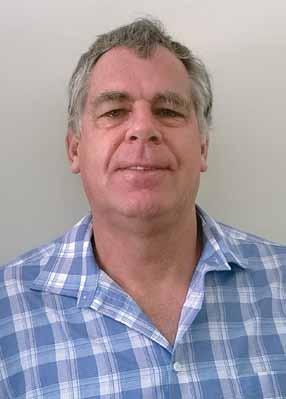
The academic year began on a high note with the arrival, in March, of Professor Godfrey Fulufelo Netswera as the substantive Assistant Dean (Research), a position that has for long been occupied by persons in an acting capacity. With a new sense of direction in research, a series of consultations were held with relevant institutional research partners, culminating in the development of a Faculty Research and Innovation Plan 2017-2021. Based on gaps identified in this plan, the Faculty Research Manager (Prof M O Dassah), developed the Faculty of Business and Management Sciences Staff Development Plan 2017-2018 and Postgraduate Throughput Improvement Plan 20172018, both of which represent a first in the history of the faculty. In October, we lost the services of Prof Netswera. The situation was exacerbated by the resignation of Prof Kamilla Swart, Prof Rozenda Hendrickse, Dr Bethuel Ngcamu and Dr Noluthando Matsiliza. The loss, within a single year, of five doctoral degree holders, three of whom were at the professorial level, has dealt a mortal blow to the research capacity of the faculty. More disturbing is the fact that the loss of Prof hendrickse, Dr Ngcamu and Dr Matsiliza has effectively wiped out the postgraduate supervision capacity of the Department of Public Management and Governance, creating a crisis in supervision of existing and future postgraduate students.
The faculty has two research centres, the Human Performance Laboratory (HPL) housed in the Department of Sport Management and the Centre for Tourism Research in Africa (CETRA). Please read the reports in the Focus Area section of this Research Report.
During the year, sixty-four students graduated with MTech degrees. This represents an increase of 56% over the previous year. Additionally, four doctorates were awarded. We will strive to improve on these figures during the next academic year.
Research Centres: Centre for Tourism Research in Africa p113 human Performance Laboratory p116
Research Chair: Wholesale & Retail Leadership p120
In 2017, four internationalisation projects were in operation:
ImPALA (Internationalisation and modernisation Programme for Academics, Leaders and Administrators) This project focuses on capacity building for higher education, with four task areas, namely, staff training, policy development and implementation, academic issues and mobility. CPuT is the joint coordinator for this project with the university of Antwerp, Belgium. The other partners are university of Limpopo, university of Venda, university of Fort Hare, University of Bologna (Italy), University of Graz (Austria), Utrecht Network, Academic Cooperation Association (ACA) (Belgium, associated partner) and IEASA (South Africa).
CARNiVAL
A trans-continental network of partners examining ‘Why Mega events Fail to Deliver Sustainable Legacies’, this project also seeks to identify best practices which enable potential impacts to be realised in light of hosting such events. This project sees CPUT partnering with Coventry University (UK) (applicant/partner), Federal University Rio de Janeiro (Brazil), North Carolina State University (USA) and Technische Universität München (Germany).
CAsO Project
A Caring Society – Care for the Caregiver Programme. CPuT and the Western Cape College of Nursing lead this project, which is aimed at building a sustainable patient partnership. Other partners are uCT and uWC.
Please note that more information about this faculty’s research activities for 2017 can be found in the Focus Areas section of the Research Report
LaTFURe (Learning and Teaching Tools Fuelling University Relations with the economy)
This project, which started in February, runs in Mozambique and South Africa. Foreign partners are Donau university Krems (DUK) in Austria, and Duale Hochschule Baden-Wurttenberg University of Applied Sciences (DHBW) in Germany (DHBW). Local partners are UWC and CPUT.
A total of 30 members of the faculty went on international visits, while the faculty hosted 22 international visiting academics and a delegation of a further 22 from Baden Wurttemburg. In order to ensure that mobility is a reality for our members of staff, five Mobility Teaching and Training exchanges funded by Erasmus+ have been established with European Union partners, while one is still to be approved.
• University of Economics Bratislava (Slovakia): Staff (Teaching and Training Mobility, 7 days)
• Romanian American University (Bucharest): Staff (Teaching Mobility, 7 days)
• University of Abertay (Dundee, Scotland, UK): Staff (Teaching and Training Mobility, 17 days)
• Odisee University (Belgium): Staff (Teaching Mobility (7 days)
• Dortmund (Germany), International Week: Staff (Teaching Mobility, 7 days)
• Lycee Dumas (Strasbourg, France): Staff and Student Mobility, 17 days) (pending approval)
ConfCom funded 17 staff members and 2 postgraduate students to participate in international conferences.
The faculty hosted Dr Rebecca Tumwebaze, a ugandan, on a research exchange visit initiated by Prof Netswera in October. During her stay, Dr Tumbewaze conducted two workshops for postgraduate students and held daily one-on-one consultations with them. Additionally, two staff members were funded to visit overseas universities for research collaboration.
Five supervisors obtained funds to support research undertaken by seven master’s students.
In line with the faculty’s drive to improve postgraduate throughput rate, a series of research-related workshops were conducted during the year, including: Topics and Proposal Writing (July), Writing for Publication (July), Questionnaire Design (September), Research Methodology (October), Postgraduate Colloquium (October), Postgraduate Conference (October), Year-end Closing Consultative Workshop (November).
The Faculty ethics Committee, chaired by Dr Michael Twum-Darko, sits four times a year in order to facilitate the work of the institutional higher Degrees Committee. In all, 114 applications were submitted to and reviewed by the committee for ethics clearance (107 for postgraduate students, 5 for special projects and 2 for external projects). Of the 107 postgraduate students’ applications, 70 (about 59%) were approved. This points to the need to improve the quality of proposals through rigorous supervision and intensified postgraduate support workshops.
A total of 82 articles, books and chapters in books were published by members of the faculty. Of these, 50 were eligible for DheT subsidy while 10 were not, 7 were chapters in books, and 15 were conference presentations, including keynote speeches and technical reports.
PhD: english Language Teaching Rhodes university marawu s
Code-switching as a pedagogical strategy in classroom settings: The case of township schools in a South African metropolitan municipality
mPhil: Internal Auditing cum laude university of Pretoria Botha L

From vitamins to wine: evaluating the value added by internal auditing
An academic from the FBMS is teaming up with european universities in research collaboration projects for which funding will be solicited from the eu. Dr Michael Twum-Darko visited Slovakia in May, where he established partnerships during the 4th International Week of Erasmus+ Teaching Staff Mobility at the University of Economics in Bratislava (UEB). Dr TwumDarko says the event helped him to build relationships
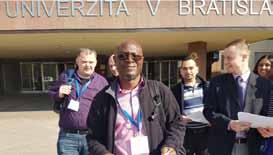
with teaching staff from ueB and other european universities in order to strengthen international networks and exchange ideas. “The participation is also for CPuT to meet the objective of supporting staff mobility as part of its modernisation and internationalisation strategy, and to recognise it as a component in any evaluation or assessment of the teaching staff member.”
Dr Twum-Darko has since embarked on collaborative research projects with the ueB and Niccolò Cusano university, Rome. The projects include research on e-Leadership and e-Readiness in the public sectors of SA and Slovakia. “A conceptual paper will soon be published as well as data collection in Bratislava City for comparative research.” Sustainable energy and Women empowerment are some of the issues that will be explored. Dr Twum-Darko adds that these issues require a substantial consortium to deliver outcomes aligned to the eu’s Sustainable Development Goals. he says that at the event he shared his experience with his european counterparts and received knowledge that is likely to impact on the research and collaboration agenda of his faculty and CPuT. “I hope this will be a source of inspiration to other staff members.”
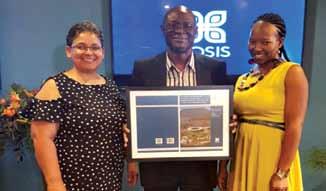
Prof Chux Gervase Iwu, Acting Assistant Dean: Research & Innovation, leads a collaborative research team that has been presented with this year’s emerald African Management Research Fund Award for their project titled ‘The wholesaleretail nexus: An assessment of the role of immigrant African wholesalers in the development of retail entrepreneurship in South Africa.’
Prof Iwu, who has won numerous accolades for his outstanding research and has presented papers at many international conferences, says the award “validates the necessity of researching emerging economies’ socioeconomic matters.”
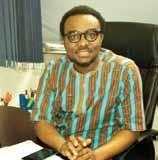
In addition to teaching entrepreneurship to students, Prof Iwu is assembling a team to gather data for the project. he’s pleased that the research is getting attention and will help debunk “the characterisation of migrants as desperate, dirty and dangerous (the infamous 3D euphemism) by the International Labour Organisation. The value of this study is such that the reader gets to know that immigrants actually add value to the mainstream socioeconomic dynamics of any nation.”
AOSIS (Pty) Ltd has been empowering Africa’s people by publishing open access scholarly journals, books and conference proceedings since 1999. In December, the International Conference on Business & Management Dynamics, hosted by the Faculty of Business & Management Sciences, together with the faculty’s Journal of Business & Management Dynamics (JBMD), were recognised by AOSIS for their outstanding contribution to open access journals.
Since 2015, the conference has attracted researchers, business leaders and postgraduate students to present research papers, conceptual papers, case studies and technical reports addressing contemporary and development issues in management, business, finance, tourism and information management, entrepreneurship and technology.
“This recognition is an endorsement of the achievement of my vision in establishing an international conference framework that brings together academic researchers and postgraduate students across African universities and beyond to share their research output, and to create sustainable conference proceedings that lead to a recognised and accredited journal for the faculty and the university,” says Dr Twum-Darko, editor-in-Chief of JBMD. “Professionally, it encourages me and the team to create a sustainable platform to deepen postgraduate research in the faculty and promote internationalisation and collaboration among African institutions of higher learning.”
Consistent with CPuT’s resolve to expose its students to the world of work, the Department of Management and Project Management teamed up with industry and challenged its students to come up with solutions to address Paarl Coldset’s waste problem. For presenting their solutions, three of the BTech student groups walked away with cash prizes of R48 000.
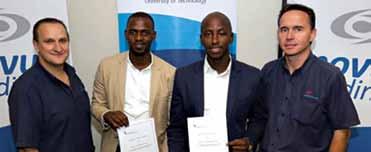
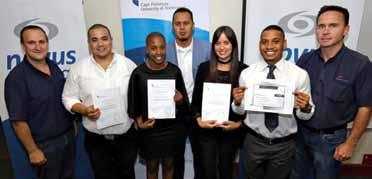
Paarl Coldset, one of the leading newsprint companies in the country, generates 1 200kg of plastic and 60-70 tons of paper waste every month. The students were therefore asked to devise ideas for re-using it (upcycling), said lecturer Mr Stanley Fore, who co-ordinated the project with lecturers Ms Nobuhle Luphondo, Mr Jephita Matande and Mr Irshaad Desai. “The project enabled students to generate feasible solutions for upcycling waste to create a secondary profitable business with limited capital expenditure, and at the same time promote academy-industrial partnership.”
To encourage participation and innovation in the project, last year the department divided its BTech students into about 40 teams which were awarded marks in various subjects for the related tasks they executed. After the groups presented their solutions early this year, an adjudicating panel comprising academics and Paarl Coldset management awarded cash prizes as follows:
• First prize of R24 000 to the group which looked into producing recycled pencils
• Second prize of R16 000 to the group which explored generating electricity
• Third prize of R8 000 to the group which investigated producing sanitary towels
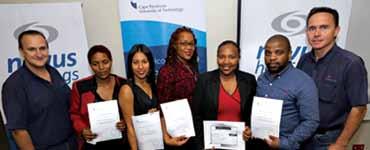
“We achieved our goal of giving the students a chance to link theory with industry and we hope that other companies will come on board,” said Mr Fore.
Aifani Tahulela, a Research Assistant in the Faculty of Business & Management Sciences, has been selected by the AeSOP Project to undertake PhD studies in Global human Development at university College, Dublin.

excited and enthusiastic, Ms Tahulela says that her “research will focus on sustainable resource management and is linked to Millennium Development Goal 12, which aims to eradicate poverty and improve waste management”. She hopes to use the knowledge and skills obtained to fulfil her long-term dream of establishing the continent’s first waste management centre to enable people to recycle and monetise waste.
Ms Tahulela believes her PhD will lead to collaborative work between the two universities. She thanks Ms Beryl Liebetrau for identifying the opportunity and supporting her scholarship application, as well as Prof harry Ballard, who supervised her Master’s in Public Management completed earlier in the year.
During 2017, the faculty’s research output and impact increased significantly, underlining its commitment to the improvement of the education system for learners in all educational contexts in south Africa.
There are four research units in the faculty
Centre for International Teacher Education (CITE) (NRF SARChl Chair): Prof Yusuf Sayed Literacy Development and Poverty (CPUT Research Chair): Prof Rajendra Chetty
Work-Integrated Learning (WIL) (NRF SARChI Chair): Prof Christine Winberg
Work-Integrated Learning in TVET Colleges (ETDP SETA Research Chair): Prof Nothemba Nduna
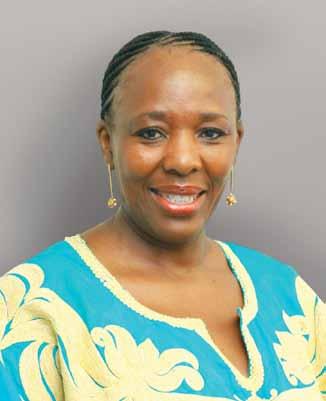
each of the four units has contributed significantly towards the faculty’s research profile. The CITe unit’s research focuses on teacher education policies, teacher accountability and professionalism, social cohesion in education and initial teacher education. Its research encompasses five countries with the collaboration of several international and local universities and international researchers.
The Literacy Development and Poverty unit seeks to acquire deeper understanding of how learners learn and teachers teach literacy in disadvantaged contexts, with the aim of developing a knowledge base on literacy practices and challenges in socio-economically disadvantaged primary schools in the Western Cape. The project is on track with regard to the provision of empirical data on the ways inequality intersects with divisions of race and class in schools on the Cape Flats. The unit collaborates with the DheT as well as the Independent examinations Board.
The rationale for the WIL unit is to build knowledge in professional, vocational and technical education. This includes traditional professional programmes, as well as new progammes aimed at preparing candidates to engage meaningfully with the world beyond the university. This unit has hosted visiting scholars from the universities of helsinki, Sydney and Twente.
The WIL in Technical and Vocational education and Training (TVET) Colleges unit conducts research on vocational education, including RPL, to understand TVeT college staff’s current WIL practice and WIL staff development needs, for the purpose of addressing such needs through the provision of high-quality WIL components for a range of new heQSF-aligned qualifications. The unit focuses on TVeT staff capacity development programmes, as well as on RPL best practice models for new students at CPuT. The unit aims to contribute to knowledge in vocational education through partnerships between uoTs, the eTDP SeTA, and TVeT colleges.
A number of joint publications have resulted from the research in these units in terms of articles, books and chapters in books and conference proceedings. Several staff members and master’s and doctoral students are involved in each of the units.
Faculty staff members also published the results of their own research projects. Several staff members were invited as keynote speakers at leading conferences, and hosted national and international researchers through the Research exchange Programme and other research partnerships. Many more delivered papers at national and international conferences.
Research Chairs: Centre for International Teacher Education (CITE) (NRF SARChI Chair) p106
Literacy Development and Poverty (CPUT Research Chair) p108
Work-Integrated Learning (WIL) (NRF SARChI Chair) p110
Work Integrated Learning in TVeT Colleges (ETDP SETA Research Chair) p111
The chair of one of CPuT’s seven research focus areas (Human & Social Dynamics), Prof Janet Condy, is one of four NRF-rated researchers in the faculty.
The faculty wishes to acknowledge and express its appreciation to the following CPuT units for supporting its continued growth:
DVC: Research, Technology, Innovation and Partnerships Research Directorate
Strategic Initiatives & Partnerships Technology Transfer & Industrial Linkages
Thirteen of our master’s students and three Ded students obtained their postgraduate degrees this year.
Please note that more information about this faculty’s research activities for 2017 can be found in the Focus Areas section of the Research Report
Prof Rona Newmark hoD: Foundation Phase Mowbray Campus
Prof sara Anthony hoD: Foundation Phase Wellington Campus
master of education
CPuT
Joseph J
Mathematics teachers’ experiences of the influence of the changing curriculum on their professional practice
PhD: education uWC
sonn B
Teachers’ understanding of social justice in rural education schools in the Overberg education district in the Western Cape: A grounded theory approach
Dr Agnes Chigona, an academic in the Faculty of education, says her recently awarded C2 NRF rating recognises that her research work impacts on the country and beyond: “It means I am acknowledged as an established researcher with some international recognition for the quality and impact of my research publications.”
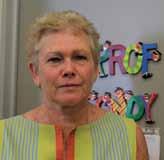
Dr Chigona’s research focuses on the adoption and integration of Information Communication Technologies (ICTs) into curriculum delivery. “The quality of the NRF rating places the Faculty of education in the spotlight as such ratings attract both local and international collaborators.” She adds that NRF ratings also increase the credibility of the faculty, hence boosting the confidence of the community it is serving.
Besides the local collaborations she has had over the past five years, Dr Chigona is also enhancing her international collaborations, where she is working on comparative studies in order to expand the empirical remit of her research. “I would like to approach issues of trans-national concern, such as ICT integration in teaching, through bringing local evidence to comparative international studies. I think such studies would be of great benefit to both local and international audiences.”
Dr Chigona encourages other researchers to choose a research focus and increase their research publications. “Those who have published widely need to be courageous and subject themselves to the NRF evaluation and rating process. The reviews from such a process are always beneficial to the researcher as they provide insights into how to enhance the quality and impact of the research trajectory.”
Prof Janet Condy, an academic in the Department of General education & Training, was awarded an NRF C2 rating in March. The rating is awarded to established researchers with a sustained record of productivity in their field of study and who are recognised by their peers as having produced a body of quality work, the core of which has coherence and attests to ongoing engagement with the field. Researchers must also have demonstrated the ability to conceptualise problems and applied research methods to investigate them. “The fact that an external objective body acknowledges and recognises my research contributions is remarkable and an honour,” says Prof Condy.
her rating is valid for five years, and Prof Condy says that during this period she will extend her research to internationally-published journals. “My core research areas are literacy and inclusive education, particularly in challenging socio-economic conditions,” she says. “Literacy is a common thread throughout my research papers where I attempt, proactively, to inform policy makers, teachers, researchers and higher education institutions about creative ways to address illiteracy amongst our students, simultaneously engaging with issues of social justice.”
Prof Condy is currently collaborating with the Stellenbosch Institute of Advanced Studies on the ‘Being human Today Project’, a documentary that will reflect on the digital stories of final year education students over the past five years. “This documentary will be viewed both at CPuT and in public forums, revealing the social injustices our students experience.”
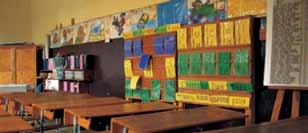
In partnership with TUT, the Aga Khan University of Tanzania and Oxford university, CPuT has launched a project that uses assessment to improve teaching and learning in schools. Funded by the UK’s Economic and Social Sciences Research Council (ESRC), the Assessment for Learning in Africa (AfLA) project aims to provide equitable opportunities for successful and sustainable teaching and learning in the Foundation Phase through supporting teachers in their assessment practices. The purpose of the AfLA project is to enhance and support teachers’ use of classroom assessment to improve the learning of numeracy in the Foundation Phase in disadvantaged schools.
Agnes Chigona has been awarded a C2 rating by the NRF
The project will be piloted over a period of two years in the following primary schools in the Cape Winelands education District: Amstelhof, Alfons, Langabuya, Dalubuhle, Nieuwe Drift and Nederburg. Addressing a seminar during the launch on the Mowbray Campus in February, Director of CPuT’s CITe, Prof Yusuf Sayed, said that a collegial partnership was formed between the district office and CPuT and that all affected stakeholders are looking forward to the collaboration. Prof Sayed noted that in this instance the programme being implemented is based on ongoing research. Prof
Therese Hopfenbeck (Oxford University) and Prof Gordon Stobart (University of London) addressed the seminar on the international dimension of AfLA and international perspectives on assessment, respectively. TUT’s Prof Anil Kanjee said the project builds on research about the crucial role assessment plays in learning. Dr Brian Wilson, head of Curriculum Co-ordination in the Cape Winelands education District, stressed the need to progress from ‘assessment of learning’ to ‘assessment for learning,’ and ultimately ‘assessment as learning’.

Two academics in the Faculty of education have contributed two chapters to a textbook that introduces prospective teachers to children’s literature and details how children can be encouraged to become enthusiastic readers. Dr hanlie Dippenaar and Dr Candice Livingston were recently part of a joint collaboration with uP in the writing and publishing of an undergraduate textbook for the teaching of children’s literature. The textbook, Introducing Children’s Literature: A Guide to the South African Classroom, was published by Van Schaik Publishers. The book, which comprises 11 chapters, has been prescribed for first-year students in the english Department on the Wellington Campus.
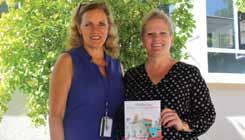
“A lot has been published on children’s literature but little has been published on how it is to be introduced within the South African classroom context. This book deals with where literature fits in within the teaching and learning environment in the classroom,” says Dr Livingston. “It looks at how care-givers, teachers and parents play a role in the educational development of learners.” She adds that the book also addresses the question of teaching in the context of a decolonised curriculum as demanded by the #feesmustfall movement. her chapter deals with types of children’s literature, while Dr Dippenaar’s looks at the historical development of the genre in SA in english, Afrikaans and IsiXhosa, with particular reference to oral traditions.
Dr Oscar Koopman, a lecturer in the Faculty of Education, has written his first book, Science Education and Curriculum in South Africa. The book, which explores the significance of power in the historical development of the physical science curriculum in South Africa, is available in university libraries worldwide and will be published in other languages, alongside other books penned by curriculum specialists, as part of the Curriculum Studies Worldwide Series.
“The book is an endeavour to come up with new ideas for curriculum development that are more meaningful and appropriate for South African learners and university students,” says Dr Koopman. “We need more curriculum theorists in South Africa, especially in science education, because most of the time we’re looking to the West and europe for the design and development of curricula.” he adds that he wrote the book in order to share with the rest of the world locally produced knowledge in science education.
All the chapters adopt a phenomenological approach to the lived experiences of teachers in South Africa. “The book makes an argument for phenomenology as a philosophy for teaching in which science teachers can focus more on embracing the use of the senses in the classroom.” After publishing research articles in prestigious journals locally and abroad, last year Dr Koopman decided to author his debut book. The monologue was printed and published by Palgrave MacMillan in America in October. It was edited by two of the foremost curriculum scholars in the world, Dr William Pinar from university of British Colombia, and Prof Janet Miller from New York university.
Following the success of his debut book published earlier this year, an academic in the Faculty of education has achieved the remarkable feat of publishing a second book in September. Dr Oscar Koopman completed Science Education and Pedagogy in South Africa during a six-month spell of sabbatical leave. It has been published by Peter Lang in New York.
The multidimensional book explores new teaching methods and looks at various aspects of science teaching and learning. “I am very honoured to have published with Peter Lang Publishing and be reviewed by Dr William Pinar, who is often described as one of the greatest curriculum scholars in the world,” says Koopman. “Publishing with Peter Lang is not easy because he’s a world class publisher for top academics in the world.”
The book’s main focus is on how to improve the quality of the teaching and learning of science in a multicultural context, given the quest for a decolonised curriculum in SA. “I argue that before we tackle the problem of decolonising the curriculum, we first have to obtain empirical evidence of how the psyches of teachers were affected by the legacy of apartheid education.”
This is a solo project with the exception of the contribution of a chapter by CPuT alumnus, Dr Paul Iwuanyanwu, who recently completed his PhD at UWC. Dr Koopman is working on another book which will be released early next year.
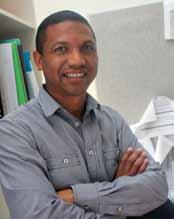


Research and innovation in the Faculty of engineering are aligned with key institutional and national focus areas, including satellite engineering, energy, water, Infrastructure, Advanced manufacturing, environment, and engineering education. Two research chairs have been established, in satellite engineering and energy.
The Faculty of engineering covers a broad range of research disciplines across various research centres and units. There are two institutes and two TIA-sponsored technology stations, all equipped with state-of-the-art facilities and technology.
The research centres include: (i) the Centre for Substation Automation and energy Management Systems, South Africa’s one and only fully up-to-date substation automation laboratory that offers specialised training, research and development in new technologies that will improve power systems in South Africa; (ii) the Flow Process and Rheology Centre that solves problems relating to the flow of industrial fluids ranging from mining slurries, paste and thickened tailings, to explosive emulsions, foodstuffs, pharmaceuticals, fluid concrete and cosmetics; (iii) the Centre for Community Water Supply and Sanitation, which promotes sustainable water supply and sanitation services, contributing to the sustainable delivery of water and sanitation services to communities; (iv) the Centre for Distributed Power and Electronic Systems; (v) the Product Life Cycle Management Competency Centre which provides cutting-edge product design, simulation and life-cycle
management; and (vi) the Centre for Instrumentation Research.
The two research institutes are: (i) French–South African Institute of Technology, the region’s premier nanosatellite programme, which has developed Africa’s first nanosatellite, ZACuBe-1, and is currently developing what will be the most advanced South African CubeSat to date, ZACUBE-2; and (ii) the Energy Institute.
The two technology stations are: (i) the TIA Adaptronics and Advanced Manufacturing Technology Laboratory that is a specialised national manufacturing, research and educational resource centre for adaptronic technologies in South Africa; and (ii) the Clothing and Textiles Technology Station that provides innovation support, services and short courses to help the clothing and textile industry to become more competitive.
In addition to the above, the South African Renewable energy Technology Centre is the first nationally funded centre to specialise in industry-related and accredited training for the entire renewable energy industry, including short courses and workshops.
CPUT is extending its global network of partners, thanks to the Erasmus+ International Credit Mobility programme. Over the next five years, CPuT and the Yildiz Technical University (YTU) in Turkey will participate in a mobility agreement, which is earmarked to strengthen and expand research and innovation in the fields of Substation Automation and Energy Management Systems and Control Systems Engineering. The Erasmus+ International Credit Mobility programme facilitates and funds short-term mobility projects for staff and students from european and other countries. The programme ties in with CPuT’s Internationalisation Strategy, by promoting international ties between institutions and creating opportunities for professional development, for both staff and students.
As part of the agreement, CPuT’s CSAeMS and YTu’s Departments of Control and Automation engineering and electrical engineering will embark on a programme of student and staff exchange. CPUT researcher, Mr Carl Kriger, who is the Erasmus+ Credit Mobility Programme coordinator for the Department of electrical, electronic and Computer engineering, says they are looking forward to the collaboration with YTu, which is a dedicated engineering sciences institution and one of the most prominent higher educational institutions in Istanbul. Mr Kriger says over the next five years CPUT students following courses in electrical, electronic and computer engineering will have the opportunity to complete courses at YTu that are not offered in SA. Researchers will also have the opportunity to spend up to two months at YTu and work alongside their counterparts.
Prof Seref Naci engin, head of the Control and Automation engineering Department in the Faculty of electrical and electronics engineering at the YTu, says the programme will commence next term with two CPuT doctoral students expected to spend a semester in Turkey, while three doctoral students from YTu will conduct research and training at CPuT. Prof engin, who recently visited CPuT with a delegation from the Turkey-based institution, says there are numerous existing projects on which the two institutions can collaborate. “We would also like to start new research projects, with the goal of producing research publications,” he says. Prof engin, who collaborated with CPuT in 2008 on an NRF-funded research project, says he hopes that it will be possible to extend the agreement.

CPUT extends its global network of partnersA delegation from Yildiz Technical university in Turkey with CPuT academics and management
Research Institute: French–South African Institute of Technology p80
Research Centres: Africa Space Innovation Centre p82
Centre for Instrumentation Research, including Quantum Physics Research Group p93
energy
2 6 3 7
Research Institute: energy Institute p87
Research Centres: Centre for Distributed Power & electronic Systems p88
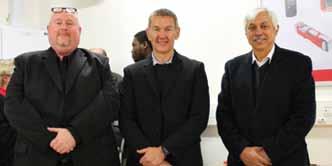
Centre for Mechanics & Technology p91
Centre for Real-Time Distributed Systems p92
Centre for Substation Automation & energy Management Systems p93
Research Centre: Flow Process and Rheology Centre p127
Research Group: Nanomaterials Group p129
Technology stations: Adaptronics Advanced Manufacturing Technology Laboratory p123
Clothing and Textiles Technology Station p125
Research Centre: Product Lifecycle Management Competency Centre p135
Please note that more information about this faculty’s research activities for 2017 can be found in the Focus Areas section of the Research Report
SA’s future technicians will soon be training in state-of-the-art laboratories, thanks to a partnership between CPuT and engineering industry specialist RS Components. RS has sponsored equipment to the value of R250 000 to be used in the project labs run by the Department of electrical & electronics engineering. “The four project labs will be used by over 450 students annually to learn about electronics, mechanical and electrical engineering. The students will get the opportunity to learn about and work with actual engineering equipment by doing various assignments and projects according to their course curriculum,” said Mr Ben Groenewald, head of electrical engineering, at the launch of the labs.
The equipment supplied to the labs is from RS’s private label range, called RS Pro, and includes top-of-the-range components that students can expect to encounter in a future workplace. Mr Brian Andrew, GM of RS Components SA, says that a partnership with CPuT was a natural fit. “Being the global distributor for engineers, it made sense to partner with CPuT as they are developing the next generation of engineering technologists who are going to be required to be multi-skilled across disciplines. We wanted the students to have access to the necessary tools and equipment so that they could put the theory they are studying into practice and have a taste of what the professionals use. Our RS Pro range matched the requirements of the labs by having great quality and performance while being affordable. We are extremely excited to see what these young engineers will be cooking up in the labs.”
Mr Groenewald adds that “Investment like this illustrates industry’s increasing involvement in the education of engineers, and for that we are very grateful.”


A willingness to tackle difficult topics and include creative influences in his lectures have earned a CPuT lecturer an important teaching award. Mr Siddique Motala, Senior Lecturer in the Department of Civil engineering & Surveying, was pronounced a National excellence in Teaching and Learning Award winner for 2017, and formally received the award at a gala ceremony in November.
The award is made on behalf of the Council on Higher Education (CHE) and the higher education Learning and Teaching Association of South Africa (Heltasa), and recognises the unique contributions that winners make in their classrooms.
Mr Motala was also awarded the Faculty of engineering’s Teaching & Learning Award in 2016, and credits his achievements to an interest in exploring more than just quantitative teaching methods. “In engineering, there can be a split between the hard sciences and the soft, which is the part that would be more interested in aspects like ethics. This could translate into a situation where ethical considerations are simply a box to tick. ultimately to me, a surveyor doing their job ethically is doing their job properly,” he says.
In an effort to encourage his students to explore more creative solutions, Mr Motala doesn’t shy away from discussions about race, religion, class and even the #feesmustfall debate. Additionally, creative avenues like history, art and a deliberate focus on Africa make his students relate to one another in innovative ways. “It’s unfortunate that our local students will often be able to point out New York or London but not Benin or other African countries, which has presented an opportunity for foreign African students to take the lead in class,” he says.
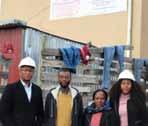
As part of its Mandela Day initiative, the Faculty of engineering launched a donation drive to raise funds to renovate an overcrowded local orphanage. having started with three orphans in Nyanga in 1994, emasithandane Children’s Organisation is now home to 29 vulnerable children. The orphanage consists of three very small bedrooms in addition to a few common rooms. emasithandane not only meets the children’s basic needs such as clothing, shelter, education and food, but also offers them a nurturing environment, which facilitates their personal growth and holistic development in the face of extreme odds.
The Engineering Faculty’s Mr Luvuyo Kakaza says that they decided on an institution which caters for children’s needs out of a desire to instil a sense of hope and convey a message that there are people who care. Speaking at a presentation in June, he said, “Today’s the launch of the project to raise donations for renovations and upgrades at the home, including creating study areas. We want to create a safe environment which is also conducive to learning.” There was also a Fun Run/Walk which took place in July.
Ms hazel Maposela, Finance Officer at emasithandane, thanked CPuT for the gesture and said it addressed some of their challenges such as lack of safety and overcrowding. She added that the home needs funds to pay salaries to its staff complement of nine employees as it only receives donations for food.
A training centre designed to equip underprivileged people with the skills essential to the energy industry has been launched on CPuT’s Bellville Campus. Through the use of its didactic equipment and intensive vocational training, junior and senior technicians in the fields of electricity will now enter the work environment with advanced practical skills. Schneider electric, a global company specialising in energy management, will be deploying its teachers from around the world to provide advanced training on various topics of interest such as entrepreneurship, and using its Access to energy programme as a vehicle to create employment in communities. “Through this programme, Schneider electric provides innovative green solutions that create access to energy in communities where people are living without access to energy,” said Mr eric Leger, local company president.
The centre is part of a national network of five training centres called the French South African Schneider electric Education Centre network (F’SASEC). F’SASEC forms part of Schneider electric’s sustainability strategy to train electrical artisans from disadvantaged backgrounds with the ultimate goal of creating employment. Prof Alexandre Sebastiani, F’SASeC Director at VuT, said the network allows for TVeT College graduates to enrol for short courses at CPuT to add to their knowledge, as well as for CPuT students to go to the College of Cape Town to learn more about practical work. Mr Ben Groenewald, head of CPuT’s electrical engineering Department, says that he is proud of the partnership involving Schneider electric, the French Ministry of education, CPuT and the College of Cape Town.
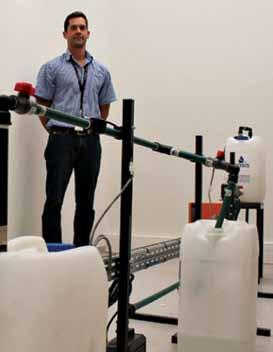
“There is a need for an automatic early detection method of water leak detection within a water distribution network,” he says.
“These leakages waste money, cause severe damage to the surrounding area and infrastructure and pose a potential risk to public health.”
Mr Mostert says current leak detection methods such as looking for wet patches of ground above pipes, are not adequate. To prevent water loss, he developed a software algorithm that makes use of flow measurements within a simulated water distribution network to detect leaks. As part of the project, a rig simulating a mains water distribution pipeline was constructed, with an inlet and outlet flow sensor to detect the quantity of water entering and exiting. Through the use of a micro-controller unit and specialised software, the flow measurement data is transmitted to a central monitoring station (PC) over a wireless sensor network and captured into a database.
“The basic idea is to make use of the volume balancing method, whereby the current flow measurements are constantly compared to a normal threshold. Once a deviation from these conditions is detected and is present for a certain amount of time, the algorithm will signal an alarm,” says Mr Mostert. The alarm system allows people monitoring the water distribution system easily to cut supply to a problematic bulk line and prevent further losses.
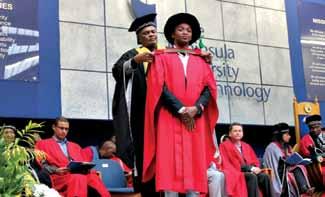
The day before he graduated as a Doctor of Chemical engineering, Dr Lukhanyo Mekuto was in Bloemfontein to receive a Research excellence Award for Next Generation Researchers from the NRF. Originally from Brown’s Farm, Philippi, Dr Mekuto (28) is the only child of a domestic worker, and the first one in his family to graduate from a university. he also has the distinction of being one of the youngest doctoral graduates that CPuT has produced. Dr Mekuto obtained his BTech in Biotechnology in 2011, and his MTech cum laude in 2014. he obtained his postgraduate degrees in record time, completing his master’s degree in 18 months and his doctorate in two and a half years.
his advice to those who want to excel in whatever field they choose is to determine who they are and what they want. “Distinguish yourself from others. The mistake we in the township make is that we want to go with the crowd. I decided in grade 10 that I was not going to do that anymore. I tell learners, ‘Define who you are and what you want. Once you’ve done that you have to make a conscious decision to go after what it is that you want,’” explains Dr Mekuto, who on weekends tutors children from his area in maths and physics. According to Dr Mekuto, the top excuse people give for not reaching their potential is a lack of funds. “I have come through the NSFAS system, which paid for my BTech up to my PhD, so in my view funding is no excuse.”
A final-year engineering project could save thousands of litres of water by helping municipalities to detect leaks in their water distribution lines. Mr Jean-Pierre Mostert, who recently graduated with his BTech in electrical engineering: Control Systems, has developed a low-cost water leak detection system, an innovative project that has helped him become the best performing student of the 2016 graduating class. Mr Mostert, who is now employed at Lesedi Nuclear Services, says pipeline leakages within the water distribution network of municipalities is one of the major contributing factors to water loss, with some recording losses of more than 1 760 megalitres per year.
Mr Mostert says this approach is low-cost as water distribution networks already have sensors that can be incorporated into the proposed system. “The final recommendation for this project will be that the existing flow sensors within the water distribution network of a municipality should be adapted so that data can be transmitted remotely over a network,” he says. “These sensors can then form a wireless sensor network and the early leak detection method can be implemented on the central PC. This will also allow for the data to be accessed remotely via an internet connection from any location.”
During 2017, the staff in the Faculty of health & wellness sciences confirmed their commitment to promoting excellence in teaching and learning as well as in research and innovation. The rich variety of research conducted in the faculty is responsive to the disciplinary and social contexts of the western Cape, south Africa, the continent of Africa, and the world at large. In these times of severe financial constraints, the faculty is determined to find innovative ways to continue to contribute to the national imperative to qualify practitioners who are appropriately educated for the health care needs of south Africa. This requires academic staff to be involved in disciplinary and education research to inform the content and pedagogy of our undergraduate programmes. As a result, the year under review saw departments introducing innovative teaching practices that included the development of simulation laboratories in the departments of Nursing, emergency medical sciences and medical Imaging and Therapeutic sciences. These high-technology learning spaces both enhance teaching excellence and serve as environments suitable for research by academic staff and postgraduate students.
Funding for staff to engage in research and improve their qualifications was accessed through the Research and Teaching Development Grants. The postgraduate qualifications achieved by academic staff and the employment of new staff members with postgraduate qualifications means that there is a growing number of researchers in the faculty. This is matched by a steady increase in successful internal and external funding applications for a range of research projects, and a subsequent rise in the faculty’s research outputs. There has also been staff capacity building beyond the acquisition of qualifications. For example, in the Department of Nursing, a researcher completed a course in Strengthening Postgraduate Supervision, and the head of Department established a leadership publication group during a two-day workshop.
Research in the faculty includes topics relating both to health and well-being and to the higher education environment. The focus of the latter is the work-integrated learning approach infused into all programmes in this
faculty. Our close collaboration with the SARChi Chair in WIL has allowed several staff members to conduct research for qualifications under her supervision and guidance. Of note is that the partnership facilitates research to improve the teaching and learning environment and builds research capacity in the faculty. Besides additional qualifications, this has resulted in presentations by several staff members at international conferences, including two staff members who gave papers at the Legitimation Code Theory (LCT) conference in Sydney, Australia. With regard to health and well-being, the faculty is pleased to report that important research has been conducted on current challenges in our country and communities. This includes research on topics such as violence (with a focus on women and children), professional ethics, diseases of lifestyle, community well-being and eye-care. Academic staff continue to be involved in scholarly activities and an ever-increasing number take up the roles of invited speaker at conferences, editor and reviewer for quality peer-reviewed journals, as well as serving on the scientific committees of international conferences.

During 2016, we recognised the need to increase enrolment numbers and to improve the rate of successful completion of postgraduate studies. To achieve this requires a multi-pronged approach and more attention to be paid to building research capacity in our undergraduate students, in order to prepare them for work in a knowledge society and encourage them to enter postgraduate studies. The phasing in of 4-year professional degrees in Biomedical Sciences, emergency Medical Sciences, Medical Imaging and Therapeutic Sciences and Nursing Sciences involves the structured inclusion of research skills in these undergraduate programmes. During 2017, much work was done on curriculum development in other departments, and we look forward to the time when all our graduates qualify with an awareness of the importance and place of research in their respective professions.
We had the largest number ever of registered postgraduate students in the faculty in 2017, and look forward to an increasing number of graduates. The faculty is proud of the steady flow of graduating postgraduate students (DRad, 1; DTech Biomed, 1; MSc Biomed, 4; MEMC, 1). Capacity building for postgraduate students, in particular those transitioning from the ‘old’ diploma and Bachelor of Technology qualifications, was also a focus during 2017. The year heralded the introduction of a centralised faculty research course for postgraduate students from all departments offering master’s and/or doctoral programmes. The planning and presentation of this seminar was the responsibility of the Research Coordinator. Faculty staff, including the Research Chair: Innovation in Society, were involved in the teaching. We also had the benefit of a researcher from the university of Karlstad presenting a module on innovative research methods. The feedback from this seminar was excellent and showed that the students in all phases of their research gained significantly from the offerings. It was
also shown that there is a need to present this as a staggered programme in order that our students can access the most relevant modules at times that align with their research journey. The research course will continue with amendments in 2018.
Building meaningful partnerships that contribute to teaching and learning as well as research is a component of the faculty’s vision. Such partnerships include regional, national, African and overseas collaborations. The promotion of international partnerships is evident in several departments, for example, in the various engagements of the Oxidative Stress Research Centre. They hosted several international exchange students from Belgium, were engaged in an international research initiative in hungary as part of an eu project, and had a staff member elected as the new President of the PanAfrican environmental Mutagen and Genomics Society at the 7th PAeMS conference in Cairo, egypt, in May of 2017. Another international partnership was established between the faculty and Karlstad University, Sweden. This collaboration has led to the successful acquisition of 3-year STINT/NRF funding for a research partnership that seeks to build research capacity and promote community transformation.
The Postgraduate Research Office with just two staff members, the faculty research coordinator and office administrator, is the central nerve of all activities related to staff and student research in the faculty. Through the hard work of those in this office and the chairpersons and committee members of the Faculty Research Committee and the h ealth & Wellness Sciences Research e thics Committee, the faculty is able to support and promote research and innovation and increase research outputs. During 2017 the faculty established an Institutional Animal Research e thics Committee in collaboration with the Institutional Research Institute IBMB.
Bio economy & Biotechnology
Research Institute: Institute of Biomedical & Microbial Biotechnology p63
Research Centre: Oxidative Stress Research Centre p66
Research Unit: Cardiometabolic health Research unit p76
Research Chair: Innovation in Society p133
Please note that more information about this faculty’s research activities for 2017 can be found in the Focus Areas section of the Research Report
Research achievements of particular note during 2017:
• The faculty is proud to have four NRF-rated researchers, namely, Prof J Marnewick (C1), Dr L van der Westhuizen (C2), Prof O Oguntibeju (C3) and Prof T Matsha (C1)
• Dr RM Modeste won an award from the STTI/ Chamberlain Center for Nursing excellence for her research presentation at the 44th Biennial Convention in Indianapolis
• Ms K Whiley, a student registered for our postgraduate Occupational health Nursing degree, scored the highest marks nationally and was awarded the Ian Webster silver medal by the South African Society of Occupational health Nurse Practitioners
Research is a team effort, and gratitude is extended to all the academic and administrative staff members and students in this faculty who contributed to making 2017 a successful year for research. The contribution of all the Research Centres, units and Groups is acknowledged. Some details of research in 2017 are highlighted below. Our appreciation is given to the DVC: RTI&P, and all staff in the Research Directorate and CPGS for their continued support for research in this faculty. At a Strategic Planning session in November, the faculty vision that was formulated included increasing the research and international footprint of the faculty, and we look forward to 2018 in anticipation of increased research, innovation and internationalisation.
Prof T
Research Chair: Innovation in Society
(A collaborative appointment with the Faculty of Informatics & Design)
2017 PUBLICATIONS (SUBMITTED TO
Associate Prof G Davison Department of Biomedical Sciences


Postgraduate degree obtained by a staff member
Gender-based
Strengthening the role and scope of Prehospital emergency Care by promoting theory, policy and clinical praxis.

experts in the field of radiography gathered for a symposium at CPuT in June, where some of the latest technology in the field was discussed. The theme of the symposium, which was hosted by CPuT’s Department of Medical Imaging and Therapeutic Sciences (MITS) and presented by Ge healthcare, was ‘Imaging for the Future’, and covered all four disciplines of radiography.
“The symposium allowed delegates, including some of our students, to see the new advances in technology and in practice,” says Mr Aladdin Speelman, head of the MITS Department. Among other things, attendees were exposed to the latest technology in breast imaging. Mr Speelman said one of the many interesting topics discussed on the day involved the use of medical marijuana for symptomatic relief in the management of oncology patients. Another item discussed was whether radiographers were aligned with their patients’ expectations in the new digital era. “This was an important topic as clients are much more informed than a few years ago thanks to Google and other technology,” says Mr Speelman.
Other topics that were explored on the day included new advances in CT imaging, theranostics in nuclear medicine, an introduction to musculoskeletal ultrasound and ultrasound fusion, and volume navigation.
CPuT has benefitted from a fellowship programme which gives African-born scholars in America and Canada the opportunity to collaborate with universities in six African countries. A collaborative application from Dr Kareemah Gamieldien of CPUT’s Department of Emergency Medical Sciences (EMS) and Prof Faadiel Essop from SU’s Physiological Sciences Department, saw them being awarded the prestigious Carnegie African Diaspora Fellowship. This accolade presented them with the opportunity to invite Dr Ismail Laher, a professor in the Department of Anaesthesiology, Pharmacology and Therapeutics at the university of British Columbia’s Faculty of Medicine, as a visiting academic to their institutions.

Dr Laher travelled to South Africa this year. he is collaborating with CPuT’s eMS Department and Su’s Physiological Sciences Department on teaching, curriculum, research and mentoring. Dr Laher said he was motivated to apply for the fellowship as he had been following Prof essop’s research and was keen on working with him and the department. Another motivating factor was the fact that the Western Cape is a hub for excellence in cardiovascular research. “There are some interesting opportunities here because of the changing nature of the population – obesity is on the increase and there are also other metabolic diseases. It’s an opportunity for sharing and exchanging ideas. I’ve come to learn from people here but I also have some ideas of how they can do things differently,” said Dr Laher.
Dr Gamieldien and Prof essop decided to collaborate on the fellowship because of its potential for research and education. Dr Gamieldien said that Prof Laher had provided her with valuable feedback on improvements that could be made in terms of helping students to better learn and understand physiology.
Opportunities for networking between various institutions in terms of research and teaching are also expected to flow from the initiative. Dr Gamieldien said the programme and collaboration were also in line with the vision for the Human Anatomy and Physiology in Emergency Care (HAPEC) endeavour, which was established in 2015 and strives to align anatomy and physiology with eMS.

eMS training at CPuT has received a major boost with the opening of a new immersive simulation centre, which can emulate real emergency scenarios to train students to treat patients in lifethreatening emergencies. The state-of-the-art immersive clinical simulation centre can replicate emergency scenarios such as road accidents, and will be used for learning as well as assessment purposes. eMS lecturer Mr John Meyer says that before students can do their work-integrated learning, the university has to ensure that they are competent to perform procedures on real people. “With simulation-based education, we provide a hands-on experience, where real-life situations are simulated for students to develop their skills. They can practice over and over again without causing any harm.”
A range of different scenarios can be pre-set for students, including the delivery of a baby. In this case the eMS Department has a birthing mannequin which can automatically deliver a baby, including having contractions and making sounds. “The simulation technician will set up the mannequin to a pre-set scenario and the lecturer can watch the student treat the ‘patient’ from the control room and also speak to the student.” The technology allows the lecturer’s voice to
be transmitted via the mannequin as the voice of the patient. “We also have an observation room to which we can live stream to the rest of the students and where a facilitator can facilitate discussion. everything is recorded on the server and this allows the students to review the video footage later.” Mr Meyer said an important part of the training was the debriefing process. “Students reflect afterwards on how they performed during the scenario and are given feedback on what went well or what went wrong and how they could better achieve the outcomes and objectives of the scenario. Students are enjoying the immersive training experience and we’ll be able to send out students who are safe and competent.”
The emergency Medical Services Department’s new immersive clinical simulation centre
International fellowship programme enhances teaching and researchSu’s Prof Faadiel essop, with visiting academic Prof Ismail Laher and CPUT’S Dr Kareemah Gamieldien
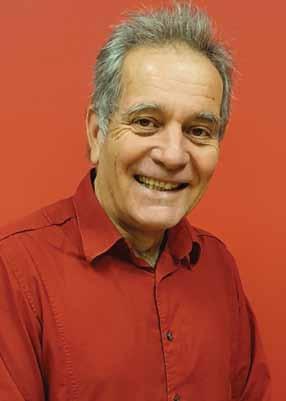
The year 2017 was one of consolidation for research at FID. we undertook a number of research and supervision workshops and continued working with our postgraduate support groups. Prof Retha de la harpe ran a group for women in research, Dr Alettia Chisin took care of DRAw, Dr De la harpe and Prof Tiko Iyamu ran groups for IT students and Prof Johannes Cronjé ran the TeRPs group from his home.
Our postgraduate efforts were further supported by summer and winter schools run by Dr Andre de la harpe. A threeday summer school in February was attended by more than 200 postgraduate students, mostly from the Business and Informatics & Design faculties, but also from others. A three-day winter school in June was attended by about 80 students from all the faculties. A two-day doctoral colloquium was attended by about 20 students from various faculties.
A three-day LeNSes Conference on the theme of Sustainable energy for All by Design was hosted by the faculty. Several workshops were attended and hosted for the eu horizon 2020 PARTY project, and staff from the faculty travelled to PACO Design Collaborative in Milan and the University of Leeds in the UK. Focus areas for discussion included community ethics, university-community collaboration, difficulties with partnering with indigenous organisations, stakeholder mapping, digital storytelling and internal collaboration.
Funding was awarded to FID by the Danish Agency for Science, Technology and Innovation for a bi-lateral network of activities, under the seventh call for the International Network Programme. Three week-long workshops were conducted (two hosted by CPUT and one by ITU) to explore ‘Situated co-exploration and design of networked mobile & pervasive digital technologies in support of out-of-clinic rehabilitation practices as part of everyday activities, as experienced in South Africa and Denmark’. The collaboration resulted in the submission of a funding application to the WhO to address TB non-adherence (when TB patients fail to adhere to their treatment regime, the result is drug resistance; we aim to improve their adherence using technology), and an NRF bi-lateral planning workshop to action the project deliverables and collaborations.
Other activities for the year included staff and student exchanges, international collaboration, local conference hosting, and new projects. The faculty also received several exchange students from european partners.
Our research and postgraduate output has shown steady growth.
I would like to thank the research staff under the leadership of Prof Retha de la harpe for their consistent hard work.
6 7
Research Centre:
p122
Design for sustainability
Research Chair:
Society p133
Research output
2017 PUBLICATIONS (SUBMITTED TO THE DHET IN MAY 2018)
Please note that more information about this faculty’s research activities for 2017 can be found in the Focus Areas section of the Research Report
New professor appointed
Prof T Thurner
Research Chair: Innovation in Society (A collaborative appointment with the Faculty of Informatics & Design)


Trainees of the ||Kabbo Academy based at !Khwa ttu, a San education and culture centre near Yzerfontein, were in high spirits recently when they celebrated their graduation. Spearheaded by the Research, Innovation & Partnership Department within the Faculty of Informatics & Design, CPuT’s involvement in this training programme involves such activities as workshops in print-making and digital storytelling.
Trainee Ms Sanna Kuiper (27) attributes her newfound confidence to the eight months she spent at the ||Kabbo Academy. “I was very self-conscious because my english wasn’t that good. What I’ve learnt here means a lot to me. I’ve enrolled for the tracker academy and will be staying here for another year,” says Sanna, who is from a community based in the Kalahari in the Northern Cape.
According to Ms Michelle van Wyk from the Research, Innovation & Partnership Department, the university was more involved in the Academy this year than ever before. “The partnership with !Kwa ttu started three years ago with a research project. It has now developed into an equal platform where our students learn from the trainees as much as they learn from our students.”

Ms van Wyk adds that graduation is the culmination of the trainees’ achievement over their eight months of training. “They are able to take what they have learnt into their communities, which are not only in SA, but also Namibia and Botswana.”
Ms Kuiper aspires to be a tour guide one day. The skills she will teach other youths in her community are body stress release techniques she has learnt at !Kwa ttu, which is also a hotspot for visitors to the Western Cape. Trainees get exposure to the tourism sector, but more importantly they learn about the San culture and heritage.
Mr Shaun Dunn, training manager at !Kwa ttu, sees the academy as a vehicle for building young people’s self-esteem. “It opens them up to new experiences and they acquire skills that can be used in sectors other than tourism,” he explains.
Visit the !Kwa ttu website at https://www.khwattu.org/ for more information about the ||Kabbo Academy.
how do you encourage students to care for others? According to 3D Design lecturer, Ms Veronica Barnes, you challenge your first-year students to take up a holiday project to knit toy bunnies for St Joseph’s home for chronically ill children in Montana, Cape Town.

“This project shows students how something small can make a big difference in another person’s life,” says Ms Barnes. “I would like it to become a tradition.” Some members of her mostly male class learnt to knit from YouTube videos, managing to produce an impressive total of 59 bunnies. One student even knitted finger-puppets to be used by the occupational therapy team at St Joseph’s.
The handover to the children had a real impact on some of the students, who “asked a lot of questions on the trip back to campus, and were thinking of other projects that could benefit others less fortunate than themselves.”
While there is an educational angle – in that one knits a flat square, which with clever folding becomes a three-dimensional rabbit – the project is really more about the heart. Such initiatives show that the design studio is a space in which students can learn a lot more than just a vocation.
Final-year Product and Industrial Design talent was showcased at the Annual Graduate exhibition in Woodstock in November. The exhibition, organised and designed by the students, provides an opportunity to celebrate CPuT talent and build the brand of the programme. The dazzling display included standing lamps, furniture, timber puzzles, product renderings, coffee pots and camera straps − some of which were available for sale.
The Product Design and Industrial Design postgraduate courses are for anyone interested in 3D Design – from physical objects found in daily life, to innovative systems and product concepts. The job opportunities available to graduates of this course include lighting design, set-building, furniture design and manufacturing.
CPUT helps train marginalised youthsMs Sanna Kuiper educates guests about the medicinal properties of garden plants Ashleigh Snyman, Michelle van Wyk and Jodi Wagenstroom Product and Industrial Design exit exhibition, attended by students, alumni and industry representatives
Interior Design student Ms Kriska Liebenberg recently won the 12 IZITuLO Design Challenge, prize money of R10 000 and a percentage of future sales from a renowned local furnituremaker for her nesting chair. Inspired by a bird’s nest, it was one of two designs entered into the prestigious competition by senior lecturer Ms Colleen Cocotos. Ms Safoora ebrahim, whose entry was among the 12 finalists, was the other CPuT student participating in the competition.

“I am completely ecstatic to have won such an amazing competition,” says Kriska, adding, “I could hardly believe they chose my design, considering how beautiful and innovative the other chair designs were.” The winner was announced at an event which showcased the finalists’ designs at the Leon at CCXIX showroom in Woodstock.
The competition brief required entrants to design a contemporary armchair, dining chair, occasional chair or bar stool, using, among others, fabric, timber, metal or wool. Describing her creative process, Kriska explained that she first decides on a theme, then develops “the initial concept through research and sketches, until the original idea transforms into a solid design”. She is confident that this award will open doors for her in the future.
An award-winning design by a CPuT graduate was one of 200 projects on display at the 2017 Global Grad Show, showcasing “ground-breaking works from the world’s leading design schools” during Dubai Design Week. My Tova, designed by Ms Nicky van den Aardweg, a 2016 Interior Design graduate, is a children’s backpack that unfolds into a padded stool and writing pad.

“The Global Grad Show brings together 92 of the world’s best design institutes from over 40 countries, so exhibiting here is no mean feat,” adds Ms Colleen Cocotos, a senior lecturer and programme coordinator in CPuT’s Department of Architectural Technology and Interior Design, who accompanied Nicky to Dubai.
In 2016, My Tova won a prestigious iF Public Value Student Design Award in the category “empowering the Individual” in Munich, Germany. “I feel so honoured that my design solution to a problem so common in developing countries is receiving recognition from my peers worldwide. Many rural children in SA are taught under trees because there is a shortage of classrooms. My Tova is a light, easily assembled solution to this prevalent problem,” says Nicky, who works as a Spatial Concept and environmental Designer at the International Trend Institute in Durban.

Third-year Graphic Design students have participated in a project that has not only extended their skills and experience but also helped to create awareness about water as a precious resource. Lecturer Mr edwin Peacock said the Graphic Design Department was recently approached by an NGO, The Watershed Project, to come up with a project for its first Fun Day in Paradise event, to be held at Paradise Park in Newlands. The event involved a day of experiential learning for young children along the banks of the Liesbeek River. Mr Peacock, who worked on the project with lecturer Mr Lionel Franciscus, said it gave students the opportunity to work on a “real life” project instead of one based on a hypothetical situation. “This involved a real client and it gave the students the opportunity to gain valuable experience while working in the field.”
The aim was to teach people about the importance of preserving the water in the park’s canal as well as about the current water situation. The students had to come up with imagery that “spoke to the children.” They came up with the idea of reverse graffiti and created their artworks on a section of canal wall. “They couldn’t use
anything toxic to create their artworks as the canal will at some point fill up with water again. This meant we couldn’t use paint. In the end we decided to use stones from the canal to create the images while at the same time cleaning the mould and dirt from the canal wall.” Mr Peacock said the project was a huge success. “The client was very happy and our students also learnt about giving back to communities through their work.”

chiwaree@cput.ac.za
In 2017, CPUT Libraries continued to develop various platforms to support the eResearch environment within the institution through a number of research data services, including:
• Continued development and maintenance of MediaTuM, a Research Data Management Platform currently being piloted by two research groups
• Subscription to Figshare, a cloud-based Research Data Management system
• Updating the Data Management Plan and incorporating it into the grant application process
CPuT Libraries are also assisting students and researchers with the storage and discoverability of their research on the DSpace CRIS platforms, namely:
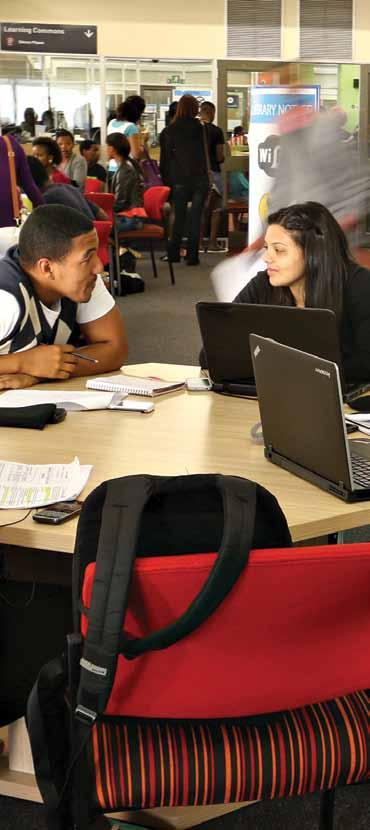
• Electronic Theses and Dissertations (ETD)X
• Digital Knowledge (DK)
• Open Education Resources (OER)
The DSpace platform is user-friendly and integrates with other systems, such as ORCID and PRIMO (the new Discovery platform) for seamless access and interoperability.
With an eye to both cost saving and access to resources, CPuT Libraries actively support Open Access through the implementation, hosting and support of a journal publishing platform (Open Journal System). The platform currently hosts three journals. Services also include information for publishing in OA journals and about questionable predatory publishing.
The Library further supports faculties, units and centres with research visibility and impact as well as metrics (Bibliometrics and Altmetrics) using tools such as Scopus, Publish or Perish and Mendeley.
Library staff members contributed to the research output of the university by publishing an article in a DheT accredited journal and presenting papers at international conferences and workshops.
As gateways to knowledge, libraries play an important role in the development of communities. This fact was recently highlighted when the CPuT Wellington Library, in collaboration with the Faculty of education and the Wellington Public Library, hosted a community outreach event at the Wellington Skills School in February. The event formed part of the South African Library Week themed “My library, your library.”
“Our goal is to expose learners to a library and show them what it offers and how it can contribute to their development,” says the CPuT Wellington Library manager, Ms Joanne Arendse. “We want to bring libraries into their hearts and lives.” As part of the outreach, CPuT education lecturers and students presented a woodwork skills development workshop, which aimed at showing learners the role that information can play in the process of constructing an item. CPuT Libraries also presented
an information literacy skills development group work session to show learners how to utilise information resources effectively, while the Wellington Public Library informed learners about the benefits of being a library member.
Acting principal of the Wellington Skills School, Ms Dorothea Albanie, welcomed the CPuT initiative and says that such collaborations are important for the development of learners. The skills school was established at the start of this year and provides learners who experience problems with learning the opportunity to develop their full potential. The school offers a range of subjects such as woodwork, welding, arts and crafts, agriculture and hospitality. Ms Albanie says CPuT is the first tertiary institution to reach out to the school, and she looks forward to building a strong partnership with the institution.


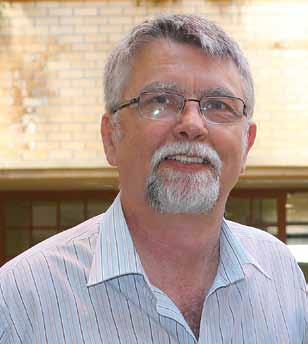
The Department of Institutional Planning has an Academic Planning & Institutional Research component and a hemIs component (responsible for the collection and validation of data submitted to the DheT).
The main functions of the Institutional Planning Department are to:
• facilitate the university’s strategic planning and academic planning processes
• facilitate the development of HEQSF-aligned qualifications
• conduct institutional research in support of planning and transformation
• coordinate the university’s HEMIS reporting
• manage the updating of the CPUT academic structure
• provide management information, including responding to ad hoc queries
• promote the standard of data quality within the institution
• maintain the necessary web infrastructure to deliver management information
• provide training to CPUT staff members on department-related matters
• participate in CPUT projects, as required
The vision of the Department of Institutional Planning is to be one of the leading decision-support units in higher education.
This vision ties Institutional Planning into the broader decision-making and planning processes of the institution. If the department is fulfilling its function effectively, it will be assisting the university’s management and planning processes to deliver.
One key to Institutional Planning’s achieving its vision lies in quality data, namely, collecting and verifying data, and making the data available to end users in a helpful way.
A second key to the department’s realising its vision is communication. The department tries to respond promptly to internal and external requests for assistance. It strives to make information available to users via the Web in ways that are flexible and can meet their changing needs.
Fundani supports research into teaching and learning across the faculties, and a number of CPUT staff members engaged in master’s and doctoral study (focusing on higher education) are currently supervised by Fundani academics. Fundani staff are sought after as external examiners for master’s and doctoral theses and as keynote speakers at conferences and universities.
The centre’s staff support research into h igher e ducation through collaboratively teaching with the three other Western Cape universities on research courses for staff (for example on the Cape Higher Education Consortium proposal writing course), as well as through an internal Scholarship of Teaching programme. In order to enhance their professional development as university teachers, we encourage CP u T staff to attend these.
e ach year, approximately R700 000 is disbursed to faculty members by Fundani in order to conduct classroom-based research, under the DVC: Teaching & Learning’s RIFTAL project. In 2017, projects submitted and approved for funding were diverse and ranged from curriculum redesign in Architecture and Planning to helping students learn threshold concepts in Science.
The annual university teaching conference (RITAL) was held in March, attracting 70 staff and 37 presentations. The topic was ‘Transitioning in and transitioning out: The context of transforming the he landscape’, focusing on the first-year student experience as well as on how students cope with later transitions between years and into the workplace. The keynote address on ‘Social justice in the university curriculum’ was delivered by Prof Aslaam Fataar from the e ducation Faculty at Stellenbosch.
Fundani staff also conduct their own research into teaching and learning in h igher e ducation, often in partnership with Faculty of e ducation staff, and the following research projects are currently running:
• Improving teaching and learning practices (including teaching support courses, student participation/engagement, innovations and the multilingual classroom)
• The professional curriculum, work-integrated learning and knowledge differences
• Student transitions and enhancing tutoring/ mentoring (staff interested in participating in these projects are welcome to contact Fundani)
Despite its small size, in 2017 the centre managed
Prof Monwabisi Ralarala
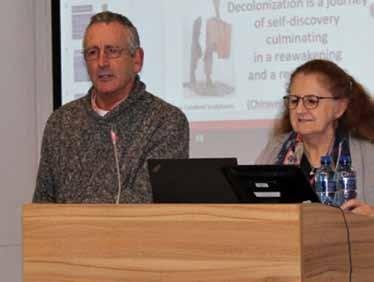
The thorny topic of decolonising university curricula was tackled head on during the annual Language Indaba in June. hosted by Fundani’s Language unit, this year participants explored the topic of ‘Decolonising the Language Curriculum’. Delegates at the Indaba included discipline specialists, curriculum officers, language specialists, academics, researchers and students in relevant fields.
Delivering the keynote address, UCT’s Prof Carolyn McKinney cited examples of how colonialism in education negatively impacts the linguistic resources of African people. Prof McKinney questioned whether parents of english- and Afrikaans-speaking children would allow their children to learn everything from Grade 4 onwards in isiXhosa as their Xhosa counterparts are compelled to do in english. She discussed various dominant language ideologies before offering the audience de-colonial approaches to language teaching.
Prof McKinney suggested multilingual class discussions, group work and learning materials as well as assignments requiring the use of more than one language and group to share resources. Prof Johannes Cronje, Dean of FID, discussed his approach to teaching and learning in communication, which allows students to interact with each other and himself, using Dashboard and other online forms of learning as well as innovative assessment methods. Mr Jabar Mohammed, DeafSA’s Western Cape director, explained the role of DeafSA and the challenges faced by the South African deaf community as well as what is being done to address them.
CPuT’s Dr Bernadette Millar argued that decolonisation is a journey of self-discovery, culminating in a reawakening and a re-orientation. Dr Millar said decolonising the mind involves a radical process of discovering the colonial master’s intention and undoing conditioning, normalisation, power and privilege.
to produce 9 research articles with a total credit value of 7 units (approximately 3.5 % of the CPUT total). Fundani produces the internal teaching and learning journal Paradigms. The 2017 edition (available online on the Fundani website) highlights research into innovative practices in higher education.
The centre was also responsible for organising three writing retreats benefitting approximately 35 CPuT staff in 2017. Research has shown that each retreat generates between three and four articles over a two- to three-year period. Staff are given either structured or unstructured opportunity to develop research completed into journal articles; some staff also work on education-related master’s and doctoral theses. Research conducted through Fundani, as well as writing facilitated by the unit, contributes significantly to improving teaching and learning at the university, which ultimately has a positive impact on student retention and throughput.

The Language Working Group and the Institutional Language unit launched the first ever multilingual touchscreen directory in September. The directory was designed and developed by iPoint, a company which specialises in developing touchscreen directories for shopping malls across South Africa. “The touchscreen earmarked for the engineering building appears to have the same features as those one would find in malls but offers much more than just directions,” says Mr Theodore Rodrigues, Acting Institutional Language Co-ordinator.
The collaborative role of content lecturers in the teaching of language and literacies was addressed at a Language Indaba held by the Language Working Group in collaboration with Fundani Centre for higher education Development’s Language unit. This CPuT initiative intends to develop a progressive dialogue with academics in the field of multilingualism in higher education and language development, in an effort to improve access to learning and contribute to effective teaching.
“All lecturers should [realise their] responsibility to contribute to language teaching for the betterment of their students,” says Ms Nomxolisi Jantjies, Xhosa Language Specialist at CPuT. “The multi-literacies students bring with them should not be seen as a challenge or hindrance but as a resource that they can tap into to gain access to the epistemologies of content-specific language.”
Prof Chrissy Boughey of Rhodes university maintains that curriculum decolonisation involves the inclusion of African content and thought, noting that the use of indigenous languages as media of instruction impacts the identity and well-being of students. Prof Sivakumar Sivasubramaniam, head of Language education at uWC, said that students are not just statistics but have a voice and should be heard.
This device promotes multilingualism by allowing end-users to engage with the device by choosing to search in their home language. Mr Rodrigues adds that the device also acts as a ‘language teacher’ by providing users with the equivalents of certain words in various languages. This intelligent device currently provides service in Afrikaans, english, isiXhosa, isiZulu and Sesotho.

“To fully embrace the concept of inclusivity within a multilingual context, other languages are being considered for the future. The possibilities of such an innovation are endless, and its launch should be celebrated as a step in the direction of promoting the linguistic rights of all South Africans,” says Mr Rodrigues.
The procurement of the directory is part of a multilingual signage project which aims to have signage on all of the university’s campuses translated into the province’s official languages.
maraisme@cput.ac.za
As part of the 2017 strategic plan, the hIV/Aids unit embarked on its third consecutive leadership conference, focusing on empowering young female students. The rationale for this was that young women bear the brunt of both hIV and gender-based violence. Reports have shown that South Africa has the highest rate of genderbased violence (GBV) in the world. A finding by the Medical Research Council has indicated that every eight hours, a women dies at the hands of her intimate partner (2012). Another disturbing fact is that over 2 300 young SA women aged 15 to 24 years become infected with hIV on a weekly basis, the highest rate of infection in the world (UNAIDS, 2012). The ‘blesser’ phenomenon is a huge contributor towards hIV and GBV in young women, making this age group eight times more likely to contract HIV than their male counterparts (HSRC, 2012), as well as being more likely to be exposed to GBV. We are of the belief that a holistic approach is necessary, whereby young women are developed through empowering interventions to enable them to make wise decisions.
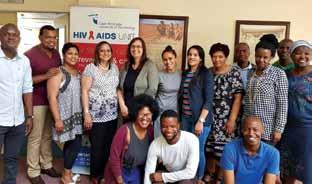


A working group was established, which drafted the Institutional Position Statement on Institutional Response to GBV, revised the Sexual harassment Policy and recommended the name change to GBV Policy.
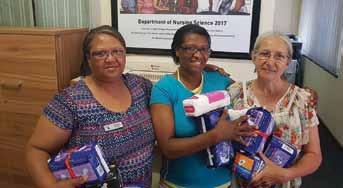
During the September 2017 Young Women Leadership Conference, over 150 of 300 participants completed an evaluation form at the end of the conference. One of the questions included on the form was, if we had to distribute sanitary towels on campuses, what their preferences for distribution points would be. An analysis was done of the evaluation forms and the response of female students indicated that Campus Clinic, Student Counselling and the hIV/Aids unit were the three preferred points for the distribution of sanitary towels.
In 2017, Higher Education Aids (HEAIDS) hosted their very first youth-focused conference. The event brought together close to 2 500 youths from across the country. Its focus was on empowering the youth of South Africa with knowledge and current information on the hIV pandemic and all related sexual risk areas. The conference served as a platform for young voices to be heard. CPuT was fortunate in being able to take three peer educators (Kuhle James, Nerissa Fortuin and Tumiso Mfisa) and eight SRC members to attend the conference.

Initiation of the HIV curriculum integration (HCI) programme resulted in the identification of two departments for the pilot project:
• Office Management Technology (OMT) – based on a historical relationship with the hIV unit. The subjects Business Administration I, II & III were found to be the most appropriate subjects to integrate hIV within the curriculum of OMT
• Information Technology Management (ITM) – because of the department’s participation in the 2009 Tabeisa project. The subject Information Technology Skills I (ITSK 10) was found to be the most appropriate subject
Pedagogy identified:
• How2bAidsAware was identified as the material to be used for curriculum integration

• Student Guide: Roadmap to Your Social, Mental and Physical Wellbeing
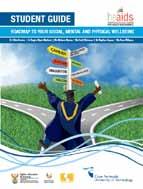

Three books for students about hIV/Aids and general wellness have been produced at CPuT and will be rolled out across higher education institutions nationally. The guidebooks were released during the hIV Curriculum Integration Book Launch in Durbanville in May. This initiative was a pilot project funded by the Higher Education HIV/Aids programme (HEAIDS), and its objectives include strengthening the capacity of lecturers to integrate hIV/Aids into university and TVeT college curricula, as well as proposing ways of addressing gaps regarding hIV/Aids issues in these curricula.
The hIV/Aids unit, in collaboration with Student Counselling, the Nursing Department and the office of the DVC: Teaching & Learning, made history by developing the first booklet of its kind in South Africa, Student Guide: Roadmap to Your Social, Mental and Physical Wellbeing. This interactive book can be used by university and TVeT college students not only as a guide to their holistic wellness, but also for hIVrelated projects and workshops. The second book,
Guide 4 Life: Wellness Guide, emanates from hIV/ Aids workshops held with students in the Department of Office Management & Technology, and is about equipping people to protect their health.
The Tabeisa textbook How2BAidsAware was originally published over 10 years ago. The heAIDS funding has made it possible to publish a second edition that will be used by CPuT’s Information Technology Management lecturers. Information Technology Management and Office Management & Technology already have hIV/Aids integrated into their curricula as credit-bearing modules.
These resource books will be available at all CPuT libraries as well as on Blackboard and can be purchased through the hIV/Aids unit. “We will soon be going on a roadshow to the different campuses to create further awareness of the integration of hIV into the curricula amongst academics and student leadership,” says Ms Melanie Marais, head of the hIV/ Aids unit.
A conference seeking to empower young women in higher education with skills such as entrepreneurship, self-defence and personal branding was held on the Bellville Campus in September. The two-day conference, which was hosted by the hIV/Aids unit, was attended by approximately 300 female students from universities and TVeT Colleges around the province.

Prof Nomafrench Mbombo, Western Cape health MeC, told the young women to be wary of risky sexual activities that could lead to unwanted pregnancies, sexual transmitted infections and abusive relationships. “Girls are groomed for men’s sexual gratification,” she said. Prof Mbombo decried the patriarchal environment which raises boys differently from girls, and added that young women sometimes feel the pressure to have children in order to please or gain a hold over their men, and that transactional sex is a common practice these days as women want to live the good life. Acting Dean: Faculty of health & Wellness Sciences, Prof Penelope engel-hills, said she works with communities on issues of gender-based violence, adding that “In this country women are not well at the moment and this means that the society at large is ill.”
heAIDS Project Manager, Mr Alex Semba, said the conference was a platform for the delegates to network with each other. he discussed the programmes that heAIDS is providing to universities and colleges to address the ‘blessing’ culture, in a bid to reduce hIV infections among women between the ages of 15 and 24 by at least 30%. he said health and wellness is important in order for higher education institutions to perform their core functions of teaching, research and community engagement.
student Counselling provides a comprehensive range of services to registered and prospective students. These services are provided at different levels of engagement, ranging from individual counselling and therapy sessions, to support groups, skills development workshops (aimed at the development of leadership skills, work preparedness skills and holistic wellbeing) and wellness promotion. The department’s core services thus include individual counselling and psychotherapy, career development, advocacy and learner support, skills development, a peer helper programme, research, community outreach, a wellness programme, student welfare, marketing and promotion, professional staff development, and the training and supervision of interns.
As part of their contact with students, the professional staff members regularly gather information on how students evaluate their services, through qualitative and quantitative methods. The results are presented as either informal (annual reports and newsletters) or formal (conference papers, workshops, poster presentations and journal articles) research output. Several staff members in the department are busy with doctoral studies.
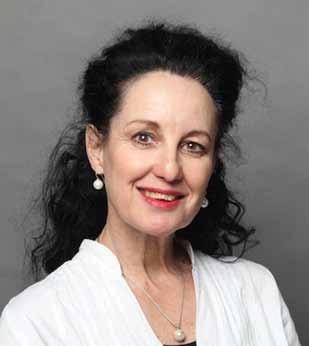
The CPUT focus area programme is one of the outcomes of our ten-year strategy for research and innovation, as described in the RTI 10-year Blueprint of 2012.
In order to build critical mass and make effective use of limited resources, CPuT has resolved to develop clear areas of focus over the next ten years. Our research, technology and innovation efforts and resources will be concentrated on these focus areas. each of the areas provides a basis upon which research and innovation niche areas are developed within faculties, centres of excellence and units.
The choice of these focus areas and associated niche areas has been informed by:

• CPUT’s strengths
• Areas likely to make the strongest contribution to strategic imperatives and national priorities
• A need to support a multi-disciplinary approach to research and innovation
The seven focus areas identified in the RTI 10-year Blueprint are:

Biotechnology-based research and innovation at CPUT is guided by the objectives of our RTI Blueprint, and aims to contribute towards the south African Bio-economy strategy. This will be achieved through knowledge production that is aimed not only at benefiting our local and national communities, but also at supporting the growth and development of a global bio-economy. The goals of the south African Bio-economy strategy are to address health challenges; food nutrition and security; clean water; clean renewable energy with a reduced reliance on fossil fuels; a shift from a resource-based economy to a knowledge-based economy with sustainable resource management; and protection of our biodiversity. Through our research, we aim to enhance our strategic partnerships, facilitate knowledge exchange and capacity building, and stimulate socioeconomic development in these target areas.
South Africa has vast natural resources and a wealth of indigenous knowledge. Biotechnology, as part of this focus area, will play a key role in the development of the ‘Farmer-to-Pharma’ value chain – developing bio-based products from these natural resources while ensuring that the rights of indigenous peoples are respected. The scope of our research is wide and entails several multidisciplinary niche areas.
Through these niche areas, we are addressing a number of of the the United Nation’s strategic Development goals:
Goal 2 - Zero hunger
Goal 3 - Good health and wellbeing
Goal 5 - Gender equality
Goal 9 - Industry, innovation and infrastructure
Goal 12 - Responsible consumption and production
Goal 14 - Life under water (biodiversity management)
Goal 15 - Life on land (biodiversity management).
In addition, our niche areas are addressing the south African National Development Plan: Chapter 3 - economy and employment
Chapter 10 - Promoting health.
The niche areas that form part of this Focus Area include:
• Biocatalysis and enzyme production
• Biomarker development
• Chemoprevention
• Functional foods
• Mycotoxicology
• Nanotechnology
• Oxidative stress in health and disease development
• Phytochemistry & phytomedicine
• Proteomics
• Sport performance and supplementation
• Wastewater bioremediation and beneficiation
marnewickj@cput.ac.za
CPuT’s objective of providing students with hands-on training and practical skills has been bolstered through a partnership programme with the Western Norway university of Applied Sciences. The project also seeks to establish research collaborations between CPuT’s Biomedical Sciences Department and the Norwegian university, says Prof Tandi Matsha, head of the CPuT department. She recently visited Norway with Microbiology lecturer and third-year co-ordinator, Ms Yvonne Prince. The project is aimed at developing best practice for training in biomedical laboratory sciences through educational and research collaboration between the institutions.

Prof Matsha said a two-year grant was received from the UTFORSK partnership programme, and this would enable three CPuT students to travel to Norway this year as part of their WIL experience. The UTFORSK Partnership Programme supports project cooperation between higher education institutions in Norway and higher education institutions in Brazil, China, India, Japan, Russia and SA. The three students are on the BhSc: Medical Laboratory Sciences Programme. An additional two students would be given the opportunity to travel to Norway for WIL in 2018.
From utilising the human body to generate energy to conducting self-testing for diseases such as cancer, researchers at CPuT are busy changing the way we live. “As a researcher, you need to be thinking 20 years down the line,” says Dr Mahabubur Rahman Chowdhury, an innovative researcher in the Department of Chemical engineering. “If we can make our bodies our source of energy, then why not. Bio-machine interface is the future.”

Over the last few months, Dr Chowdhury and his team have made huge strides in several of the projects they have undertaken, including the development of non-enzymatic bio sensors for glucose detection, and a bio-fuel cell that can be used to power implanted medical devices. The team is also exploring bio markers that will allow individuals to self-test for cancer and other diseases.
Dr Chowdhury says work on these projects began last year and the first phase focused on the development of non-enzymatic bio sensors for glucose detection, an innovative solution that will replace traditional diabetic testing
methods. embedded in a thin film strip, the sensors are developed from highly functional material that can catalyse glucose without any enzymes. “Diabetes is a big problem and currently there is no cure. You can only manage it and to do that, you need to monitor your glucose levels,” he says. Currently, selfmonitoring of blood glucose is done using a glucose monitor and throwaway strip which contains a drop of blood from an individual diagnosed with diabetes. Dr Chowdhury’s advanced thin film strip can be used multiple times and will cut cost for users.
Building on that project, Dr Chowdhury is using the same functional material to develop a bio-fuel cell that will generate energy utilising glucose found in an individual’s blood. The fuel cell will most likely be embedded inside an individual, and this energy will be used to power implanted medical devices such as pacemakers. More information on the research can be found in the paper ‘Binderless solution processed Zn Doped Co3O4 film on FTO for rapid and selective non-enzymatic glucose detection’.
Pushing the boundaries of researchProf Tandi Matsha and Ms Yvonne Prince Dr Mahabubur Rahman Chowdhury (centre) with Ms Gloria Kibambo and Ms Micaela Harry
IBMB comprises several research entities and functions across various CPuT faculties:
• Oxidative Stress Research Centre
• Biocatalysis and Technical Biology Research Group
• Chemoprevention Research Group
• Mycotoxicology Research Group
• Proteomics Unit
• Animal Ethics Research Committee
The IBMB is mandated to conduct world-class multidisciplinary research in biotechnology aimed at reducing health risks in South Africa associated with food/water safety, mycotoxicology, oxidative stress, community health and chemoprevention. The IBMB seeks to encourage the development of key scarce skills in areas such as biocatalysis and nanobiotechnology, in the realisation of South Africa’s bio-economy strategy.

Our research groups, representing the different focus areas, have excelled once again with respect to research outputs, obtaining research grants and mentoring postgraduate students at CPuT and other national and international universities. Of particular importance are our activities to promote the IBMB brand name beyond the borders of the university to different institutions locally and abroad. Many of our senior scientists have made important contributions to research ethics and research capacity development, while sharing their expertise by serving on various national and international research committees.
Prof WCA Gelderblom (Research Chair)gelderblomw@cput.ac.za
Prof JL Marnewick (Co-Chair)marnewickj@cput.ac.za

Prof Oluwafemi Oguntibeju in the Department of Biomedical Sciences has maintained his C3 National Research Foundation (NRF) rating. He is grateful for the recognition and believes that the quality of his research has improved. The rating will put him in a good position to obtain additional funding for his research on diabetes and medicinal plants.

“CPuT is continuing to build its NRF-rated researcher cohort every year. We celebrate every new rating that our researchers obtain simply because it is directly aligned with CPuT’s vision... to build a reputation for research and innovation,” says Prof Dina Burger, Director: Research. She adds, “We are gradually becoming an institution that will contribute to the development agendas of South Africa, Africa and beyond.”
With millions of new cases of cancer reported each year, researchers across the globe are working tirelessly to develop new and smarter ways to fight cancer. One such researcher is CPuT’s Dr Stefan Abel, whose groundbreaking work in the field of chemoprevention has recently earned him a prestigious NRF grant. Based in the IBMB, Dr Abel currently heads the institute’s Chemoprevention Research Group, located at the Tygerberg hospital. The group’s emphasis on chemoprevention research focuses on South African herbal teas, such as rooibos, and dietary unsaturated fatty acids, such as omega-3, which can influence the physical and biological cellular responses that are significant during carcinogenesis (cancer development).
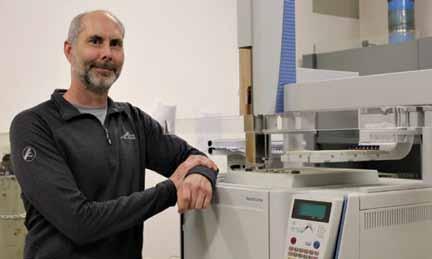
While cancer remains a daunting public health challenge, Dr Abel says he has never regretted his decision to pursue this area of research. his entry into this field occurred in 1992, when he joined the Medical Research Council and was tasked with investigating the role of fatty acids in cancer development and the chemopreventive properties of n-3 polyunsaturated fatty acids (PUFA). Over two decades later, Dr Abel has established himself as a leading researcher in his field, having published 34 scientific publications and four book chapters, along with 55 national conference presentations, close to 40 international conference presentations, and numerous articles in local and internal magazines and specialised publications. he says his research work focuses on characterising the pattern of lipid alterations in cancer tissue, which creates an environment for the promotion and survival of cancer cells. “The research I have conducted has provided further insight into the complex lipid alterations occurring in cancer development, with the aim of defining and optimising specific fatty acids to be used as chemopreventive agents,” he says.
Prof Oluwafemi Oguntibeju of the BiomedicaI Sciences DepartmentThrough dietary manipulation, which is largely based on specific fatty acids, such as omega-3, Dr Abel and his team of researchers hope to stunt the growth of these cells. “The link between nutrition and chemoprevention is of particular relevance, which is reflected by the inclusion of a nutritional aspect to my research focus, besides chemoprevention which it complements. Therefore, my research activities have grown to reflect this by incorporating relevant studies with the aim of implementing them in a chemoprevention strategy.” he says the core research over the last eight years has remained the same, with the main objective being to investigate the role of PuFA in cancer development in humans, utilising animal cancer models and cell culture. Past research has involved liver and colon cancer, while future studies will also include prostate cancer.
http://www.cput.ac.za/academic/faculties/healthwellness/research/oxidative
The main aim of the OSRC is to contribute to existing knowledge regarding the role of oxidative stress in health promotion and disease development. It focuses on devising innovative strategies for the prevention of diseases associated with oxidative stress, with the ultimate goal of improving our population’s health status. emphasis is placed on the use of indigenous medicinal plants or derived phytochemical bio-actives to achieve this. The centre currently has four niche areas within the focus area of Bio-economy & Biotechnology. The year 2017 is our fourth as part of CPuT’s new research institute, IBMB. The partnership has proved to be a very fruitful one, providing access to new research expertise, collaborations and international exposure opportunities for our scientists and students.
OSRC Research Niche Areas:
Leader: Prof JL marnewick
Our research focus is on elucidating the mechanisms involved in the development of certain lifestyle diseases in which oxidative stress plays a role, and on using the indigenous herbal tea, rooibos, as an innovative prevention strategy. In recognition of our research expertise, Prof Jeanine Marnewick and Dr Liana van der Westhuizen visited the University of Kaposvár to serve as expert advisors on an eu-funded project. Further recognition was conferred by the local industry on Prof Marnewick, when she was elected Technical Advisor to the SA Rooibos Council.
highlights for 2017 include the graduation of one master’s student and one doctoral student, while we also hosted two international students from the Thomas More university College, Geel (Belgium), who were involved in research projects using indigenous South African plant extracts for the natural preservation of wine. A former student co-published a paper on green honeybush in the herbal Teas special issue of the South African Journal of Botany, following an invitation to Prof Marnewick. A paper by her postdoctoral student Dr A Lawal featured in the environmental Contamination and health hazards session chaired by Prof Marnewick at the 7th Pan-African
environmental Mutagen Society Conference in Cairo, egypt. Prof Marnewick was invited by the Water Research Commission of South Africa (WRC) to be a reference group member for the review of a funded project. She was invited to be an external, independent assessor for an associate professorship by the Kwame Nkrumah University of Science and Technology (Ghana), as well as an external independent assessor for a Reader position at the University of Ibadan (Nigeria).
Prof Marnewick was invited by the hungarian National Research organisation to serve as an external reviewer for their Development and Innovation Office (NKFIH), and by the World Academy of Sciences (TWAS) to act as an external membership reviewer. She reviewed manuscripts for internationally rated peer-reviewed journals as well as applications to the ethics Committee of the South African Medical Research Council (SAMRC). Prof Marnewick remains a popular speaker, and in 2017 was invited by one of the leaders in the cosmeceutical industry, Annique, to be guest speaker at their Annual Gala event on the health benefits of rooibos. At the end of 2017, she received an improved NRF rating, that of C1.

Leader: Dr Liana van der westhuizen

The current focus of this Niche Area is integrated with the ‘Production of a rooibos-based product with enhanced antioxidant capacity’ and the ‘Bioavailability’ projects within the CPuT Prestigious Project: Rooibos and heart health. Dr L van der Westhuizen successfully completed the Good Clinical Practice component of the Research Team course in the Department of Bioethics at Stellenbosch university in preparation
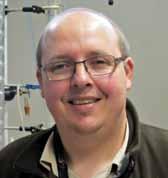
Leader: Prof OO Oguntibeju

The members of this research group are Prof OO Oguntibeju (leader), Dr S Meyer, Mr W Pantsi, Dr N Brooks and Dr L Mciteka. The group resides in the Department of Biomedical Sciences. Its focus covers medicinal plants, diabetes and microbial infections (Phytomedicine). The group has contributed significantly to knowledge generation, research growth and capacity building at CPuT.
Investigation of the role of medicinal plants in the treatment and management of diabetes and microbial infections responds to the fact that diabetes and microbial infections constitute challenging health problems in Africa. It has prompted the exploration of medicinal plants such as Garcinia kola, Moringa and others for their anti-diabetic, anti-inflammatory, antioxidant, antigenotoxic, hepato-protective and anti-microbial properties. These
Leader: Dr Dirk Bester
Focused specifically on cardiovascular health, our research studies involve mostly dietary supplementation with potential medicinal plants such as red palm oil, buriti oil, rooibos and extracts of kolaviron, using experimental animal models and measuring cardiac function and biochemistry. This includes signalling pathways, such as PKB/ Akt, MAP-kinases and oxidative stress markers. highlights since this group’s relocation to the Oxidative Stress Research Centre
for the rooibos intervention study. She was elected co-chairperson of the Institutional Animal Research ethics Committee and also served on the Advisory Panel of TWAS and the Post-Doctoral ScholarshipBiochemistry Programme for the National Research Foundation (NRF), reviewing rating and Thuthuka applications. The group was represented at an international conference in Vienna.
plants could possibly serve as effective remedies for the treatment of diabetes and microbial infections.
Major achievements for 2017 include ten scientific publications in accredited journals, eight manuscripts submitted and four book chapters accepted for publication. Members of this group participated in six conferences, and successfully supervised to graduation in 2017 one master’s and one doctoral student. Prof Oluwafemi Oguntibeju received an NRF Collaborative Postgraduate Training Grant for student support. NRF bursaries were awarded to three doctoral, four master’s and five honours students through our research group. Dr S Meyer was awarded a NRF grant (2018-2020) in the category Competitive Support for Unrated Researchers, while the leader, Prof Oguntibeju, retained his C3 NRF rating.
include two publications on kolaviron in the Journal of Intercultural Ethnopharmacology and FASEB, while a manuscript has been submitted for publication stemming from the research on the South African herbal tea, rooibos, in a model of aortic contraction and relaxation. Our collaboration with the Department of Medical Physiology at Su continues.
Leader: Dr marilize Le Roes-hill

In 2017, the BTB continued to excel in the niche research areas of Actinobacteria, oxidative enzymes and biocatalysis (Leader: Dr M Le Roes-Hill), Nanotechnology (Leader: Dr T Mthethwa), as well as Wastewater bioremediation and beneficiation (Leader: Dr PJ Welz). The research emphasis of BTB is such that it allows for a multidisciplinary approach and the development of both staff and students in the scarce skills areas of Biotechnology and engineering. It is therefore not surprising that, in 2017, BTB continued to strengthen its ties with various faculties within CPuT, and with researchers at various other national and international universities. In addition, in furtherance of postgraduate student development, Dr Welz and Dr Le Roes-hill successfully completed the Strengthening Postgraduate Supervision course facilitated by Prof J Clarence-Fincham and Prof M Maistry.
BTB Research Niche Areas:
Leader: Dr m Le Roes-hill
The Germany/South Africa Researchers’ Launching Workshop organised by the NRF served as the starting point for the DST/ NRF funded project, SYNDEX (synergistic degradation of lignocellulose using enzymes and expansins). This collaborative project includes researchers from Rhodes, Su, uWC, CPuT, the Technical university of Munich, university of Stuttgart, and the Fraunhofer Institute IGB, Straubing branch. Dr Le Roes-hill visited the research facilities of the Technical university of Munich and Fraunhofer IGB in Straubing (June), as well as the Institute of Biochemistry and Technical Biochemistry, university of Stuttgart (July), where she presented on the work taking place at BTB. In addition, she took part in a workshop organised by the university of Stuttgart, which was held in Mittelberg, Austria (July). She was accompanied by Mr A Prins, who is currently completing his doctoral studies at BTB.
Dr Le Roes-hill met with Dr Anita Burger, the Innovation Manager for the Institute of Microbial Biotechnology and Metagenomics (IMBM, UWC), to discuss the development of projects relating to the German-South Africa research programme grants awarded to Dr M Le Roes-Hill and Prof M Trindade (July). In addition, Ass Prof T Kudanga (Department of Biotechnology and Food Technology, DUT) further developed existing collaborations, including the shared SA-Germany project for which Prof Kudanga is the principal investigator (September). This has created an ideal situation in which three of the twelve projects funded by the DST/ NRF in this bilateral program are collaborating and aiming to hold a joint workshop in February 2018. Towards the end of 2017, Dr Le Roes-Hill hosted Mr G Kolaitis from the Technical University of Munich (November 2017-January 2018) as part of the student exchange program of SYNDeX.
Leader: Dr T mthethwa

In 2017, Dr Mthethwa launched her project funded by the WRC: ‘Design of efficient plasmon-assisted semiconductor photocatalysts and their application in visible photocatalytic wastewater treatment’. She successfully hosted the opening meeting for this project (October) and also took part as a reference group member for the WRC project ‘electrochemical unit operations in industrial wastewater treatment: The development of electrocoagulation and photo-electrochemical oxidation reactors based on novel nanocomposite electrodes’ (November, WRC,
Leader: Dr PJ welz
For this research niche area, 2017 was a busy year, filled with workshop attendance and engagement with various industries and funding agencies. Dr Welz attended a workshop at GreenCape as a member of the advisory committee of the industrial water re-use group (April). She also attended WRC meetings in Pretoria as a member of the reference group for projects entitled ‘An investigation into the impact of sludge return flows on South African wastewater treatment works’ (September) and ‘effect of water pollution on methane flux mechanisms within natural and constructed wetlands’ (July). Mr A Mpofu attended a WRC symposium ‘Adaptation to the New Normal’ (Pretoria, September).
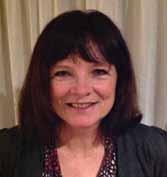
Together with Prof Haldenwang (Civil Engineering), Dr Welz and Mr Holtman (MEng student) are involved in a pilot project for wastewater treatment in the wine industry. In May, Dr Welz and Mr holtman attended a workshop facilitated by the World Wildlife Fund at Delheim winery titiled ‘Improvement of IPW and cellar waste water’. In September, they met met with Mr J Rossouw (Environmental manager, Distell) and the winemaker at a Stellenbosch winery and successfully secured cooperation to set up a pilot system at the winery as a continuation of a Winetech-funded project. In September they attended a Winetech committee meeting to report back on the results of their research, and in December Mr holtman graduated cum laude with a MEng (Civil Engineering).
Pretoria). Dr Mthethwa hosted Prof Nagao Kobayashi and Prof Mutsumi Kimura from Shinshu University, Ueda, Japan, in November, when they discussed continued collaboration with Dr Mthethwa, following on her visit to their laboratory in 2016. They also gave presentations at the Department of Chemistry, CPuT Bellville campus: ‘Development of highly efficient Phthalocyanine-based sensitizers for dye-sensitized solar cells’ (Prof Kimura) and ‘Synthesis and characterisation of spectroscopically intriguing Phthalocyanines’ (Prof Kobayashi).
In March, a collaboration was established between Dr Welz, Dr O Oyekola (Chemical Engineering, CPUT), and Dr R van Hille (Disa Scientific), who met with Dr Herbert Batsetse from the DST to present a funding proposal for a project titled ‘Bioremediation and recovery of renewable energy from tannery wastewater’. Dr Oyekola was successful in obtaining funding from the DST, and Dr Welz followed this up with the successful submission of a funding proposal to the WRC that will together support two DTech, two MTech and four BTech students with bursaries and project costs. The CPuT group will form part of a bioremediation consortium with uNISA, uJ and the university of Venda (March). The CPUT consortium met for further discussions in April and May.
Dr Welz was involved in compiling a number of WRC National Survey (NATSURV) documents on water and wastewater practices in various industries, both as a project leader (sugar industry, edible oil industry) and co-investigator (tannery industry, laundry industry) with Mr Chris Swartz of Chris Swartz Water utilisation engineering. In February, the tannery group held a workshop at the WRC offices in Pretoria to disseminate results of the survey to industry and obtain feedback on the draft document.
(i) Chemoprevention Leader: Dr s Abel
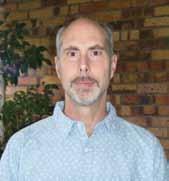
The aims of this group are to research the mechanisms of carcinogenesis in order to reduce human health risk, and the utilisation of dietary constituents as chemopreventive agents to prevent/reduce the outcome of cancer. The main emphasis on chemoprevention focuses on South African herbal teas, such as rooibos and honeybush, and dietary unsaturated fatty acids, such as omega-3. Cellular processes involved in carcinogenesis and chemoprevention are monitored in terms of alterations in fatty acid profiles, apoptosis, cell proliferation and cellular oxidative status in suitable physiological fluids or tissues. Other research areas include polyunsaturated fatty acids and nutrition-related products.
New collaborations were initiated in 2017. Collaboration regarding lipidomics was initiated with Prof Marina Rautenbach at the BIOPeP Peptide Group, in the Department of Biochemistry at Stellenbosch university. The purpose is to identify lipid biomarkers and signalling pathways for monitoring the effectiveness of fatty acids and herbal teas as chemopreventive agents in cancer cell lines. This initiative will link up with the newly established Proteomics unit at IBMB under the co-ordination of Dr Mariska

Leader: Dr JF Alberts
The Mycotoxicology Research Group is working with several international expert groups as project leaders and collaborators on existing and newly secured research projects: BIOMIN, Austria (two projects); USDA, USA (four projects); IFA-Tulln,
Lilly, to assist in establishing techniques at the unit, particularly with specific signalling molecules related to oxidative stress, apoptosis and inflammation, to be used as biomarkers in disease prevention. Discussions were held with representatives from the University Paris-Est Créteil (UPEC) regarding future collaborative research projects between the two institutions. Prof Gelderblom visited uPeC in May/June to meet with specific departments and identify similar fields of research, with a view to collaborative research projects.
under the student exchange agreement with uPeC, three French students were hosted in April/June as part of their practical training programme. The development of a lipid-herbal tea emulsion is still ongoing and discussions were held with Prof J van Wyk (Department of Food Technology, CPUT) regarding assistance in flavouring the emulsion. Dr Ch Abrahams joined the Group in June as a CPuT postdoctoral fellow to determine the effect of a lipid/herbal tea emulsion on colon cancer cells in culture. A student, Ms Claudia Abrahams, received her BSc honours degree in Medical Biosciences from uWC. Two manuscripts were published in 2017.
University of Vienna (two projects), and the University of Namibia (one project) (Dr Hanneke Alberts; Dr Mariska Lilly; Dr John Rheeder). During 2017 the group published three articles in international peer-reviewed scientific journals as first and/or
corresponding authors, and a book chapter in the 83rd Report of the Joint FAO/WhO expert Committee on Food Additives, as part of the WhO’s Technical Report Series. Researchers also contributed to research uptake and community engagement: Dr JF Alberts published two articles in industry-related magazines, namely, the South African Food Science and Technology Magazine and Farmers Weekly; Dr H-M Burger and Dr JP Rheeder published a series of six articles for SA Grain’s magazine Pula Imvula. This magazine has a national audience of about 18 000 small-scale farmers and is translated into seven South African languages. Dr h-M Burger engaged with community members in the KwaGcaleka area, Eastern Cape, to test and translate (isiXhosa) a training booklet aimed at reducing fumonisin mycotoxin exposure. The Mycotoxicology Research Group is proud to announce that Dr JP Rheeder, Senior Researcher, obtained a C2 rating from the NRF.
CPuT has identified Biotechnology and the Bio-economy as a focus area for research. The creation of a proteomics unit was envisaged as enhancing Biotechnology-based research at CPuT and contributing to South Africa’s Bio-economy drive, as well as further developing IBMB’s status as both a nationally and internationally recognised leader in the field of Biotechnology. The Proteomic unit was created under the directorship of Prof JL Marnewick and leadership of Dr M Lilly, a PhD researcher. Proteomic research has been in progress for the past four years as part of the research objectives outlined in the business plan of the Mycotoxicology Research Group. existing projects in collaboration with the Mycotoxicology and Chemoprevention Research Groups within IBMB include: ‘Proteomic and transcriptomic analyses of molecular mechanisms associated with fumonisin production by Fusarium verticillioides MRC 826 in maize’ in the agricultural field; and ‘A proteomic and selected transcriptomic assessment of the chemoprevention properties of rooibos and honeybush herbal teas against uVB-induced skin damage’. Link-ups with the Oxidative Stress Research Centre
Researchers participated as committee members and project leaders in expert decision making on a national and international level with regard to regulatory levels of mycotoxins in food and the validation of analytical methods (African Experts regarding the Codex Committee on Contaminants in Food; invited participation in the 83rd meeting of the Joint FAO/WhO expert Committee on Food Additives [JeCFA] [Prof GS Shephard]; and the South African Maize Trust [Dr JF Alberts]). Dr h-M Burger was a key role player in CPuT ethical committee matters and the compilation of a series of ethical policies. Prof WCA Gelderblom and Dr JF Alberts received Gold and Silver Research Awards, respectively, from the Office of the DVC: RTI&P, for research excellence in the category of sourcing external funding for the 2015 academic year.
(OSRC) in BTB and other research entities within CPUT are envisaged and are currently being investigated.
The main aim of the unit is to develop a centre of excellence for proteomic research as a niche focus area at CPuT with the primary objectives of (a) establishing, developing and consolidating proteomic research in the Institute of Biomedical and Microbial Biotechnology (IBMB) and other focus areas across faculties at CPUT; and (b) establishing relevant biomarkers in biomedical and agricultural research for disease prevention. Secondary objectives include (a) to develop proteomic research capacity according to international benchmarks and strengthen national and international research networks; (b) to address public health issues focusing on chronic diseases such as cancer and cardiovascular disease; (c) to address agriculture-related problems associated with food safety; and (d) to address human capital development in collaboration with other universities to facilitate postgraduate education in this scarce skills area of research.
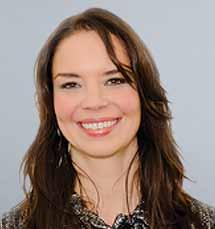
Chairperson: Dr D Bester
Co-chairperson: Dr L van der westhuizen


CP u T’s A e C was approved by Senate in 2015 and located within the IBMB. Since then, The A e C then embarked on the journey to comply with all relevant regulations and laws in order to be accredited by the National Health Research Ethics Council (NHREC). The committee has successfully constituted its membership in line with national requirements and is in the process of finalising standard operating procedures. The Ae C began the process of applying to Nh R e C for accreditation at the end of 2017.
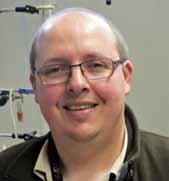
FACuLTY OF APPLIeD SCIeNCeS
The Agrifood Technology station (ATs) is a platform that provides a range of interdisciplinary technological services to the agrifood sector, focusing on existing smaller and medium enterprises, with a view to improving competitiveness, innovation, and research and development capacity in a sustainable manner. It is funded by the TIA initiative of the DsT. ATs is located on the Bellville campus, and includes a pilot plant with various processing areas, general and cold stores, and a number of laboratories.
In a sense, the ongoing effects of #feesmustfall could be considered a negative highlight for the activities of the station. Not all planned activities could take place either due to practical constraints or perceptions of safety on campus. As a result, the station struggled to meet its funder targets and Service Level Agreement.
Four ongoing or pipeline projects include a master’s study related to seaweed species and their use in modified form as food ingredients, Maillard Reaction products for potential use as natural antioxidants, the use of conjugated linoleic acid from milk in dairy products, and the use of kefir in various fermented food products. The ATS also completed hosting a postdoctoral fellow conducting research on near infrared technology in the context of fish fraud. A paper has been submitted for publication. In April the finishing touches were put to a final report on the uses of kelp in food in conjunction with a small company. This was followed by third- and fourth-
year students producing and refining further products of this nature in the Department of Food Science & Technology.
Several exciting industry-based projects are also ongoing. These include the use of kelp in beverages and the signing of an agreement with Agriprotein Technologies for black soldier fly larvae use in food products. The latter is of growing importance in light of the need for more high-quality protein for human consumption, a factor in international food security.
At a strategic planning meeting held in December, the growing role of the ‘Fourth Industrial Revolution’ in potentially shaping the activities of local food industries was discussed. In partnership with the Research Chair: Innovation in Society (Prof Thomas Thurner), the station is in the process of identifying small companies wishing to take advantage of opportunities and formalise preparations for participation in this changing scenario.
The introduction of the Steam Jet Cooker concept, obtained via an agreement with DC Norris (UK) and Courlanders Agencies (the local agent), has drawn significant interest from the South African food industry. It has both attracted larger companies to the ATS and earned annuity income for the technology station. The commissioning of a chocolate and sweet line has opened up scope for research as well as toll processing in the area.
The year has thus been challenging but rewarding. The growing uptake of ATS project work in postgraduate studies (kelp, insects, beer) is also heartening, increasing opportunities to address the needs of industry through formal research.
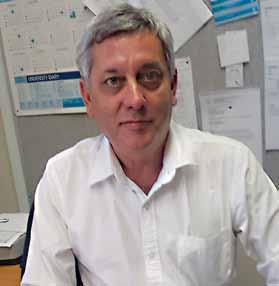 Mr Larry Dolley
Mr Larry Dolley
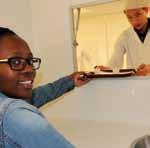

In another first for a uoT, the ATS has launched a Jet Cook Steam Infusion Product Development Facility, a cutting-edge cooking system that is revolutionising the food manufacturing sector. This plant is the only unit of its kind at a South African heI, and will be used to support small, medium and micro-sized enterprises as well as larger manufacturers in the food sector. A collaboration between CPuT, the Britishbased manufacturer DCN Norris and its local representative Courlander’s Agencies, this fluid processing unit relies on its innovative steam infusion system, cooking up to 500kg of sauces and other products much more efficiently than conventional methods used in industry. It does this by reducing multiprocessing stages, such as mixing, heating, pumping and homogenising, into one simple stage.
Director of the ATS, Mr Larry Dolley, says the new facility is a welcome addition to the technology station, and will allow them to expand their offering of support services to the food manufacturing sector. “There is great value in the equipment, including running industry trials and training students as well as SMMes needing to understand and experience the value of this new technology,” he adds.
According to a statement released by DCN Norris, the British-based organisation that manufactures the Jet Cook Steam Infusion, the device operates by collapsing steam into the product at high velocity through a specially designed nozzle. As the steam collapses it pulls the product (liquid) through, creating a re-circulating effect (partial vacuum) in the re-circulating pipe. Mr Dolley says additional benefits of the system include reduced energy consumption and less waste water. It also allows manufacturers to reduce starch and salt content. The ATS, along with DCN Norris and Courlander, conducted trials across multiple products on the system early this year, to demonstrate its capabilities to the South African food industry. Products produced during the trials ranged from cheese sauce to lasagna filling, custard and minestrone soup.
Asked to provide innovative support for small and medium enterprises in the food sector, the Agrifood Technology Station (ATS) recently debuted its state-of-the-art sensory facility. housed in the Food Technology Facility on the Bellville campus, the Sensory Facility allows small and medium enterprises to conduct extensive sensory evaluations on their food products. The ATS hosted its first sensory evaluation client over three weeks in July.
Ms hybre van Blerk, who facilitated the process, says sensory evaluation involves members of the public or experts who taste food products and characterise them according to specifics set
out by a client. For example, characterisation could involve aroma, appearance, flavour and texture. This process allows businesses to better understand their products and target market, to improve products or even come up with new ones. “This may sound like a basic task, but it is a crucial process,” she says.
Manager of the ATS, Mr Larry Dolley, says it was a huge undertaking which saw hundreds of sensory panelists bussed in daily to participate in the project. he says they are pleased with the results of the project and are looking forward to collaborating with many other clients in the field of sensory analysis.
Compared to its expensive counterparts like salmon, trout and cod, snoek is often perceived as a low value fish, generally preferred by people in coastal areas close to where it is caught. Now, thanks to a study by Ms Suné henning from CPuT’s Food Technology unit and Su’s Prof Louw hoffman, the humble snoek is being recognised for its considerable nutritional benefits. The study concluded that snoek is a healthy, relatively cheap high protein, low fat food source that is high in good omega-3 fatty acids.

The study will continue the research into other local marine fish species such as sardines, hake and catfish and will continue into three different cooking methods as well – microwaving, oven baking and steaming. Ms henning says the study found that there isn’t a huge nutritional difference between a fresh and frozen snoek, but adds that fresh fish will always taste better. “If a fish is frozen for an extended period then the fat deposits break down and the texture will change so it is better not to freeze fish for too long,” she says.
The snoek study has received extensive media coverage with further findings eagerly anticipated.
The Bioresource engineering Research Group celebrated its 8th birthday in 2017, with more than two dozen completed projects, culminating in the conferment of 25 degrees at master’s and doctoral levels, and doctoral degrees being achieved by two members of staff in the Departments of Chemical engineering and Occupational and environmental studies. Collaboration with NwU resulted in the development of a strategy to address challenges with potable water distribution systems for vulnerable communities in south Africa.
Through other international collaboration activity, a first paper on biological stoichiometry and the bioenergetics of fungal species in wastewater bioremediation was published with a colleague in the Department of Chemical Engineering, National Cheng Kung university, Taiwan, leading to further research on the elucidation of the role of water channels in microbial and plant species in retaining persistent water pollutants. This development is largely due to the interdisciplinary characteristics of the training programmes offered by BioeRG, which involve the integration of environmental studies, water studies, renewable resources, and the biological sciences. In 2017, the BioeRG doctoral board welcomed three new members while others graduated to be ex-officio members, who will serve on the advisory panel of the research group.
• Dr Lukhanyo Mekuto received a Research Excellence Award for Next Generation Researchers from the National

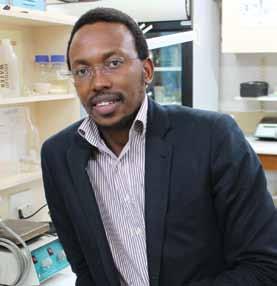
Research Foundation of South Africa, a first for CPuT, with T Moncho receiving a paper award at the ASeTWM-17 International Conference
• A keynote address was delivered at the 9th International Conference on Advances in Science, engineering, Technology and Waste Management (ASETWM-17), organised by the NWu in November in Parys
• International conferences at which papers were delivered include the Integrated Water Resources Development and Management: Innovative Technological Advances for Water Security in eastern and Southern Africa, in October in Namibia
• Doctoral board member Ms N Mpongwana was nominated to serve on the Young Water Professionals-ZA Western Cape division, participating in the leadership of young water professionals tasked with addressing the water crisis in the Western Cape
Mr Mahomet Njoya, born in Yaoundé, Cameroon, was awarded his master’s degree in Chemical engineering cum laude, having completed the degree within a year, with research on the treatment of poultry slaughterhouse wastewater. he has thus far published four papers. he is currently pursuing his Deng degree in Chemical engineering on printed smart materials for designing underdrain systems for anaerobic digesters.
Prof Karabo Ntwampentwampes@cput.ac.za
The mission of the Cardiometabolic health Research Unit is to create a collaborative environment for exploring the underlying reasons for the increasing incidence of diabetes and cardiovascular diseases, with the goal of improving cardiometabolic health in south Africa and beyond.
In this unit, the research cluster employs an integrated research programme focusing on obesity, cardiovascular risk, metabolic syndrome, chronic kidney diseases, and diabetes. The unit strives to accelerate research advances by employing innovative, multidisciplinary intra- and inter-institutional approaches aimed at improving cardiometabolic health through promoting healthy lifestyles, early diagnosis, and cost-effective disease prevention and management. Much of the group’s work comprises community-based studies, specifically in Cape Town’s Bellville South.
Prof Tandi Matsha
matshat@cput.ac.za
The research unit is involved in studying phenomena such as periodontal disease, immune activation, hepatic steatosis, vitamin D deficiency and insufficiency, pollution, and genetic and epigenetic novel risk factors for cardiometabolic traits in mixed ancestry South Africans. This research is funded by the South African Medical Research Council, the NRF and CPuT.
The Cardiometabolic health Research unit has a laboratory, rooms for clinical examinations and oral
health assessments, and work space for research fellows and graduate students. The unit provides researchers with much-needed characterised cohorts and biobanks to carry out novel and technologically advanced research.
Our research is broad, covering epidemiology to discovery-based laboratory science. Much of the work is interdisciplinary, integrating with the following research entities: Non-Communicable Diseases Research unit, SAMRC; Department of Pathology, Department of Interdisciplinary Health Sciences, SU; Department of Dentistry, UWC; Non-Communicable Diseases Research Unit, SAMRC; Department of Pathology, SU; and the South African National Bioinformatics Institute.
International collaborations include the Centre for Cardiovascular Genetics, British heart Foundation Laboratories; Institute of Cardiovascular Science, University College, London; and the Department of Pathology and Molecular Medicine, McMaster university, Canada.

FACuLTY OF APPLIeD SCIeNCeS
The focus of this niche area embraces the themes of chemical and biological assessment and monitoring, the development of remediation techniques to address the problem of environmental pollution and management, as well as environmental and human health risk assessment. The assessment and monitoring research projects focus on the identification, characterisation, monitoring and effects of chemical (inorganic and organic) and microbial pollutants in the environment. The remediation research projects focus on the development of appropriate techniques to remediate and manage polluted sites. An additional component in this niche area deals with the communication of research findings to the general public and the different levels of government in South Africa. The aim is to contribute to the development of environmental policy, legislation, and environmental guidelines and standards for South Africa.
Prof James Odendaalodendaalj@cput.ac.za

FACuLTY
During 2017, we spent most of our time on the commercialisation of our products with sOZO as our partner. sOZO now has a licence to manufacture, market and distribute our Omega Caro-e Xtra, our cereal, dog supplement and biscuit, all containing our patented ingredients, known and proven to promote general nutritional health. Reports so far are very positive.
We had to operate without a trained laboratory assistant, which had a limiting effect on our production. We did however continue to provide an analytical service to private industry, offering a full spectrum of analysis for omega-3 fatty acids. In this regard, our accuracy and reliability have made us laboratory of choice for analysis of this kind.
Prof Spinney Benadé
oppermanm@cput.ac.za
The research entity completed a report for the Malaysian Palm Oil Board on a study conducted in 2016. We studied the effects of consuming two biscuits baked with Red Palm Oil per day, for 6 months, on the general nutritional status of children attending an informal creche. We found that 69% of the children had low vitamin e status, which could have negative effects on their brain development. All the children had low aphaand beta-blood carotene levels, indicating a low fruit and vegetable intake, which could lead to increased risk for heart disease in later life. The immunity of these children was also compromised. Consuming biscuits
containing Red Palm Oil had a statistically positive effect on these parameters and even eliminated the deficiencies. What was most concerning was that when the weights and heights of these children were considered, their nutritional status appeared to be normal. True nutritional status lies deeper than weight and height measurements, which are the criteria on which the assessment of nutritional status is usually based. The value of this contract was R647 000.
During 2017, we also spent some time on developing new methods to broaden the scope of our unique service to industry, increasing our research capabilities in the field of carotenes, omega-3 fatty acids and health.
 Introduction by prof robert van zyl
Introduction by prof robert van zyl
Over the past decade, south Africa has become increasingly dependent on space-based applications to manage its national resources and security objectives. space science is indeed one of the five Grand Challenges defined by the Department of science and Technology to be addressed in its ten-year Innovation Plan. The establishment of the south African National space Agency (sANsA) has signalled a formal and coherent approach to the development of spacebased research, engineering and technology innovation in south Africa. within this context, this focus area serves as a catalyst for expanding current research to other niche areas to fully leverage the societal benefits to be derived from multidisciplinary, space-based services.
The focus area comprises the following research niche areas and staff:
space segment
Prof Robert van Zyl, Prof Robert Lehmensiek, Mr Clive Whaits, Mr Charl Jooste, Mr Nyameko Royi and Mr Leon Steenkamp
space Applications
Prof Robert van Zyl, Prof Roger Ceschi, Mr Siddique Motala and Mr Kevin Msungu
Dr Laban Mwansa, Prof elmarie Biermann, Mr Angus Brandt and Dr Vipin Balyan
Prof Stephen Bosman, Prof Mellet Moll, Prof Graham Oliver and Ms Patricia Khwambala
space science
Dr Kessie Govender and Mr Rory Pentz
• A contract of R16.8 million has been concluded with the South African National Space Agency for the development of ZACube-2, our second nanosatellite, that will be launched in 2018
• AMAYA SPACE has been established as a spin-out company of CPuT to commercialise the intellectual property developed in the focus area
vanzylr@cput.ac.za
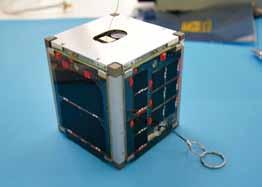
In April, a symposium explored ways of accommodating the interest of the Bavarian government in CPuT’s nanosatellite research. A delegation of Bavarian officials and academics met their South African counterparts at CPuT’s Bellville campus to discuss nanosatellite earth Observation Applications as a catalyst for international collaboration, as well as to view the facilities at F’SATI. The partners in the collaboration are CPuT, F’SATI, Stellenbosch university, Cube Space, South Africa’s DST, the Bavarian government and universities, the NRF and SANSA.
Dr John Volmink, Acting VC at the time, said Space Science & Technology was one of CPuT’s research focus areas. he added that the university’s satellite programme was being supported by the national government. Prof Robert van Zyl, head of F’SATI at CPuT said marine protection and ocean governance was one of the four critical areas of interest to the South African government in unlocking the potential of the country’s vast coastline. Mr Amal Khatri, Executive Director at SANSA, said lowcost satellites were more viable and have better access to funding. “There is a need to invest in nanosatellites,” he added.
The F’SATI Postgraduate Programme in Satellite Systems engineering at CPuT was established in 2009 with funding from DST and NRF to develop the human capacity and skills required by the South African space industry. F’SATI hosts the CPuT Focus Area in Space engineering and Technology. The programme is primarily aimed at postgraduate research and training and offers international master’s and doctoral programmes in partnership with French institutions. hands-on training is facilitated through the nanosatellite platform known as CubeSat, and typically spans four phases: Theory, Research, Development and Innovation. These last two phases take place within ASIC, a centre hosted by F’SATI to facilitate technology innovation in a professional environment of contracted employment.
Prof Robert van Zyl
vanzylr@cput.ac.za
The vision of the institute and its innovation centre is to become a world-class innovation and support hub in Africa, with an end-to-end capability in the design and manufacture of nanosatellites and nanosatellite components, space operations and ground-based support. The institute also undertakes data acquisition and handling for the provision of cost-effective satellitebased solutions tailored to the specific socioeconomic needs of the continent. Among the relevant applications are space weather research, marine vessel tracking, wildfire detection and monitoring, and communications and technology validation. F’SATI at CPuT developed Africa’s first CubeSat in space, TshepisoSAT, which
was launched on 21 November 2013 and has seen 4 years of activity in orbit. Its second satellite, ZACube-2, is expected to be launched during 2018 and will be an important contributor towards the South African Government’s Operation Phakisa and its oceans economy and biodiversity initiatives. This mission has been contracted through the South African National Space Agency with funding from the Department of Science and Technology.
During 2017, F’SATI continued to broaden its research activities by enrolling a record number of 57 postgraduate students, maintaining a steady student throughput (2 MEng, 1 DEng and 7 MSc graduates), and through its research publications (7 journal articles, 14 conference papers) and its inclusion in local and international research networks. Of note is a new memorandum of understanding with the university of Montpellier and its Centre Spatial universitaire MontpellierNîmes, aimed at promoting academic and research activities between our two institutions. F’SATI has also successfully applied for a site licence to operate a ground station, as a partnering site for the uSA-based Planet Labs, a private earth imaging company that has revolutionised earth observation with constellations of CubeSats.
In addition to its research and innovation activities, F’SATI created awareness and enabled further networking and collaborations through its participation as exhibitor at numerous international and local events, among them the International Astronautical Congress in Adelaide, Australia, the data.space 17 conference in Glasgow, Scotland, the Namibian Space Week in Windhoek, Namibia, the International VDeS Conference in Somerset West, the Innovation Bridge Technology Matchmaking and Showcasing event in Gauteng, the uNeSCO engineering Week in Bloemfontein, the united Nations/South Africa Symposium on Basic Space Technology in Stellenbosch, and the DST Budget Vote Debate exhibit at the Iziko South African Museum.

The launch of TshepisoSAT, code name ZACuBe-1, was a historic event spearheaded by F’SATI that has led to the development and marketing to an expanding international customer base of advanced CubeSat radio systems. “At four years, ZACuBe-1 has far exceeded the average lifespan of a typical CubeSat, and demonstrates the unique capabilities of the CPuT satellite development team,” says Prof Robert van Zyl, Director of F’SATI and ASIC. Based on the success of ZACuBe-1, more than a hundred such systems have been exported, many of them currently orbiting in space.
The F’SATI team is currently working on ZACuBe-2, which will be launched in May 2018. This project, funded by the Department of Science and Technology and the South African National Space Agency, will result in the most advanced South African CubeSat to date. The satellite is a precursor for constellations of CubeSats that will provide maritime communications in support of Operation Phakisa. The satellite ground station on the roof of the DeeCe building will be upgraded in preparation for the launch of ZACuBe-2.
CPuT is also recognised internationally as a hub for CubeSat development and operations. uSA-based PlanetLabs, who manage more than 200 CubeSats, recently contracted the university to provide ground support for its missions. “The technical support we provide to PlanetLabs missions will provide fertile ground for learning. We’re also ensuring a third income stream for the university through providing services to industry,” says Prof van Zyl.
AsIC was established in 2013 as a formal RTI Research Centre within CPUT. It has since evolved into a vibrant innovation hub where our graduates and engineers develop cutting-edge nanosatellite technologies in new high-tech facilities. Over the past four years, the AsIC team of engineers has developed a suite of communications products – with proven space heritage on a growing number of missions. These products span VhF, UhF, s- and X-band for telemetry and payload data communications. AsIC is also responsible for the full lifecycle development of nanosatellite missions. Its second satellite, ZACube-2, will be launched in 2018 and will serve as a precursor mission for constellations of nanosatellites to track ocean traffic along our coastline, as well as detecting veld fires.
All IP developed in ASIC is being licensed to AMAYA SPACe, the first spin-out company of CPuT.
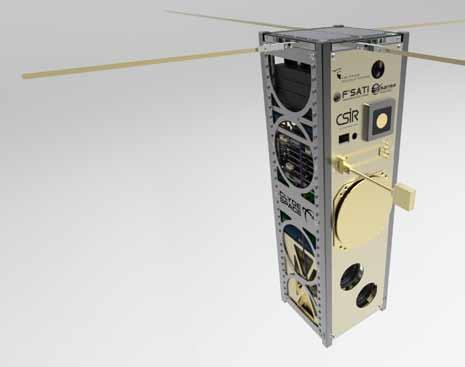
Prof Robert van Zyl
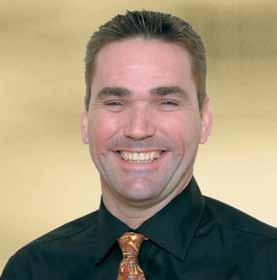
vanzylr@cput.ac.za
The ASIC engineering team members are: Nyameko Royi, Charl Jooste, Leon Steenkamp, Stephen Cupido, Donovan Cogan, Etnard Louw, Morne Roman, Kanyisa Mtshemla, Arthur Mabunda, Lilie Leopold and Sinamandla Maqina.
The CIR has a long-standing history within the Department of electrical, electronic and Computer engineering. The centre is based in the new electrical engineering research building on the Bellville Campus and operates under the umbrella of the French south African Technology Institute (F’sATI). The centre is currently headed by Dr Kessie Govender. Over the last few years, the centre has grown in terms of active staff members and postgraduate students.
The main focus areas of the CIR at present are:
b) Space Science and Technology;
a) Industry Application/Energy;
c) Emerging Technologies-Photonics. In the category of Industry Application/energy, the main project areas are novel electronics for high frequency ultrasonic condition monitoring of transmission lines and high voltage insulator cleaning, and direct current technology.
Active staff members in this focus area are Mr B Groenewald and Mr J Wheeler. A 350V direct current house project is in process, currently funded by erasmus Mundus Plus. This is a collaborative project involving a number of local and international partners including De haagse hogeschool Delft and Technische universiteit Delft (Netherlands), Katholieke Universiteit Leuven (Belgium), and industrial experts in the Netherlands. household appliances are moving towards direct current, which
makes the conversion from alternating current to direct current unnecessary and wasteful. The CIR has developed a focus group doing research into a DC micro-grid and 350V direct current house model that will hopefully set the trend for the future domestic landscape.
This research group has several master’s students. One master’s student graduated in 2017, and another will graduate in April 2018. In addition a number of accredited journal and conference papers have been produced.
Also based within the centre is the quantum physics research group headed by Dr Kessie Govender. This group forms part of the emerging Technologies-Photonics focus area of the CIR and conducts research into quantum technologies and quantum communications (see separate report on Quantum Physics Research Group).
Dr Kessie Govendergovenderk@cput.ac.za

The Quantum Physics Research Group was established within the Department of electrical, electronic, and Computer engineering in 2014. The group, led by physicist Dr Kessie Govender, currently investigates and develops expertise in quantum-based technologies. A quantum optics laboratory has been introduced for the purpose of cooling atoms and the subsequent development of quantum information processing components.

The group has established collaborations with researchers at the Laser Physics group at the university of Stellenbosch, the National Metrology Institute of South Africa (NMISA) and the Quantum Physics research group at UKZN. The group is being funded through an NRF Thuthuka grant, a CSIR-NLC laser rental pool grant, and the CPuT research office. Financial support is also provided by the French South African Technology Institute (F’SATI).

govenderk@cput.ac.za
In 2017 students in the group presented their work at the annual conference of the SA Institute of Physics held at the university of Stellenbosch. One journal paper and one refereed conference paper were published in 2017. In addition two conference papers and two journal papers have been submitted and are under review. Also in 2017 three master’s students (Ms Meena Patel, Mr Adrian Wyngaard and Mr James Stubbs) submitted their theses for examination, two of them obtaining cum laude passes. These students will graduate in April 2018. Three master’s and two doctoral students are currently active in group.
More information on the activities of the group can be found at: http://www.cput.ac.za/academic/faculties/engineering/ research/quantum_physics
Focus Area: energy is one of the outcomes of the CPUT 10-year strategy for research and innovation, as described in the 10-year RTI Blueprint. The aims of the focus area are as follows:
• Introduction and development of international best practices and transfer of knowledge in the field of energy and power systems
• Production of research and innovation outcomes relevant to the social and economic development needs of South Africa
• Building a critical mass of researchers at CPuT and making effective use of limited resources
The focus area’s research is multidisciplinary, innovation oriented and problem-solving driven
to address national and international challenges in the energy field.
The research investigations are aligned with two of the DST’s key Research and Development (R&D) areas: Energy Security, and Frontiers of R&D. The industry-related activities, and knowledge and technology transfer, are aligned with two of the DTI’s priority areas for growth in South African industry: the development of industrial partnerships for research, and engineering scarce skills development.
Members of the focus area are research centres and units from the Faculty of engineering. Their research activities and projects vary from producing biofuel to building a smart grid. The members and their foci of research are listed in the table below:
Research centre/unit Focus of the research work Leader
Centre for Distributed Power & Electronics Systems (CDPES)
Centre for Substation Automation & Energy Management Systems (CSAEMS)
energy efficiency, renewable and alternative energy technology, distributed system technology, predictive control of power converters and electrical drives, and MeMS energy sensor technology
Contribution to and addressing the need in SA for research infrastructure development that supports human capital development, and research and innovation in the field of metering, monitoring, protection, automation and control of power systems, paying particular attention to current and emerging standards in the field
tzonevar@cput.ac.za
Prof T Khan Prof R Tzoneva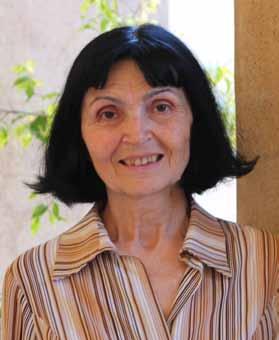
Research centre/unit Focus of the research work
Direct current research Micro-DC grid investigation for a sustainable household power plant; optimal use of sustainable power sources; conversion of AC installations to DC installations; DC-grid safety in households
Energy Institute Organisation of 2 international conferences: Domestic use of energy and Industrial and Commercial use of energy
Modular Solar Powered Aquaponics
Development of modular solar-powered aquaponics to encourage entrepreneurship to benefit society. Working with impoverished communities by introducing renewable energy projects that favour the upliftment of such communities
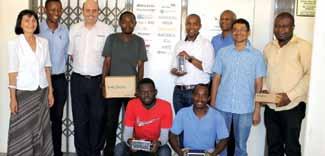

Leader
Modelling of power stations
Modeling of power stations to assist in decision making for operational, maintenance and capital decisions. The longer term focus will be on training eskom’s technicians using models of the full plants

Renewable Energy Recovery from Waste Materials
Producing biogas from wastes to be used to replace or supplement fossil fuels in power generation. Investigation of Anaerobic Digestion (AD) as an energy-efficient and environmentally beneficial technology for bioenergy generation
Real-Time Distributed Systems Development of novel models, design methods, software, hardware and their integrated application for real-time monitoring and control in proper areas of application and research
Future steps in the energy focus area will involve collaboration between members and the integration of their research activities, as well as the undertaking of joint projects on national and international levels. The focus area’s activities will be aligned with the National Development
Plan 2030 and sustainable development goals. Collaboration with eskom, based on extension of the eskom Power Plant engineering Institute, will facilitate the solution of real industry problems and create better prepared and more knowledgeable master’s and doctoral postgraduates.

e nergy is a subject that covers every engineering discipline and has an impact upon every aspect of human life. It is therefore essential to bring experts of every kind together, to help one another find solutions to the many challenges facing the energy sector. A key aspect of our work is therefore organising two annual conferences, the Domestic u se of Energy (DUE) and the Industrial and Commercial Use of Energy (ICUE). These conferences draw both academics and practitioners, and help to find answers by fostering dialogue between disciplines. The year 2017 saw the 25th meeting of D ue and the 14th of IC ue . The past proceedings of these conferences are now online and can be found at http://energyuse.org.za/document-archive/
Prof Phillip Lloyd
khant@cput.ac.za
groenewaldb@cput.ac.za

FACuLTY OF eNGINeeRING
south Africa has embarked on a sustainable development vision for 2030 in its National Development Plan. To achieve this, industry needs to focus continuously on long-term strategies for adapting to climate change and reducing carbon emissions. By adopting this approach, a successful and resilient industrial sector will emerge. In line with this objective, CDPes strives to develop technology to advance the implementation of energy resource efficiency and promote cleaner production methodologies. Our research covers topics relating to modern smart grids and their evolution, the optimal use of energy and the design of energy management systems, solar and wind energy systems and their operation and control for residential and commercial applications, forecasting of energy production, microgrid integration and the operation and control of fossil fuel and renewable energy systems. CDPes strives to find ways to improve the energy production and energy use relationship by employing networked sensor technology, ambient intelligence, and associated electronic communication systems. Power electronics and drives are used in most sectors, ranging from industrial to residential applications. During 2017, CDPes acquired R6 million eTAP software for simulation, and was awarded a R14 million NRF NeP grant for Grid simulation and Battery system development.
Through its research, the CDPeS aims to:
• Develop power conversion for renewable energy sources and investigate the interconnectivity of distributed resources with microgrids, the smart grid and traditional electric power systems
Prof Mohamed Toriq Kahn
khant@cput.ac.za
• Test and use such technology in multidisciplinary applications, especially in the commercial and industrial sectors, where AI and Big Data play an increasing role
• Investigate and apply optical fibre and/or wireless communication techniques in large-scale power systems, for telemetry and control of microgrids, both AC and DC
• Improve control schemes for power converters and drives, including digitalisation of the energy Sector
• Develop instrumentation for complex alternative energy sources, such as the wind, solar and nuclear energy sectors, including environmental protection and sustainable development
The CDPES team members are Prof Tariq Kahn (head), Dr Marco Adonis (deputy head), Dr Atanda Raji, Assoc Prof Wilfred Fritz (Van Humboldt Fellow), Mr Deon Kallis, Mr Achmat Fish, Dr Ali Mustafa Almaktoof, Dr Khaled Abo-al-ez and Dr Vipin Balyan.
For contact details, please follow this link:
http://www.cput.ac.za/academic/faculties/engineering/ research/centre-for-distributed-power-and-electronicsystems-cdpes/staff
During 2017, CDPeS merged with the energy Institute and assisted in the organisation of the Due and ICue conferences in conjunction with eskom and other role players.
The centre has continued its ongoing collaboration with the Munich University of Applied Sciences (HM) through Dr Wilfred Fritz, who is completing postdoctoral work as a Von humboldt Fellow in Germany. The project forms part of a broader collaboration between CDPeS and the German entity, Training Development Consulting (TDC).
Other research collaboration in 2017 was between Prof Kahn and Prof Li Wenfeng’s research team of the Xi’an university of Science and Technology. Prof Wenfeng has been elected team leader of the 2018 annual Shaanxi provincial science and technology innovation project: ‘Space, Sky, and earth Communication Research’. Distributed Systems has an integral relationship with communication systems as well as control and power electronic systems.
During 2017, the following peer-reviewed publications were produced: nine DHET-accredited journal articles; fifteen conference proceedings; nine non-accredited journal articles; three conference posters.

• Energy utilisation of integrated solar PV and thermal module with storage device
• Multilevel converters using model predictive current control for renewable energy systems applications
Research and innovation in the field of power and electronic systems was accelerated this year with the establishment of a multimillion rand, high-tech facility on the Bellville Campus. During the first part of the year, CDPeS, headed by Prof Mohamed Kahn, set up a renewable energy systems simulator facility, the first of its kind in South Africa and the only one on the African continent. The facility is funded by the NRF to the extent of R15 million, and is part of their National equipment Programme. This programme provides universities with substantial funding support to purchase new equipment with the aim of improving research, innovation, training and collaboration in line with South Africa’s research priorities.
Dr Marco Adonis, Deputy head of Operations at the centre, says the facility will enhance their current research activities, especially in the area of developing power conversions for renewable energy sources, as well as their exploration of the interconnectivity of distributed resources with microgrids and electric power systems. he says while some institutions have simulators, CPuT will be the first university in our country to install a simulation system that will allow researchers to simulate a wide range of conditions relating to power and electronics systems. Over the past few years, simulators have gained popularity in the fields of research, innovation and teaching. The primary advantage of such systems are that they allow users to design and test real world systems without having to construct costly prototypes. They have also become valuable teaching tools in various disciplines.
The new facility will create vast opportunities for regional and national collaboration, with CDPeS planning to work on various projects with researchers from uCT and Su. Projects will be linked to national priorities as well as tie in with the CDPeS research areas, including energy efficiency, renewable and alternative energy technology, distributed energy system technology, predictive control of power converters and electrical drives, as well as MeMS energy sensor technology. Dr Adonis says the facility is based in the Department of electrical, electronic and Computer engineering. The building is the largest research and teaching facility at CPuT and houses several other leading engineering research centres.
• Comparative strategies for efficient control and storage of renewable energy in a micro grid
• Design and development of a 300kW solar PV and wind renewable energy microgrid island
• Applications of solar assisted air conditioning systems in sub-Saharan Africa for residential buildings
• Development of a robust grid synchronisation algorithm for a power electronics interfaced microgrid system
• Fault ride-through capability for a multi-pole permanent magnet synchronous generator for a wind energy conversion system
• Solar pathway development
• Genetic algorithms and Big Data in the evolution of the smart grid
• High voltage fuel cell stacks
• Condition monitoring of squirrel cage induction generators in wind turbines
• Characterisation of radiation effects on power system components for CubeSats
• Comparative strategies for the efficient control and storage of renewable energy in a micro grid
• Thermal modelling and simulation of an electric infrared heater for plastic waste gasification
• Optimisation of power output from gas yield for a plastic waste gasifier
• The design and development of an electromyography-controlled robotic hand
• The African microgrid design for energy security

• DC micro grid control mechanisms for grid stabilisation
• Analysis and improvement of the power quality of grid-tied and alternative energy systems
• Modelling and analysis of voltage distortion on the grid
• Technical assessment to optimise the power output and efficiency of a reversible Francis Turbine
• The effect of renewable generation on the stability of the South African grid
CDPeS had 69 master’s and doctoral students in its centre this year. Seven students graduated with master’s degrees, and one with a doctoral degree.
CPuT is going off the grid. In a bid to become energy efficient, CDPeS has installed an off-grid solar PV system with battery backup. The system is a first for CPuT, and has the capacity to run five of the centre’s laboratories, which are located in the Bellville-based facility housing the Department of electrical, electronic and Computer engineering. Dr Marco Adonis, deputy head of operations at CDPeS says the new installation will reduce the department’s electricity bill, with potential cost savings expected to be in the region of R25 000 per annum. It will also contribute towards teaching and learning activities, and complement several of the centre’s core research areas, which include energy efficiency, renewable and alternative energy technologies, microgrids and smart grids.
Installed by Solar MD, the system consists of 18 solar PV panels on the roof of the new building, as well as a lithium-ion battery bank. The battery bank stores
electricity for use on days when there are low solar insolation levels as well as during periods of load shedding. The electricity stored will also be put to use during the evening, when lectures in the new Master’s in energy Programme are held and the CDPeS postgraduate laboratories are in use.
The installation features a state-of-the-art battery monitoring system and a smart system controller that assists with load management and protection. It also includes a versatile web-based monitoring system. “This feature enables the remote monitoring of the system parameters, analysis of the system performance, and generation of real-time or historical comprehensive reports on the site’s energy production, energy savings and technical status,” says Dr Adonis. Mr Kaloyan Dimnov, Director of Solar MD, says the solar PV panels are easy to maintain and have a lifespan of over 25 years.
The Centre for mechanics & Technology focuses on both fundamental and applied research in the field of mechanics. It is led by Prof Bohua sun, a member of the Academy of science of south Africa (Assaf).

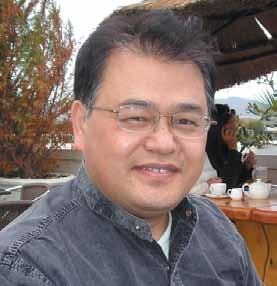
During 2017, the centre published five DheT-accredited journal articles: ‘Note on divergence of the Chapman–enskog expansion for solving Boltzmann Equation’ (Chin Phys Lett); ‘Incompatible deformation field and Riemann curvature tensor’ (Applied Math Mech); ‘Scaling laws of compressible turbulence’ (Applied Math Mech); ‘Scaling laws of aquatic locomotion’ (Sci China-PMA); ‘Capillary wrinkling scaling laws of floating elastic thin film with a liquid drop’ (Sci China-PMA).
The centre also published three papers in e-print format: ‘Kepler’s third law of n-body periodic orbits in a Newtonian gravitation field’; ‘On solution of capillary rise dynamics’; ‘Capillary wrinkling scaling laws of floating elastic thin films under a drop’.
Two papers were presented at international conferences: ‘Geometrical aspects of incompatible deformation field’ (ASCE/ Engineering Mechanics Institute, Rio de Janeiro); ‘Capillary wrinkling scaling laws of floating elastic thin films’ (ICCE, Rome).
One DTech, three MTech and three BTech students were supervised in the centre during 2017, all of whom graduated.
One project was funded by the NRF, and two research proposals were submitted to the NRF.
Prof Bohua Sunsunb@cput.ac.za
CRTDs team members are Prof Raynitchka Tzoneva (leader), mr Carl Kriger (deputy leader), mr mkhululi mnguni, mr Quinton Bart, Dr senthil Krishnamurthy, Dr Adeyemi Adewole, mrs Nomzano Tshemese and mr mukhove Ratshitanga.
The centre strives to make a theoretical and application-based contribution to advances in real-time distributed systems. It is concerned with the development of novel models, design methods, software, hardware and their integrated application for real-time monitoring and control. It also aims at insightful and focused determination of proper areas of application and research through appraisal and reappraisal of emerging control technologies. The core activities are:
• Design and implementation of nonlinear controllers
• Distributed control based on the IEC61499 standard for function block programming
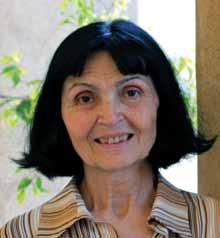
tzonevar@cput.ac.za
• Design and implementation of networked control systems
• Optimisation of complex distributed systems and development of algorithms for parallel computation
• A method for the design and real-time implementation of an automated microcontroller-based closed-loop irrigation system was developed and validated by BTech student h Swanepoel. The system is very effective and economical and appropriate to the scarcity of water in Western Cape.
• The research on the state and parameter estimation of a nonlinear ion exchange process for the desalination of water, developed by Deng student N Dube, resulted in
the production of novel methods and software that can be used for building desalination plants to increase the availability of fresh and clean water.
• A method for the design of a nonlinear adaptive controller based on Lyapunov’s theory for the control of interconnected processes was developed by Deng student Y Mfoumboulou.
• A method for model reference nonlinear control of synchronous generators in multi-area power systems was developed by Meng student P Banga-Banga.
• Joint work was done on the basis of the Erasmus+ K1 project for the Credit Exchange of students and staff between CPuT and the Yildiz Technical university, Istanbul, Turkey. Six staff members from the Departments of Control and Automation and electrical engineering visited CPuT, presented their research work and gave lectures to students. Three Turkish doctoral students spent a semester at CPuT working on their theses. Two doctoral students from the centre spent a semester at Yildiz Technical university working on their projects. Collaboration between our universities is developing successfully.
• Dr N Dube completed his doctoral thesis titled ‘Development of methods for modelling, parameter and state estimation for nonlinear processes’.
• Eskom TESP programme R 100 000
• NRF funding for DEng student Y Mfoumboulou R 110 000
• NRF funding for DEng student L Mbangeni R 110 000
The centre seeks to contribute to addressing the need in South Africa for research infrastructure development that supports human capital development and research and innovation in the field of the metering, monitoring, protection, automation and control of smart power systems, paying particular attention to current and emerging standards in the field.
Core activities concentrate on contributions to the theory and practice of substation automation and energy management systems, including:
• Interpretation, modelling and implementation of the IEC61850 standard functions
• Development of innovative protection schemes for different applications
• Real-time simulation and innovative solutions to energy management systems
• Development of test-bench facilities for the testing of ideas, project solutions, and new developments in the field of power systems
• Training and knowledge transfer through equipment-orientated courses, yearly industrial seminars on IEC61850, and organisation of the biannual PAC World Africa international conference
Achievements in 2017 in research, development, and applications of the IEC 61850 standard and technology included:
• A working prototype of a merging unit fully compatible with the new IeC61869-9 standard was implemented on FPGA platform and successfully tested as part of the work on the prestigious project by Meng student M Mphego
• New methods, algorithms and software for the parallel solution of multi-area feeder reconfiguration problems for power systems was developed and tested by Meng student F Giresse
• An extended method for IEC61850 standard-based transformer protection recognising the inrush current was
developed by Meng student C elenga
• A method for adaptive load shedding was developed and implemented by Deng student M Mnguni
• A test bed for real-time implementation of the developed method and algorithm was successfully used for validating the method for adaptive load shedding by Deng student M Mnguni
• An innovative algorithm for differential inrush current discrimination-based digital protection for a three-phase power transformer was developed and implemented using the RTDS simulator and SeL protective Intelligent electronic devices by BTech student S Malakia
Prof
tzonevar@cput.ac.za

National and International collaboration and joint work with universities and industry:
• In collaboration with the Eskom Research and Development department, work started at the end of last year on a pilot renewable energy project for building a Smart Grid in Stellenbosch
• An application was submitted to the EPPEI eskom programme to be approved as an eskom Specialisation Centre for Smart Grid in South Africa
• Applications for accreditation of the new MEng (Electrical Engineering) (Smart Grid) qualification, under the K2 capacity building programmes for Smart Grid development with 7 other universities from europe and Africa, were completed and submitted to DheT and heQC
• The RTDS user-group conference was organised at CPuT in February 2017, at which postgraduate students e Mthunzi, P Banga-Banga, postdoc Dr A Adewole and staff member Dr S Krishnamurthy presented their projects; Dr Adewole received the award for the best presentation
• Mr H Mataifa attended the training of lecturers for the new MEng in Smart Grid in Karlstad, Sweden
• Vendors of equipment SEL, Nova Tech and RJ Connect donated IeC61850 standard-compatible equipment to be used for research purposes

Mr M Lwana obtained his Meng: electrical engineering, cum laude. his topic was ‘Investigation of 3 terminal differential protection using standard-based numerical relays’.
Funding secured
• Eskom TESP programme R 100 000
• CPUT Prestigious Project R1 000 000
• NRF/THRIP project R 671 300
• DAAD funding for H Mataifa R100 000
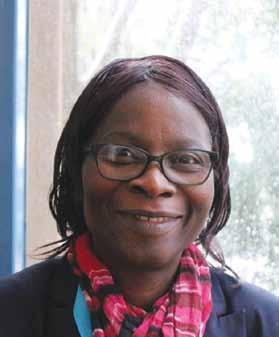
The environment includes everything that affects an organism during its lifetime. For example, an animal is likely to interact with millions of other organisms (bacteria, predators, mates), drink copious amounts of water, breathe huge quantities of air, and respond daily to changes in temperature and humidity. The list is numerous and complex, and therefore the concept of environment has been divided into abiotic (non-living) and biotic (living) factors.
human beings’ interaction with their surroundings and global climate change coupled with population growth have exacerbated negative influences on the environment. The world is currently faced with growing demands for food, water, housing, and infrastructure. This has resulted in increasing exploration and exploitation of renewable and non-renewable natural resources. The Climate Change & environment Research Focus Area therefore promotes research activities that are linked to sustainable utilisation of resources in a climate change-driven world.
This focus area’s research themes are linked to a number of the 17 Sustainable Development Goals and the South African National Development Plan 2030. Research niches in the Climate Change & environment Focus Area are:
• Agriculture, environment and sustainability
• Climate change and biodiversity
• Climate change and marine economy
• Environmental (air and soil) assessment, monitoring and remediation
• Health risks assessment (environmental and human) and climate change
• Water management, wastewater remediation and reuse
• Waste management and cyclical economy
opeolub@cput.ac.za
FACuLTY OF APPLIeD SCIeNCeS
Prof
Ken Findlay
findlayk@cput.ac.za
The CPUT Research Chair: Oceans economy operates within a special Oceans economy research niche area, primarily within CPUT’s Climate Change and environment Focus Area, with extensions into the University’s seven other Focus Areas. The primary function of the research niche area is the execution and delivery of a research programme on Ocean economy and Governance, focusing on sustainable environmental (ocean) management in south Africa. The research area is particularly relevant in that the south African Government’s Operation Phakisa’s initial programme of ‘Unlocking the Ocean economy’ includes a focal area for marine Protection services and Governance. Ocean Governance as an ecosystem governance process centres on informed decision-making that enables trade-offs between competing resourceusers, so as to balance environmental protection with the beneficial ecosystem service use in such a way as to mitigate conflict, enhance equity, ensure sustainability and allow for accountability. Trade-offs are dependent on valuation systems underpinned by ecosystem service Valuation and Natural Capital Accounting frameworks, so as to incorporate provisioning (economic), regulatory (environmental) and cultural (social) aspects of ecosystem services. In this regard a ‘trialogue’ model of ecosystem governance incorporates the inter-relationship of government and society, underpinned by science.
The research niche area thus aligns directly with the CPuT Focus Area Framing Paper’s identification of the ‘need to assess the current state of the environment and how human activities affect the wide range of ecosystems and ecological goods and services provided by these ecosystems’.
Three core project areas have been identified within this research niche area:
1. The development of research-based decision support tools for the area-based management of the marine and maritime domain, in a sustainable and equitable manner. Numbers of area-based management scenarios hinge on a Marine Spatial Planning (MSP) framework, and MSP has become a central pivot in the governance of the South Africa’s Operation Phakisa Ocean economy initiative through the development of the national MSP Bill and its associated framework. This includes Decision Support for Ocean Governance for ecosystem-Based Management within the South African Operation Phakisa: Ocean Economy framework (including Marine Spatial Planning [MSP], ecosystem Service and Natural Capital evaluation, Trade-Off and Composite Indicator Analyses, and Scenario Planning). Most human benefits obtained from the ocean realm are dependent on ecosystem services, which
are by definition dependent on functional ocean ecosystems. The balancing of ocean health and human benefit from the ocean is critical within blue economy principles.

2. Changes in ocean system processes arising from expanding and emergent ocean economy sectors within the South African eeZ.
3. New and emergent ocean science technologies, including data and information collection and knowledge development conducive to advances in Integrated Ocean Management in the South African seaspace. Increasing the use of novel technologies in ocean research, including remote and passive monitoring and sensing capacity (for example, satellite applications and moored oceanographic systems), along with their associated database architecture, is resulting in a new suite of costeffective research tools (such as ocean acoustics). These require new approaches in training and capacity development.
It should be noted that the above research framework interlinks aspects of marine spatial planning, marine protected area planning, marine conservation planning, ecosystem service evaluation and marine domain awareness applications. The research niche area also aligns with other focus areas where such alignment
provides for collaborations (for example Space Science & Technology and the development of Marine Domain Awareness in ocean management). Last year, the Research Chair: Oceans economy devised a business plan for a centre (The Centre for Sustainable Oceans) which will be submitted for registration as a Research Technology and Innovation Institute (The Sustainable Oceans Institute) in early 2018.
The Research niche area has gained significant traction in the international, regional and local ocean governance arena in a relatively short period, translating into collaborations and partnerships that will develop into academic outputs for uptake to ocean policy and practice. Prof Findlay coauthored six peer-reviewed publications in 2017, while a further three publications are in press from this period and 12 reports were produced for non-peer-reviewed meetings or publications. Some 14 presentations were delivered at international or national conferences by Prof Findlay in 2017. he also supervised five master’s students and three BTech students. Prof Findlay remains a member of the International Whaling Commission Scientific Committee, the IuCN Cetacean Specialist Group, the IuCN Sirenian Specialist Group, and chairs the South African Indian Ocean Rim Association Academic Group, Blue economy Chapter.
FACuLTY OF APPLIeD SCIeNCeS
The CWSR is the hub of CPuT’s water and sanitation network for the:
• identification and establishment of water-related niche activities/units/centres based on regional and national priorities
• facilitation and execution of interdisciplinary projects which generate research, income and graduate opportunities
• development and maintenance of partnerships on behalf of CPuT with relevant stakeholders in the water sector regionally, nationally and internationally
Current niche areas are environment and Water Sustainability, Water and Sanitation Services, and Water and Agriculture.
‘Living LAB’ projects: Breede Gouritz Catchment management Agency Partnership
Prof Alvin Lagardien
lagardiena@cput.ac.za
• The centre hosted the IWRM Living Lab Developments workshop in Caledon with BGCMA as part of Water Week on 16 March. Some 82 delegates participated in the workshop, which focused on strengthening the ‘Living Lab’ concept. Dr Stanley Laphadzi, WRC Group executive, gave the keynote address.
• A proposal was completed for the continued support of the ‘Living Lab’ concept with the Breede-Gouritz Catchment Management Agency for continued support of the Integrated Water
Resource Management (IWRM) previously funded by NuFFIC.
• A project schedule and budget for 2017/18 was completed and approved. Projects include:
- Institutional support to emerging farmers for improved livelihoods, comprising 4 wellattended farmer information roadshows in Caledon, Beaufort West, Oudtshoorn and George/Mossel Bay in November (46 people attended)
- Reducing pollution from informal settlement waste streams: Identifying case study sites and facilitating stakeholder partnerships
- Status quo and capacity building in Villiersdorp
- Situational analysis of solid waste management practices
Prof Lagardien continued his work as the National Coordinator for the implementation of FeTWATeR III. This programme identifies and plans delivery of the key occupational competencies required by the National Water Resource Strategy. The work is funded by the Department of Water and Sanitation, and the Water Research Commission is the implementing agent. It covers the key themes of Water Resource Planning, Water use Authorisation, Water Regulation, Water Liaison and Water Infrastructure Management. Key 2017 activities included:
• Planning, hosting and facilitating a series of workshops to build the capacity of expert practitioner groups in partnership with the CSIR, uWC, WRP and SeTAs, which included the 3rd Annual National Workshop in February; this engaged stakeholders on scoping results and curriculum development for sector occupations, under the banner of the Quality Council for Trades and Occupations, in anticipation of the draft National Skills Development Plan gazetted in December
• Completing Quality Assurance schedules and a RPL toolkit for process controllers in partnership with the LGSeTA
• Researching and planning appropriate workplace delivery systems, finding alignment with the DheT’s National Occupational Curriculum Content (NOCC) document, and developing a set of questionnaires to create a framework for the FeTWATeR model
• WRC 2208 An investigation into the social, institutional and economic implications of reusing reclaimed wastewater for domestic applications in South Africa (Beaufort West, Overstrand and eThekwini)
- Final report submitted
• WRC 2310 Approaches for emerging farmer participation in water resource management: The case of the Breede–Overberg Catchment Management Agency (BOCMA), Western Cape
- Completed research and submitted final report
• WRC 2530 Water allocation for productive use –policy and implementation: A case study of the black emerging farmers in the Breede–Gouritz
Catchment Management Area, Western Cape
- Completed research and Report 4: ‘Report profiling insights and analysis into relevant water experts’ understandings and experiences of the institutional and policy and legislative framework for allocation and reform’
- Completed research and Report 5: ‘Analysis of the system to identify the gaps and challenges and underlying causes in accessing the system for water allocation’
• WRC 2602 Review of the current knowledge of drought and drought occurrence in South Africa
- Completed research and submitted final report
• WRC 2716 Improving smallholder farmer livelihoods through developing strategies to cope and adapt during drought periods in South Africa
- Completed research and Report 1 ‘Description of smallholder farming in South Africa, outlining challenges faced by the sector including the impacts of drought and climate change’
• WRC 2329 Combined effects of urbanisation, industrialisation and population growth on the water quality of the Palmiet River and its tributaries in the Overberg West sub-catchment of the Breede Water Management Area: An integrated catchment risk assessment
- Submitted final report
• Water Process Controllers RPL Toolkit and close out report
- LGSeTA Report
• BGCMA Collaboration Agreements
- Project 1: Improving emerging livelihoods in the Breede-Gouritz Catchment Management Area ‘Combined strategy and institutional support Workshop’ BGCMA report ‘emerging farmer support package’ BGCMA report
The Water Research Commission (WRC) Knowledge Tree Awards celebrate men and women who make a major impact through pursuing excellence in the domain of water science. The awards were presented during the 3rd Biennial WRC Symposium held in ekurhuleni in November under the theme ‘Adaptation to the New Normal’.
Dr Bongani Ncube, a researcher at the Centre for Water & Sanitation Research, won her Knowledge Tree Award in the ‘empowerment of Communities’ category, in recognition of her research projects which focus on smallholder farmers in the Western Cape. She said, “This award means a lot to me personally, the Research unit and CPuT. It gives me great pleasure that my team has made a difference in the lives of the farmers in such a short period of time.”
Dr Ncube recently completed a collaborative project on accessing water and agricultural knowledge in the Western Cape, where she documented indigenous knowledge strategies for drought management. The research has further strengthened relations between CPuT and the Breede-Gouritz Catchment Management Agency, who have been collaborating since 2013 through an Mou agreement with uWC.

‘Roadshows and uptake reports’ BGCMA report
- Project 2: Approaches to ameliorating pollution
‘Project baseline and inception report’ BGCMA report
‘Fieldwork and training facilitators and monitors’ BGCMA report
‘Stakeholder uptake and upscaling report’ BGCMA report
- Project 4: Situational analysis of solid waste management practices
‘Project baseline report for solid waste management practices in BGCMA’ BGCMA report
‘Data collection tool for solid waste management practices in BGCMA’ BGCMA report
‘Fieldwork and validation report for solid waste management practices in BGCMA’ BGCMA report
• Dr Bongani Ncube presented at the Sudanese Ministerial Decision-Makers visit hosted by the Breede-Gouritz Catchment Management Agency in February
• CWSR hosted the annual Water Research Commission funding Workshop 101 in May
• Prof Alvin Lagardien was a Keynote Speaker at the 5th China Africa Water Resources Conference, hosted by the National university of Science and Technology, Zimbabwe in July/August
• Dr Ncube presented at the biennial Water Research Commission Symposium in September
• CWSR hosted the Water Research Commission Dialogue ‘Enabling the participation of emerging farmers in water resources management’ in November; Dr Ncube was the key presenter of the results of the WRC Project 2310
Two journal papers were published, and Dr Ncube received funding for PhD student Sydney Shikwambana as part of the Southern African Systems Analysis Centre Programme.
Two capacity-building and training workshops were held: FeTWater 3rd annual national workshop 17 February 2017, ‘FETWATER III occupational qualification development facilitation’; and WRC 7153, ‘Capacity building for water monitoring and assessment’. Report 3 was completed: ‘Development of learning material for water quality analyst and enforcement officer qualification’.
Dr Ncube was awarded the Water Research Commission (WRC) Knowledge Tree Award in the category empowerment of Communities in September.
The Crystal engineering Unit conducts research in the field of solid crystalline inclusion compounds. Its main thrust is understanding the molecular recognition that occurs between molecules in the crystalline state. In particular, projects are aimed at understanding the various secondary interactions which lead to particular structures, and to correlate these with the macro-properties of the compounds under study. The crystal structures are elucidated by X-ray diffraction and the stability and energy of the materials formed are studied by thermal, optical and kinetic measurements.

Staff members in the unit are Prof L Nassimbeni, Prof A Jacobs, Prof N Bathori and Dr M Wicht. There are a number of DTech, MTech, BTech and WIL students working on various projects at present. The projects focus on supramolecular host-guest systems, the mechanism of enantiomeric resolution whereby left- and right-handed molecules are separated, and pharmaceutical co-crystals.
nassimbenil@cput.ac.za
Talented students Kudzanai Nyamayaro and Kelly Shunje are based in the Department of Chemistry. They have been awarded the Innovation and Priority Research Areas Master’s Scholarship, an initiative of the DST facilitated through the NRF. The scholarship aims to increase South Africa’s cohort of master’s and doctoral graduates. Applicants face a competitive selection process, but Kudzanai’s and Kelly’s excellent academic records helped them win the prestigious scholarship. Both are currently working towards their MTech qualifications under the guidance of Dr Nikoletta Báthori. Their work is based on crystallography (determining the arrangement of molecules and ions in crystalline solids), with a view to improving the properties of pharmaceutical drugs.

Kelly is exploring anti-malaria and anti-tuberculosis drugs, focusing on the improvement of their physiochemical properties through the formation of multicomponent crystals. She says she enjoys research and is looking forward to applying her skills in the pharmaceutical industry. “I ventured into this specific area because I have a strong desire to discover ways of alleviating suffering and peril in the world. I would never be able to be a doctor and work directly with patients, but by working on pharmaceutical drugs I can still help people.”
Kudzanai, who has already co-published three papers, is focusing his efforts on aspirin and how to increase its lifespan after it is exposed to water or air. he has won several prizes for his outstanding academic record, and says he is grateful for the scholarship and the funding to facilitate his academic and research activities. he plans to complete a doctorate in the Faculty of Applied Sciences. he was recently awarded the James Moir Medal by the South African Chemical Institute, which recognises the top chemistry students at each university. While a love of science prompted him to follow a career in chemistry, Kudzanai says that hard work has played a huge role in his success. “I work and study really hard. I think this is a good combination for success. If you put effort into something it will eventually work out.”
FACuLTY OF APPLIeD SCIeNCeS
Research projects that were started or continued:
• Separation of Nb, 88Y and 85Sr using respectively 91m, 92mNb, 88Y and 85Sr as tracers
• Nb was quantitatively separated from 88Y and 85Sr in 2.0 M hF, 88Y and 85Sr were finally eluted with 7.0 M hCl
• Separation of Zr and 88Y using respectively 88Zr and 88Y as tracers
• Zr was quantitatively separated from 88Y in 0.5 M h2SO4; 88Y was finally eluted with 7.0 M hCl
• Determination of distribution coefficients for Sc, Y, La, Ti, Zr, Nb and Ta in aqueous hydrochloric acid solutions on the macroporous cation exchange resins Dowex Marathon MSC and Amberlyst 15
• Adsorption of nickel(II) on polyacrylonitrile nanofibre modified with 2-(20-pyridyl)imidazole
An MTech in Chemistry was awarded to RA Wells for ‘Comparison of distribution coefficients of 14 elements on three cation exchangers’.
Postgraduates continuing with their research projects:
• G Fennessy-Yon: Separation of Zr and Y in tartaric medium and the separation of Mg from Li, Na and Be on AG 50W-X4
Prof Nico van der Walt

vanderwaltt@cput.ac.za
• S Adonis: The optimisation and implementation of a separation technique for the isolation of Tb-isotopes from irradiated Gd-targets
• ARL Spies: Column ion-exchange chromatography with a stationary phase polymer containing a complexing agent as functional group
• JRB Obame Mbeng: A comparative study of the distribution coefficients for Mg2+, Ca2+, Sr2+, Ba2+, Co2+, Ni2+ , Cu2+ and Zn2+ on the cation exchangers Dowex 50W-X4 and Dowex Marathon C in aqueous hydrochloric acid solutions
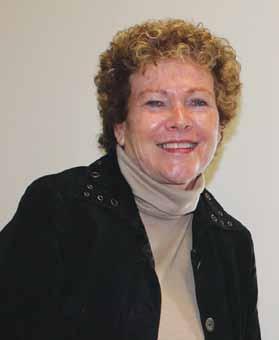
The human and social Dynamics (hsD) research and innovation Focus Area at CPUT intersects with United Nations sustainable Development Goals 1, 2, 4, 5, 8, 10 and 16. These address an array of social, economic, political, scientific and technological issues, stimulating multidisciplinary thinking and challenging researchers, industry and policy developers to answer existing questions, create new disciplines and develop new technologies.
We aim to contribute to a greater global understanding of shifting social dynamics, to support multidisciplinary collaborative research and to respond to the vulnerable and marginalised groups in society. This focus area’s challenge is to integrate strong theoretical and empirical links, enabling the ensuing multidisciplinary research approaches to:
• Promote and support social science and humanities research that is central to knowledge production
• Develop more appropriate leadership, curricular, pedagogical interventions and practices
• Accelerate social development, especially the empowerment of marginalised and vulnerable communities
• Stimulate the creation of the next generation of scholars in social sciences and humanities in South Africa
In addition and more specifically, the word ‘technology’ in the title of our university provides us with a special focus in research into human and social dynamics. ‘Technology’ necessarily entails a close relationship between the university and society, including working life. Social science research in a uoT would then, firstly, serve to problematise and improve the relationship between university curricula and practices and those of broader society, for example through work-integrated learning initiatives such as practicums and projects. Secondly, research can highlight how technology and new ideas may be taken up by society in different ways (for example, accepted, changed, shelved or rejected), and how changes in technology and organisation can be harnessed for the benefit of society.
condyj@cput.ac.za
honorary Doctorate in Public Management recipient Mildred Mandu Ramakaba Lesiea has spent most of her life serving others. At the age of 16, she found work as a domestic after being forced to drop out of Standard 6 at Kensington High School. Joining the ANC in 1954, she steadily matured as a leading anti-apartheid struggle activist in the Western Cape. Much of her attention was focused on inequalities in the education system and she dedicated years of her life to the fight against Bantu education. The pinnacle of this fight was her activism during the 1976 uprisings. “Some of the students of 1976 are part of this audience and others are working at this university. I am so proud of the 1976 generation,” she says.

Dr Lesiea told the audience that the honorary Doctorate was a dream come true. “I am receiving this award on behalf of those who travelled that road of sacrifice, discipline and commitment in the struggle for a free and just society,” she said. Dr Lesiea says her duty was now to pass the baton on to a younger generation to continue to eradicate poverty, unemployment and inequality. “Of critical importance is that the youth forms a major part of this nation. It is our responsibility to inculcate in them a sense of patriotism, pride, equality and responsibility. They are our future.”
This year, CPuT honoured recipients of in-house and external teaching awards at one event. Normally, only the winners of the Institutional Teaching and Learning excellence Awards would be lauded in this way, but this year the honour was extended to faculty awardees, Teaching Advancement at University (TAU) fellows and the CPuT winner of a 2017 National excellence in Teaching and Learning Award.
This year’s winners are Dr Muhammad Nakhooda (Faculty of Applied Sciences) and Dr Mark Marais (Faculty of Health & Wellness Sciences). Mr Siddique Motala from the Department of Civil engineering & Surveying received the national teaching award from the Council of higher Education (CHE) and the Higher Education Learning and Teaching Association of South Africa (Heltasa). Dr Nakhooda together with Dr Hanlie Dippenaar (Faculty of Education) and Dr Xena Cupido (Fundani CHED) are TAU fellows, while Ms Ayesha Toyer was recognised by the Faculty of Informatics & Design for her teaching skills.
Good teachers are often not given the recognition they deserve, according to Prof Anthony Staak, DVC: Teaching & Learning. his co-host, Prof James Garraway from Fundani CheD, expressed the hope that this would eventually become an annual fixture on the university’s events calendar.
Dr Leseia was honoured for her lifelong commitment to a democratic South Africa.
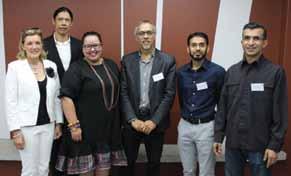
A book which raises fundamental questions concerning issues of social justice and linguistic rights was launched during the Language Indaba in June. The book is grounded in key interdisciplinary issues relating to multilingual perspectives, academic literacy, language as a resource and rights in education, language policy, planning and implementation, language in professional contexts as well as language practice. Titled African Languages and Language Practice Research in the 21st Century, the book was edited by four CPuT academics, namely, Prof Monwabisi Ralarala, Prof Ken Barris, Prof Eunice Ivala and Dr Sibawu Siyepu.
“This volume was born out of a collection of papers presented at the African Language Association of Southern Africa’s 18th International Conference, hosted by CPuT in 2015,” says Prof Ralarala. he adds that the book addresses fundamental questions such as what kind of justice is meted out when the language of the accused, or witnesses, is poorly translated into english, or even distorted by the police officers or an interpreter. Another question is how do students who are rural speakers of isiZulu or isiXhosa cope with an academic environment dominated by english? “These questions, in one way or another, concern matters of social justice and linguistic human rights; and the answers realised between the covers of this book show whether we stand at a border that can be safely crossed, or before a barrier that simply cannot be negotiated,” says Prof Ralarala.
A new book edited by four CPuT academics
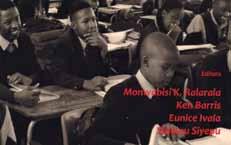

A ground-breaking research project which looks at how factors such as race, gender, class and language intersect to create inequality among university students is planned. The three-year project involves a team of academics from four universities exploring how these demographic characteristics combine to create inequalities among students and whether universities perpetuate these. The team comprises CPuT academics Prof Lungi Sosibo, Dr Agnes Chigona, Dr Misiwe Katiya and Dr Daniella Gachago, as well as Dr Lorna Dreyer (SU), Dr Sadhana Manik (UKZN) and Prof Vuyokazi Nomlomo (UWC).
Funded with R661 975 by the NRF, this is the second NRF grant that Dr Sosibo, the team’s leader, has been awarded in succession. “Working on this multisite and interdisciplinary project, we are a team of experts in the different areas of language, information and communication technology, and education, as well as diversity and transformation,” says Dr Sosibo. “Our research outputs will include articles in journals accredited by the DheT, papers presented at peer-reviewed conferences, book chapters as well as master’s and doctoral graduates.” She adds that the collaborative nature of the project makes it a unique experience as each participant brings a different perspective based on the history of the university and personal background. “The project will be enhanced by the team’s diversity as we boast both intermediate and established researchers.”
Prof Nomlomo says the project talks to her passion as she has worked extensively with language in education. “I’m excited about collaborating with colleagues from other institutions, to arrive at a broader perspective on higher education, its past, present and future.”
to improve their skills in presenting physical education as part of Life Orientation in their respective schools. This initiative forms part of the Caring Society (CASO) 3.0 Consortium, a project that aims to improve South African healthcare through knowledge exchange. The project involves CPuT partnering with uCT, uWC and several european institutions, including Avans university of Applied Sciences in the Netherlands, the Finnish Lahti university of Applied Sciences and Karel de Grote Hogeschool in Belgium.
CPuT recently hosted Ms Theresia Bauer, Minister for Science, Research and the Arts in the German federal state of BadenWürttemberg, accompanied by representatives from 24 German institutions of higher learning. “We are looking to intensify our ties with Africa through stronger partnerships with African institutions like CPuT,” said Ms Bauer.
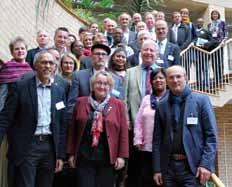
Prof Anthony Staak, DVC: Teaching & Learning, thanked the state minister for “highlighting opportunities and expressing a willingness to collaborate”, explaining that current partnerships tend to concentrate on exchange programmes and emphasising the benefit from the “increasing tendency worldwide towards the development of professional master’s degrees”.
Prof René Pellissier, Director: RTI Strategic Initiatives & Partnerships, offered one of many informative presentations to the delegation. Sketching an outline of CPuT, she mentioned that internationalisation was increasingly in focus at the university, and that in this regard “collaboration with european institutions is very important”.
The Sport Management Department aims to help strengthen physical education in disadvantaged primary schools in the Kensington area of Cape Town. The department is developing an educational module for physical education, with the primary aims of building the capacity of students to work in the school environment, and providing school educators with an opportunity
CPuT lecturer Mr Chris Young, who coordinates the programme, says his team will work alongside colleagues from the Western Cape College of Nursing, with staff members from each department focusing on specific areas of the project. Participation in the project, which will run until 2019, allows CPuT to contribute to international knowledge development in the field of community healthcare, as well as the internationalisation of students through placements abroad. Mr Young says the programme is part of the EU’s Erasmus+ Capacity Building in Higher Education programme and has been funded with over €800 000.
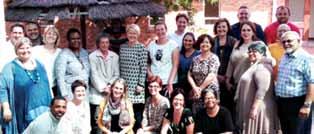
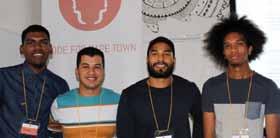
CPuT Information Technology students are sharing their knowledge and helping to excite the next generation of female IT specialists through a unique programme. The students were selected as facilitators by Code4CT, a programme which aims to empower young African women by exposing them to career opportunities in Science, Technology, Engineering and Maths (STEM), and encouraging them to leverage technology for social change. Ms Prima Inderlal, WIL Co-ordinator for CPuT’s IT Department, initiated the collaboration with Code4CT. Ms Andrea Petersen of Code4CT said the organisation recruits facilitators who are enrolled in a STeM field as well as those who have a working knowledge of using hTML, CSS and JavaScript to create websites and mobile applications.
During the April holidays, the students served as facilitators for the Intro to Coding module for Grade 10 learners as well as for the Front end Development and Data Science Modules for Grade 11 learners. Ms Petersen said Code4CT’s programme runs until December and the facilitators have been invited to teach in any or all of the modules. She said the students completed three days of training earlier this year, which focused on what it means to be a Code4CT ambassador, on curriculum & LMS (Learner Management System) training, as well as classroom conduct and crisis management. She added that students would benefit from being part of the programme in several ways, including exposure to the local tech industry through various speakers who attend these classes and events, increasing their knowledge of web development and having their CVs shared with local tech companies with which Code4CT has connections.
Prof Yusuf Sayed

sayedy@cput.ac.za
The sARChI Chair in Teacher education, with Prof Yusuf sayed as the Director, established the Centre for International Teacher education (CITe) in 2014 within the Faculty of education at CPUT. The rationale was to bring together a team of researchers to analyse the gap between policy and practice within teacher education in south Africa, and to build institutional and national capacity to generate empirical research in the area.
The SARChI Chair and CITe seek to generate knowledge of how teachers and their teaching influence the provision of quality learning, especially for learners from disadvantaged backgrounds in South Africa. The research chair was created to facilitate the generation of basic and applied knowledge about the form, content and influence of teacher professional development. A further goal of the chair was to develop the knowledge base and field of teacher education, and to invest in the development of research capacity among a pool of researchers working in the area. The main objectives of the SARChI Chair in teacher education are thus to develop ways of understanding why practice does not match policy within teacher education in South Africa, and to build national and institutional research capacity in the field of teacher education.
When established, CITe had five designated research projects:
• A longitudinal study of initial teacher education in South Africa
• Research about continuing professional development in South Africa
• A study of teacher professionalism in South Africa
• The use of assessment for learning by teachers to improve teacher competence and student learning
• A cross-country study of teachers as agents of peace and social cohesion in Rwanda and South Africa
however, as the centre and its research grew, decisions were made to reduce the focus on certain projects and to expand others. This was done with the Teachers and Social Cohesion and other externally-funded projects in mind, to strengthen CITe’s goal to be more continentfocused and solidify emerging partnerships in the southern African region. The various projects have enriched and deepened knowledge about the impact of the full cycle of teacher education on teacher performance and student learning, with completed research adding to knowledge about what motivates students to enter teacher training, what makes for effective training, what the relationship is between training and practice after graduation, and what roles Continuing Professional Development (CPD) programmes might play in enhancing teachers’ knowledge and professional skills. These are important issues that have not been examined in a sufficiently robust or longitudinal manner in the South African context. They are being explored by CITe in a phased way over a number of years and outputs. The project informs a forthcoming book based on the multi-year ITe study at four higher education institutions, called Becoming a Teacher. This will be published in 2018.
Secondly, the research focus areas have collectively sharpened understandings of links between policy intentions and outcomes, and enhanced knowledge about what ‘works’ and under what conditions. Much of CITe’s completed research has grappled with the assumptions that underpin current teacher education policies in South Africa and the implementation and effects thereof. This is best exemplified in the interesting and complex findings that have emerged from the DFID/ eSRC-funded project on Teachers and Social Cohesion in South Africa and Rwanda, and that have enabled CITe to ask challenging questions of policy makers and practitioners about their thinking and practice with regard to promoting socially just communities.
Thirdly, CITe has been able to locate the specificity of South African teacher education within a global context, offering a variety of considered and meaningful comparisons that it believes will advance key debates. In terms of dissemination, CITe has shown the impact of its research through engagement with policy makers and public media, and by knowledge sharing at national and international conferences and symposia.
In 2017 CITe produced the following research outputs:
• Seven articles in peer-reviewed journals
• Five book chapters
• Two books, one on Initial Teacher Education (ITE) in South Africa, the other on Continuing Professional Development (CPD) in Sub-Saharan Africa
• Two technical/policy reports: i) Research Country Report for ESRC; ii) Research Country Report on the PBeA Project for uNICeF
• 13 papers presented at conferences (two at international conferences)
• Five keynote/plenary addresses delivered by
the chair: i) Report of the Ministerial Task Team on discrimination in textbooks to the National Consultative Forum, DBE; ii) Dialogue with the Minister of Basic education
A key component of the work of the SARChI Chair and CITe is nurturing a new generation of postdoctoral fellows, master’s and doctoral students in the field of teacher education. The SARChI Chair and CITe are currently mentoring two postdoctoral fellows, eleven doctoral students and two master’s students. CITe has to date graduated three postgraduate students and mentored three postdoctoral fellows.
FACuLTY OF eDuCATION
The purpose of the Literacy Development and Poverty research unit is to investigate, monitor and assess the educational and socio-economic factors that influence learning in disadvantaged communities in the Cape Flats, and to find possible reasons for low scholastic achievement. The project seeks to deepen understanding of the intersectionality of race, class and disadvantage in the context of schooling for poor children. A key objective is to bridge the current policy-practice gap in literacy development in south Africa and contribute to evidence-informed policy making. The overarching international collaborative project (Cape Town, New York, Perugia) interrogates the literacy realities and experiences of youth. The entire socio-linguistic initiative is impelled by the notion of ‘narrating the voices of poor children’.
Prof Rajendra Chetty
chettyr@cput.ac.za
South Africa is a world apart with two education ‘systems’, namely, well-resourced schools for affluent middle-class children, and schools in the townships that enrol the vast majority of poor and workingclass children. The health, economic and community difficulties faced by these children, coupled with deficiencies in their school ‘system’, produce learners who read mostly at the functional level, write without fluency or confidence, and use inappropriate concrete techniques with numeric operations. The schools in high poverty communities reproduce race and class
inequalities. In our analysis of post-apartheid schools we make use of cartographic representations, featuring the movement to effective schools outside the townships, the journeys to a better quality education in the suburbs and the aspiration to escape poverty and disadvantage on the part of those learners who gain access because of their parents’ ability to pay high school fees.
An empirical study was successfully completed with ten schools in the Cape Flats, where the voices and experiences of literacy teachers were investigated. The key finding was the almost total absence of cognitive activity in the literacy classrooms, a factor which points to an education system trapped in the transmission model of teaching and learning or what Freire calls ‘banking education’. The challenge for teacher training, given the imperative for equity and the transformation of a post-apartheid and racialised society, is to construct literacy education in ways that promote critical thinking skills. Investigation of the out-of-school literacy practices of learners in contexts marked by poverty has led to data collection and journal publications on a wide range of social issues (school violence; gangsterism; drug addiction; human trafficking; narratives/voices and the holistic personal transformation of youth).
Community engagement is integral to the unit, given the fact that inequality in the social system based on race and class is an observed and demonstrable cause of
low literacy levels. Activities included parental support for literacy learning, gathering the narratives of young people on social factors affecting scholastic achievement, holding workshops on identity and self-esteem issues, and fostering and enhancing parents’ reading skills in informal settlements.
Collaborative initiatives were forged with Jolly Phonics (UK) for the provision of literacy resources to poor schools and the in-service training of ten Foundation Phase teachers in literacy development. The unit collaborated with equal education in the social audit on the safety and sanitation crisis in Western Cape schools and hosted a seminar on the findings, titled ‘Of loose papers and vague allegations’. We participated in two policy development initiatives with the Department of education and Training, namely, the National Senior Certificate for Adults (NASCA) and the General education and Training Certificate for Adults (GETCA). We served on the working group that developed the curriculum (English) for the NASCA and GETCA and wrote the english workbook for the NASCA.
International collaboration in the field of literacy, class and race was established with Nathalis Wamba (Queens College), and a chapter on ‘Decolonial turns in African universities’ has been completed. Prof Chetty facilitated seminars on ‘Postcolonial theoretical constructs of marginalisation and exclusion’ as visiting professor to the university of Perugia. International visitors to the research unit included David Gerwin and postgraduate students from
the City University of New York (Queens College); Prof Chris Knaus and postgraduate students from the University of Seattle, Tacoma; Prof Jaspal Singh from the University of Northern Michigan; and Dr Renato Tomei from the University of Foreigners, Perugia. As part of a research exchange programme, a doctoral candidate in the unit, Dominique Fagan, participated in the ‘Complicated Conversations’ workshop series at Queens College. her presentation was entitled ‘From city to township: Opportunities and challenges in urban education across global contexts’.
Milestones for the unit in 2017 include the publication of ten journal articles on social issues that impact education, covering aspects of race, class and schooling for poor children. Two chapters on research methodology were published and a monograph on a South African writer was completed. Two doctoral candidates (L Meyer and G Joubert) and an MEd student (J Stead) completed their studies in 2017. The unit, in collaboration with the english Academy of SA and with funding from the National Lottery Board, hosted an international conference: ‘Decolonial Turns, Postcolonial Shifts and Cultural Connections’. Keynote speakers included Elleke Boehmer (Oxford), Harry Garuba (UCT), Mastin Prinsloo (UCT), Jaspal Singh (Michigan), and youth activists from #Rhodesmustfall and #feesmustfall. Keynote addresses were delivered by Prof Chetty at WITS (‘Decolonising the curriculum: Approaches and responses to decolonisation and transformation’); and UJ (‘Dismantling the master’s house: Theoretical construct on curriculum decolonisation’).

FACuLTY OF eDuCATION
In 2017, Prof winberg was awarded three research grants (in addition to the south African Research Chair). she was awarded an NRF/swedish Foundation for International Cooperation in Research and higher education (sTINT) three-year grant on ‘science, technology, engineering and mathematics (sTem) pedagogical competence’ (Ref sTINT 160829186851). she was also awarded a three-year grant on engineering-in-Context under the Department of higher education and Training’s (DheT) existing engineering education Capacity enhancement Programme (eeesCeP), funded by Newton and the Royal Academy of engineers. she was awarded a one-year continuance on her DheT National Collaborative Teaching Development Grant on a National Postgraduate Diploma in higher education Teaching and Learning, and received an NRF incentive grant for rated researchers.
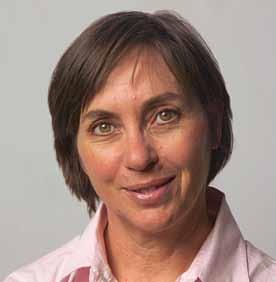
Prof Christine Winberg
winbergc@cput.ac.za
Prof Winberg continued as leader of the WorkIntegrated Learning Research unit, which celebrated its 15th Anniversary in 2017. WILRu hosted a regional colloquium on Decolonising the Curriculum, with Prof Arie Rip (Emeritus Professor at the University of Twente, The Netherlands) giving the keynote address. Prof Winberg and WILRu colleagues hosted visiting scholar Dr Thomas Olson (University of Lund and Swedish Principle Investigator of the STeM pedagogy project), as well as Dr Jeff Waldock, Prof Mike Bramhall, Dr David Greenfield, Dr Patrick Johnson, and
Dr Oliver Lewis (Sheffield Hallam University), who are co-researchers on the engineering-in-Context project. Together with the research partners, Prof Winberg and the WILRu team published seven articles in journals, books and conference proceedings, guest-edited a special issue of the South African Journal of Higher Education on the ‘ethics of Care’, presented papers at a number of conferences locally and internationally, and were invited to present workshops and seminars at several institutions. Prof Winberg was a keynote speaker at the Legitimation Code Theory Conference at the university of Sydney in July 2017. She was also accorded the honour of election to the Ministerial Oversight Committee on the Transformation of higher education in 2017, for a three-year term.
Prof Winberg and WILRu team members serve on a number of scholarly journals’ editorial and review boards, serve on CPuT and NRF research committees, and undertake the peer review of research applications and journal submissions. In 2017 there were five master’s and five doctoral candidates supervised by the WILRu team. Ms Maryna de Lange, an NRF/SARChI funded MEd student, graduated in December. Dr Karin Wolff, an NRF/SARChI funded postdoctoral scholar, published five articles in 2017. WILRu is extremely proud of the work of the postgraduate scholars, who contribute to the development and sustainability of WILRu and whose work is growing the field of WorkIntegrated Learning nationally and internationally.
The eTDP seTA provided funding to CPUT to establish a Research Chair for work-Integrated Learning (wIL) and Recognition of Prior Learning (RPL) in August 2015. The agreed focus of the chair was that there would be three research projects up to march 2018:
1) The 2016 project would focus on the identification of current WIL practice and the WIL staff development needs of TVeT college lecturers
2) The 2017 project would focus on research into and facilitation of the development of WIL components of staff qualifications, in response to the researched staff development needs
3) The 2018 project would focus on the investigation of eTDP SeTA-funded RPL practices and processes with the purpose of developing best practice models for RPL in relation to WIL
The research findings from the 2017 project highlighted a growing interest in the development of new heQSF-aligned staff qualifications that have WIL components, particularly for TVeT college staff. This interest was generated by the publication of the 2013 policy on Professional Qualifications for Lecturers in TVeT which requires TVeT staff to do schoolbased teaching practice as well as industry-based WIL.
While the interest of the eTDP SeTA was in the development of WIL components for TVeT staff qualifications, the national Teacher education Directorate of the DheT, in partnership with
the eu, also invited funding proposals for the development of TVeT staff qualifications that have WIL components, with the purpose of building the capacity of staff in the education faculties at higher education institutions in South Africa. The DheT regards the preparation of staff in education faculties as crucial as these faculties are expected to offer qualifications to TVeT college staff by 2020.
The decision that was taken by the DheT, eTDP SeTA and CPuT was that the DheT Project on WIL programme development should focus on the initial teacher qualifications of TVeT staff, while the focus of the WIL programme development project of the eTDP SeTA should be on continuing professional development.
The following two qualifications were suggested as the focus of the eTDP SeTA WIL Project:
Qualification
Advanced Diploma in education in Work-Integrated Learning (ADE-WIL) (which replaces the Advanced Certificate in education [ACe] qualification and aims at developing WIL specialists)
Postgraduate Diploma in education with a WIL specialisation (PG DIP Ed [WIL])
Industry/specialised workplace WIL credits (as per policy framework)
82 credits
Prof Nothemba Nduna
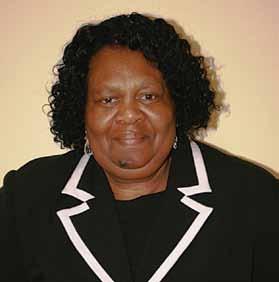
ndunaj@cput.ac.za
82 credits
These qualifications were discussed and conceptualised by the national WIL Committee and selected members of the Programmes and Qualifications Committee of the South African Technology Network (SATN) at two workshops held in Cape Town and Johannesburg.
The research findings on the development of WILrelated staff qualifications indicated that the DheT WIL project should focus on the development of the following TVeT and ACeT staff qualifications.
Qualification Industry/specialised workplace WIL credits (as per policy framework)
Advanced Diploma in Technical and Vocational Teaching (TVT)
8 credits (2 weeks in a workplace for technical and vocational specialisations)
Diploma TVT 36 credits (9 weeks in a workplace for technical and vocational specialisations)
Bed TVT 64-80 credits (16-20 weeks in a workplace for technical and vocational specialisations)
Advanced Diploma in Adult and Community education and Training (ACET)
8 credits (2 weeks in a workplace)
Diploma ACeT 36 credits (9 weeks in a workplace)
Bed ACeT 64-80 credits (16-20 weeks in a workplace)
The staff in the education faculties of 14 South African universities participated in the development of these qualifications.
For both the DheT and eTDP SeTA national programme development projects, a decision was made to develop the WIL curriculum framework for all the qualifications collaboratively and allow each higher education institution to adapt the framework to suit its own context and quality management requirements. It was also decided that the developed WIL curriculum framework would be presented to different stakeholders for input and be refined according to the feedback.
In relation to the policies, the research revealed that the policy that had triggered action and generated interest in staff development in the TVeT sector was the 2013 Policy on Professional Qualifications for lecturers in TVET (RSA, 2013). This policy requires TVET staff to be competent in both school-based teaching practice and industry-based WIL.
• The 2017 research project resulted in interaction with the D he T’s national teacher education directorate and staff of e ducation faculties from 14 participating universities, especially the u oTs.
• The research generated discussions with various national constituencies of the ETDP SETA (e.g. TVeT Chamber, higher education Research Chamber, The Provisioning Chamber)
• The research also resulted in CPUT’s international participation as the Research Chair’s work was presented and published in conference proceedings of the World Association for Cooperative education held in Thailand in June
• The research attracted funding from both the DheT and the eTDP SeTA and generated increased research interest in TVeT college staff development
• The ETDP SETA Research Chair produced seven research outputs in 2016/17 (refereed conference proceedings, refereed journals, book chapters)
• Two students graduated with master’s qualifications

The Centre for Tourism Research in Africa is the research hub for SeTh, which encompasses four departments in the Faculty of Business & Management Sciences: Sport Management, events Management, Tourism Management, and hospitality Management. Its mandate is to highlight CPuT’s contribution to tourism and hospitality teaching and research in Cape Town, the Western Cape, South Africa and internationally. In addition it facilitates research activities in the tourism, hospitality, sport and events fields to bring together university researchers/lecturers and practitioners domestically and internationally to find answers to applied research questions. CeTRA also encourages focused research clusters incorporating researchers and students from various CPuT departments and from outside the university.
FACuLTY OF eDuCATION
Izak
smiti@cput.ac.za
WISh is a development initiative funded by the British Council and the NRF. early career researchers, educators, practitioners, employers and policymakers from the UK and South Africa are brought together to develop realisable projects that increase the quality, range and opportunities for diverse students in and beyond the creative industries. WISh is managed by CPuT and the university of east London and aims to:
• widen access to higher education

• increase participation within higher education
• ensure student success and enhance employability
A multidimensional and integrated exploration of inequalities in south African higher education: effects on students
This multi-institutional project investigates how inequalities intersect and feed on one another to adversely affect students from marginalised groups. It further examines how inequalities manifest themselves among students from various backgrounds (race, class, gender,
ethnicity), as well as how HEIs perpetuate inequalities among students by producing and reproducing them. The research questions that this project purports to answer are: What manifestations of inequality are there among students in the selected heIs? how do these inequalities intersect and feed on one another? What intellectual, academic and psychological effects do they have on students from different (racial, cultural, ethnic, geographical, socioeconomic and gender) backgrounds? What efforts do heIs make to address and redress these inequalities, and are these strategies sufficiently coherent and integrated to yield sustainable improvements in students’ lives?
There is a trend towards design thinking and learning design both locally and abroad. Design thinking as a methodology for developing novel solutions to complex real-world problems is gaining popularity in various domains. For many years design thinking provided a useful approach to innovation in business, health, software development and engineering sectors, but only recently is it gaining ground in the context of higher education innovation. Learning design implies that learning innovation starts with ‘wicked’ problems that
need holistically designed interventions. The project is aimed at designing and evaluating an academic staff intervention on blended learning course design, applying and promoting design thinking principles among academics.

Based on a changing student population, the demand for flexible, part-time course offerings is increasing globally and nationally. Recently, CPuT introduced two flexible learning courses which offer an online component to broaden access, namely the blended part-time BTech: Architectural Technology and the online National Diploma: Real estate. These two courses will be the focus of this study, aimed at identifying the main learning design principles common to both. Any tensions and contradictions will be considered to identify areas for improvement. In addition, these principles may be employed to design future flexible learning interventions.
educational resources are shared freely under various common and open licensing formats. This allows students the opportunity to access quality educational resources to assist in the learning process. This project deals with development of the academic skills of lecturers to enable them to produce such resources, to be hosted internally at CPuT.
This year, the Centre For Innovative educational Technology received R121 000 in funding from RIFTAL, and R23 226 from Confcom.

wests@cput.ac.za
The hPL, housed in the Department of sport management, provides the space and cutting-edge technology to pursue research and enhance education and technical training in terms of human performance in sport and related activities, including ergonomics.
The Department of Sport Management has joined the Western Cape provincial Wellness! (WoW!) initiative, which is a collaborative project involving all the universities in the Western Cape, the Western Cape Department of health and a number of commercial and non-profit organisations. The initiative comprises several integrated components aimed at promoting health and wellness. Dr Taliep, Dr West, Ms Venter and Mr Young are spearheading the project, which involves a peer-to-peer learning programme in schools to assist pupils and educators in promoting health and wellness. The project aligns with the learning activities of students during their community engagement project at third-year level.
The hPL provides a rehabilitation service linked to research activities, the most prestigious being rehabilitation work with the exoskeleton suit designed for the use of people with spinal cord injuries, to provide rehabilitation for walking. The project started in 2016 and the hPL was featured on Carte Blanche for the cutting-edge work being done in this field.
Dr Sharhidd Taliep talieps@cput.ac.za
In collaboration with uCT, Dr Sacha West is investigating the effects of exoskeleton walking on muscle tone, muscle function and general health and wellness.
Collaboration between the hPL and Western Province Cricket Association continues, with ongoing research and analysis of illegal bowling. Dr Taliep, who heads the Western Province Cricket Association Illegal Bowling Analysis Committee uses high-speed cameras for bowling analysis and works in collaboration with coaches and umpires in the Western Cape to analyse reports and rehabilitate players with illegal bowling actions. The project is a collaboration between the Department of Sport Management and the exercise Science and Sport Medicine unit at uCT, where equipment and technology are shared for the benefit of the sport.
since 2016, the Faculty of Business & management sciences has supported this Research and Innovation focus area by adopting the outcomes associated with the RTI strategy that supports the ideals, vision and goals of south Africa’s National Development Plan as well as the western Cape government’s strategic objectives. Four niche areas were identified within this focus area with the following niche area leaders:
• Skills development – Dr L Gie
• Tourism and events – Dr S Manners
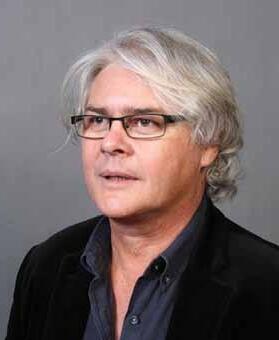
• Marine economics – Prof S Hosking
• Small, Micro, Medium Enterprises (SMMEs) – Dr R Tengeh
The progress and status of the completed projects identified in each of the four niche areas are presented hereunder:
Niche Area: Skills Development, h uman Resources Department
PROJeCT 1
The role of students and alumni in relationship marketing: An exploratory study at the Cape Peninsula university of Technology, South Africa
Output: universities seek alumni for ongoing support and therefore should attract, maintain and enhance ongoing relationships with alumni. The objective of this study is to examine the perceptions of senior students (at CPUT) in respect of the university’s efforts to attract, maintain and enhance ongoing relationships with students (and eventually alumni).
PROJeCT 5
Perceived challenges to talent management in the public service: A case study of the local government municipality
Output: Poor talent management practices within the public service, and more specifically the local government municipality, lead to high staff turnover rates, which affect the public service’s ability to deliver on its mandate to the public.
Niche Area: Marine e conomics
Three projects, funded by the Department of environmental Affairs: estuary management, hF Radar investment and Ocean sector contribution to GDP.
ballardh@cput.ac.za
Research on estuary valuation and management in urban settings is being undertaken using the case study of two estuaries in the region of east London. Research on the economic motivation for a South African coastal high frequency (HF) radar facility is being undertaken.
Development of the tourism and hospitality industry for economic growth in the Western Cape region is regarded as a provincial and a national imperative. Research areas identified with the aim of stimulating growth in this industry are the following:
• To identify best practices that enable potential impacts to be realised and develop mega event management guidelines
• To encourage and attract more visitors to the museum so as to supplement the decrease in government funding
• To establish the profile and motives for a retro surfing event
• To identify visitors’ information needs, preferences and personal experiences in relation to undertaking the Robben Island museum tour
• To determine the status of employment in the tourism sector (who is employed, at what level, experience and service, salary scale, qualifications and skills and provincial location)
• To determine the forms of benefits accruing to communities located adjacent to the Table Mountain National Park
The NDP proposed inter alia that the employment strategy be focused on SMMe development, with a vision of mass entrepreneurship and deregulation, with export growth providing the impetus for growth and employment. Small- and medium-sized firms would be the main employment creators. In view of the foregoing, a project on developing advanced knowledge in the area of immigrant entrepreneurship in the development of retail in Cape Town was undertaken and completed.

Minister of Public enterprises, Ms Lynne Brown, visited CPuT in August to acquaint herself with a number of research innovations and how they can address some of SA’s urgent needs. The event was a prime opportunity for researchers to engage directly with Ms Brown and her officials from State Owned enterprises (SOE) like Transnet and Eskom about the technologies being developed here. The four-hour engagement was facilitated by the Advancement Department and covered everything from bursary and training opportunities to some of the challenges faced when dealing with SOes.
The delegation was also introduced to CPuT innovations at a mini showcase featuring the Agrifood Technology Station, F’SATI, the Technology Station in Clothing and Textiles and the AAMTL. Acting VC Dr Chris Nhlapo says CPuT was ready and willing to fill any gap that SOes identified and was primed to take the country forward with Ms Brown’s ministry. “CPuT has already signed agreements with many SOes and the question we have here is how we continue to grow these partnerships,” he said.
Ms Brown was candid about a number of pressing challenges hampering greater economic growth, including renewable energy, port efficiency and less reliance on international companies to do work that locals could be trained for. “If you don’t have skilled labour, you don’t have an economy that grows,” she said. “That is when you see the easy option being taken, which is bringing in an international company to do the work.”
thinking in South African universities for the benefit of society. “universities must not be viewed as institutions that only produce graduates but must be relevant to society by playing a role in enterprise creation, poverty alleviation and the development of the South African economy,” says Mr Lombard. “entrepreneurship must become a systematic part of how we do business. This will help us fulfil our role in South Africa.”
CPuT has been selected to participate in an international project that will help universities conceptualise an entrepreneurial vision and implement it in order to benefit the country. eMISha, short for entrepreneurship, Modernisation and Innovation in South Africa, is funded by the EU and forms part of the Erasmus+ Key Action 2: Capacity Building in higher education programme. The project is one of six Erasmus+ Capacity Building projects in which CPUT is currently actively involved. Partners in the projects include heIs and various organisations from europe and South Africa.
Business Manager at CPuT’s TTO, Mr Chris Lombard, who is a key participant in eMISha, says the vision of the project is to co-create holistically relevant universities through innovation and entrepreneurship, with the aim of embedding entrepreneurial
Mr Lombard says while there are various entrepreneurship-related initiatives running across CPuT departments and units, this project will look at pulling all role-players together with the objective of creating an institutional entrepreneurial vision. “The focus is on a culture change in CPuT towards entrepreneurial thinking.” For example, he says that graduates should not merely be job seekers, but should have the mindset of a “job creator,” while research must be relevant to society, addressing pertinent issues.
The eMISha project is set to run over a two-year period and will entail workshops, as well as staff site visits to the various participating european institutions. It complements CPuT’s RTI Blueprint, a strategic policy document that guides CPuT’s research and innovation activities. The RTI Blueprint advocates the production of research and innovation that is relevant and aligned to the needs of the province, the country, the continent and the world, through knowledge discovery, excellence in teaching, and service.
CPuT received R21.2 million in accordance with an Mou concluded with the Construction SeTA (CETA) in August, bringing the total investment by CeTA since 2013 to R34.4 million. This latest grant resulted in a further 90 CPuT students being taken up in the very successful Work Integrated Learning (WIL) programme and 100 receiving bursaries. The beneficiaries are students qualifying in Built environment disciplines.

Acting DVC: RTI&P, Prof Marshall Sheldon, encouraged beneficiaries of the grants to “grab these opportunities with everything you’ve got. We will support you in any way we can and want to see you mentoring the students that come after you”.
Mr Raymond Cele, Board Chairman of CeTA, remarked that CPuT piloted the WIL programme, which has become the implementation benchmark for its roll-out nationwide. “We see CPuT as our strategic partner for education in the construction sector. Its staff members’ passion for their students is matched only by my team’s passion to see the beneficiaries of these grants succeed.” he says that future plans include:
• Integrated tracer studies into the impact of these programmes
• Establishment of a regional stakeholder forum
• Building the next generation of academics in the sector
It started as a student project, but an innovative tool associated with one of SA’s favourite pastimes has become a great success locally, and could soon find a place in the international market. The Braai Tool (TBT) is multifunctional and incorporates five key braai utensils in one sleek product. The idea was born in 2014 when Industrial Design BTech students were tasked with designing, prototyping, manufacturing, marketing and selling a product they had created for a net profit of at least R5 000. With the help of CPuT’s TTO, TBT’s magnetic hinge and groove system were soon patented.

“We’ve done research into the Australian market because barbecuing is huge in Australia.
So, with the help of CPuT’s TTO, we’ve also filed for a patent in Australia,” says TBT’s Mr Sebastian Bosman. he continues to say that the TTO will also subsidise his participation in the LaunchLab, designed to take entrepreneurs through the process of building a viable company. “The TTO gave us the finance to produce our initial units. They have paid for the patent, both locally and internationally, and they’ve given us great legal advice. They also sent us to Design Indaba, funding our first step into the commercial space.”
• More service-learning projects and community engagement

Braai Tool a great success
Construction SETA developing next generation of professionalsCPuT aims to become even more relevant to society The innovative Braai Tool Prof Marshall Sheldon and Mr Raymond Cele signing an Mou
FACuLTY
The highlight of the year for the wholesale & Retail Leadership Chair (wRLC) has been the publication of nine papers in accredited peerreviewed academic journals, including six in high-quality journals. This was a deliberate goal for the year, which culminated in the publication of a paper in the second-best retail journal (the top retail journal is not interested in our work as it is too ‘geographically parochial’, something we cannot avoid because of the nature of the chair).
Prof Roger Mason
masonr@cput.ac.za
unfortunately, funding for the WRLC came to an abrupt halt at the beginning of 2017 due to numerous internal problems at the W&RSeTA that prevented the renewal of its contract. Furthermore, because of complications arising from the #feesmustfall campaign, CPuT was short of funds and could not meet its commitment to funding previously promised to extend the life of the chair. As a result, this fourth year of the WRLC depended on funds left over from previous years. Thanks to careful management of the chair’s budget, we were able to continue limited operations in 2017, with some funds left over for activities in 2018 on an even more limited scale. Research in 2017 focused mainly on completing projects initiated in previous years. Research projects selected for initiation in 2017 were therefore put on hold pending the release of funds; since this did not happen, the projects remain on hold.
Our international collaborations have continued with visits by departmental staff and students to BadenWürttemberg Cooperative State University, Ravensberg, Germany, and IPAG, Nice, France, and a visit from Prof Dobbelstein from the Baden-Württemberg Cooperative State university. Journal article collaborations have taken place with Prof Dobbelstein, Prof Heidig (AlbstadtSigmaringen University of Applied Sciences, Germany) and Prof HJ Schmidt (Koblenz University of Applied Science, Germany). Negotiations were conducted with the Institute of Retail Studies, Stirling university, Scotland, for that institution to host a visit from our nGap staff member.
The year’s activities and achievements included completion of a number of projects and dissemination of their results, including:
Financing SMMe start-ups and expansion for retail SMMEs; Brand orientation of SA retailers & impact on success; Cooperative relationships: Channel for sustainable women-owned informal retail businesses; Shortage of retail management skills and employment equity strategies in attracting women to careers in rural areas; e-Learning strategy for W&RSETA: Framework for SA retail sector
‘Socio-economic developmental strategies as retail performance indicators: A balanced scorecard approach’ (Development Southern Africa); ‘Financial growth and sustainability in retail SMMes: A study of work-integrated learning policy’ (Risk Governance and Control); ‘A model to operate an on-campus retail store for workplace experiential learning’ (Asia-Pacific Journal of Cooperative Education); ‘Rural entrepreneurship and transformation: The role of learnerships’ (International Journal of Entrepreneurial Behaviour & Research); ‘First choice or fallback option? The attractiveness of South Africa’s retail industry for Gen Y members’ (Problems & Perspectives in Management); ‘Access to finance problems for small retail businesses in South Africa: Comparative views from finance seekers and finance providers’ (Banks and Banking Systems); ‘Does brand orientation contribute to retailers’ success? An empirical study in the South African market’ (Journal of Retailing & Consumer Services); ‘Job creation in the South African retail sector’ (The Retail and Marketing Review); ‘The South African E-Retail change agenda: A curriculum development perspective’ (Electronic Journal of Information Systems in Developing Countries)
e-Learning strategy for retail sector; SMMEs and access to finance; Cooperative relationships; Brand orientation in South African retail; Shortage of retail management skills in attracting women to careers in rural areas
Informal and SMME retailers in South Africa; Retail contribution & strategies for job creation & retention; The nature of existing and emerging cooperatives in the wholesale and retail sector; A model for an oncampus retail store for work-integrated learning; Socioeconomic developmental strategies as retail performance indicators: A balanced scorecard approach; e-Learning strategy for retail sector; Retail as a career choice; e-Retail skills in South Africa; SMMEs and access to finance; Transformation in the retail sector
An e-learning strategy for the South African wholesale and retail sector (e-Learning Africa, 12th International Conference on ICT for Development, education & Training, Mauritius) Practitioner
Cooperative relationships: Channel for sustainable women-owned informal retail businesses (Shopper Insights, Johannesburg)
W&R SeTA has this year awarded bursaries to 316 CPuT students to the value of approximately R30 million. The students in the Retail Business Management Department applied for the bursaries after SeTA invited applicants in an advertisement published in the national media. “SeTA adjudicates the applications and awards based on merit,” says Advancement Director Mr Calvin Maseko. “SeTA then sends a list of the approved students to CPuT before coming to us for verifications.” This included undergraduate as well as postgraduate students. Four PhD students, got a maximum of R250 000 each. “The PhD students are CPuT lecturers, and this is highly appreciated because it motivates staff members to get higher qualifications,” says Mr Maseko. “CPuT greatly appreciates this partnership.”
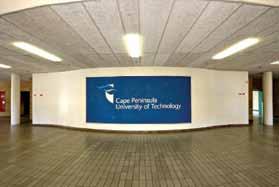
FACuLTY
wARC does research in the knowledge economy, producing outputs which guide industry on decisions relating to search engines, internet marketing and website design.
WARC focussed on two fronts during 2017: first, the role that Internet searching plays in the postgraduate student success rate was investigated; and secondly, various projects were run to investigate financial issues on which search engine optimisation and pay-per-click systems are based.
single-term-searching syndrome, their success rate is still unacceptably low. Suggestions were made regarding an approach to improve searching success.

weidemanm@cput.ac.za
A successful search for academic information depends on the postgraduate student’s ability to search effectively, and this ability is based on computer competency, knowledge of Information Technology (IT), perceptions of IT usage, and the demographics of the user. These characteristics tend to influence the overall user experience.
The main aim of this study was to determine the success rate of postgraduate students using free-form information searching to find academic reference materials. Following a pilot study which indicated that the search success rate amongst postgraduate students is low, primary data was collected. A pilot study confirmed the definition of the research problem. Data was collected from CPuT postgraduate students. The findings of this study indicated that the postgraduate student search success rate has a lower than expected value when using freeform searching for academic information. Furthermore, although postgraduate students are moving away from the
For any online commercial business, the achievement of top rankings on search engine result pages is important, since these rankings have a significant effect on income. Companies often spend a large amount of money on achieving and maintaining high rankings on search engine result pages. It is necessary that ongoing research be done to determine the best way for these companies to split their marketing funds (using SEO and/or PPC) to ensure exposure via the search engines.
Several studies were done on the cost per acquisition and the role of financial expenditure in digital marketing. In one project it was found that SeO provided a lower cost-peracquisition than PPC, and in the long run would offer a better investment. In another, an interesting anomaly was exposed. Although PPC consumes by far the largest expenditure on average, it produces a much lower yield than SeO.
A set of (free) Internet-based tools to test website usability and visibility are available on WARC’s website at: http:// web-visibility.co.za/website-visibility-measurement-toolsseo/
Also, a full digital library with all WARC’s research outputs is available on WARC’s website at: http://web-visibility.co.za/ website-visibility-digital-library-seo/
The primary objectives of the Adaptronics AmTL are to contribute to CPUT’s responsiveness to the needs of industry, and to enable industry to benefit from the specialised knowledge and innovative technologies housed within CPUT. These objectives are realised through institutional learning and development programmes in the form of internships (P1&P2), postgraduate research projects and supervision, and hosting CPUT research and technology projects. The Adaptronics AmTL also develops and implements technology transfer and industry support programmes for its industry clients, i.e. smes and government departments.
The Management of the Adaptronics AMTL consists of Dr Oscar Philander, Director of the Technology Station and Associate Professor in the Department of Mechanical Engineering; Mr Mornay Riddles, Technical Manager of the Technology Station and a Senior Lecturer in the Department of Mechanical Engineering; and Mr Eugene Erfort, Operations Manager of the Technology Station and a Lecturer in the Department of Mechanical engineering. The technology station employs a further 12 technical and administrative staff members. Activity breakdown for the financial year 2017-2018 comprises service delivery (projects, testing, training, product development, etc.), project administration (reports, research, quotations, invoicing, procurement, etc.), and outreach (assessment, audits, marketing, client meetings/interactions). The activity split for 2017-2018 is estimated to have been 68% for service delivery, 28% for administration (10% project administration and 18% general office administration), and 4% for outreach.
The majority of man-hours in 2017-2018 was spent on two projects for the South African Department of environmental Affairs, Directorate Oceans and Coasts: ‘Development of a coastal observer platform for oceanographic and meteorological sampling along the South African coast’, and ‘Development of remotely piloted aircraft systems for APeX predator monitoring and census taking’. The Adaptronics AMTL also engaged in outreach activities with various communities and SMes.
A total of 152% of the target for SMe engagements, as set by the TIA Technology Station Programme, was achieved. The technology station deployed its first Coastal Observer Platform in the first quarter of 2017-2018. This deployment served as a sea acceptance trial. After this, 20 work packages were completed to improve the performance of the platform. Once completed, the platform was redeployed in the fourth quarter of 2017-2018 and is undergoing a second 3-month sea acceptance trial. The RPAS project had its own work packages. The funding allocated for these projects amounted to R5 335 000 for the Coastal Observer Platform Development and R1 665 000 for the RPAS/ Drone development.
Prof Oscar Philanderphilandero@cput.ac.za


Through technology transfer and the diffusion of innovative technologies, the Metals Technology Laboratory (METL) will facilitate strategic projects contributing to the growth of a sustainable Western Cape and South African foundry industry. Launched at CPuT in April, MeTL is a highly specialised unit based in the TIA Adaptronics AMTL. Its activities are aligned with the National Foundry Technology Network (NFTN), a key foundry industry support initiative funded by the DTI.
heading the activities is Mr Llewellyn Cupido, who is a member of the first cohort of South Africans to have participated in the Research and Innovation in Foundry Technology scholarship programme, a DST supported initiative aimed at developing high-end expertise to support the technology and innovation capabilities of the South African foundry industry. Mr Cupido says that SA has a struggling foundry industry and that much more can be done to facilitate the development of a globally competitive industry. “Technology and innovation in the South African industry is lacking. They are able to melt metal into shapes, but the question is how can they make better products using innovative technologies?” he says. “Internationally, the industry has become innovative. We need to innovate to compete internationally.”
Mr Cupido says MeTL aims to expedite projects that will see the introduction of new technology into the South African foundry industry and provide general project assistance, in collaboration with its various partners. The unit has access to a range of capabilities, including state-of-the-art design and product performance simulation (virtual engineering), and casting simulation utilising the software MAGMASOFT. The unit also has the software Thermo-Calc, which is used for thermodynamic calculations such as phase diagrams and for the exploration of thermodynamic properties of chemical reactions.
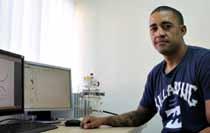
The unit also works closely with the PLMCC, the only centre of its kind in Africa, which focuses on product design, product lifecycle management and system engineering. Mr Cupido says MeLT is currently also involved in several projects, including a collaboration with the China Academy of Machinery Science and Technology. The project is exploring the use of patternless casting technology to reduce production time and cost, as well as the improvement of dimensional accuracies by producing casting as close to the final product as possible. Other projects involve the design and simulation of castings used on power plants, and investigation of the corrosivity of specialty steels used in nuclear structures. Mr Cupido also participated in the BRICS Foundry Forum and visited China this year.
An impoverished community that used to have a thriving clothing industry may see a resurgence in the trade thanks to a CPuT intervention. The Clothing & Textile Technology Station along with the National Screen and Digital Supplies Company trained a group of unemployed Atlantis youth over two days in the art of screen printing. The 26 individuals learnt how to use every-day, cheap materials like a table, wooden board, the sun and a simple squeegee to transform basic items into desirable products like conference bags, branded T-shirts and pillows.
Mr Patrick Nolan says there is a gap in the screen printing industry because most labourers aren’t properly trained to do the job. “You have a scenario where someone works his way up into a screen printing job and is trained by co-workers but they pick up bad habits and there is no proper training,” he says. Prof Shamil Isaacs notes that CPuT has answered a government call to support small and medium enterprises by stimulating innovation capabilities and the entrepreneurial spirit in impoverished communities. “They can go out and sell these services to business. CPuT will then take it further by providing additional services like putting their prints on actual products thereby adding value and eventually they could earn a living from this,” he says. “Atlantis still has a few clothing factories and there are many people who used to work in this industry years ago so this, combined with the fact that our local clothing industry is seeing a spike in interest, could see Atlantis become a clothing manufacturing hub again.”
One of the participants, Mr Garth Blaauw, says he envisions the group joining forces to start a small business which could service local Atlantis businesses. “These businesses and churches are paying other people lots of money for this service, so we could do it and earn a living.”
The TsCT is located in the Faculty of engineering on the Bellville campus. The unit was established to provide innovation support to the clothing and textile industry to improve competitiveness. The following specific services are provided to the clothing, textiles and related sectors.

Examples include manufacturing audits and assessment; industrial engineering services for the improvement of productivity, including process layout, optimising sewing methods and work study; implementation of production systems to improve production; and advice on the acquisition of new or improved technology.
The TSCT has a number of specialised technologies available at its Bellville office for research, technology demonstration, prototype development, and small-scale manufacturing. Small businesses can use the technology on an appointment basis, and staff at the TSCT also provide advice on the application and use of these machines. Charges are levied for the use of the equipment, but this is largely subsidised.
The laboratory at the TSCT provides product testing and an analysis service to the clothing, textile and related industries, as well as clothing and textile-related consulting services, e.g. advice on material usage and care, and fabric specification development.
Services include clothing product development using CAD software for pattern development, pattern grading (sizing), marker making (maximising the material utilisation before cutting), 3D body scanning and 3D simulation on an avatar using data extracted from the 3D body scanner.
Mr Shamil Isaacsisaacssh@cput.ac.za
techstation@cput.ac.za
http://active.cput.ac.za/tsct

Research is about taking a problem and finding suitable solutions to it. This is the mantra of award winning researcher and innovator, Dr Asis Patnaik, who is heading up research activities in the field of technical/smart textiles at CPuT. Dr Patnaik, who has held an NRF C2 rating since 2015, joined the Department of Clothing and Textile Technology this year. A renowned expert in technical textiles, he has extensive experience in working with industrial partners and funding agencies to solve research and development problems, and his efforts have resulted in an impressive 62 publications in peer-reviewed accredited sources and two technology demonstrators.
One of Dr Patnaik’s most notable research ventures resulted in the development of innovative dual insulation (sound and thermal) materials for the building and automotive industries, manufactured entirely from waste plastic bottles and discarded sheep wool. Dr Patnaik says the innovation not only provides consumers with costeffective insulation options but has created business opportunities for local entrepreneurs and sheep farmers. “We want to move away from outsourcing from abroad. Research must also be about creating jobs and empowering people,” he says.
With more than 350 different textiles available in the market, the field of technical textiles is very diverse and not limited to clothing. It extends to textiles and technical textile-based materials suitable for the manufacturing, automotive, medical, building and footwear industries, amongst others. “The term ‘technical textiles’ means textile-based materials used for technical applications. Some examples of such materials are roof ceiling insulation materials, air and water filters, and surgical gowns and face masks used in the medical field,” says Dr Patnaik. “In a car interior, there are about 40% textile materials used for various applications. It can be in the form of seat, carpet or sound absorbing materials generally used behind the bonnet or door panel of the car to absorb the engine and road noise.”
Dr Patnaik says it’s an exciting field and one with endless opportunities to innovate. he is working on several projects, including the design of specialised footwear for diabetic patients and the development of an antimicrobial textile that will be derived from natural resources.
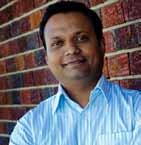
CPuT lecturers have contributed their own time and skills to assist disadvantaged individuals to empower themselves with marketable skills. TSCT, together with the City of Cape Town enterprise Development unit, has been visiting impoverished communities around the Peninsula, informing them about support they could provide.
“On one of these visits, TSCT met up with a group of SMMEs (small, medium and micro enterprises) in Mfuleni that required support,” says TSCT manager Mr Shamil Isaacs. The TSCT developed a six-hour pull-on skirt programme, which enables the SMMes to gain enough basic skills to develop and sew a basic pull-on skirt which they can make to sell. The main objective is to transfer knowledge through university resources to empower disadvantaged communities. This will allow them to create opportunities for themselves and indirectly stimulate a culture of innovation and entrepreneurship. The programme was conducted over two half days at Lookout Hill in Khayelitsha.
Ms Deidre Windvogel, the lab technician responsible for product development at TSCT, provided instructions on how to make a pull-on skirt pattern, and using simple techniques create individual designs and make fit adjustments. Ms Norma Wagenaar, the lab technician responsible for garment technology in the Clothing and Textile Technology Department, took the participants through the paces of sewing the skirt and ensuring that a high, saleable quality standard was achieved.

The motor vehicle manufacturing industry is one of the largest consumers of innovative textile materials. Cars contain enough textiles to cover the floor of a small apartment. Textiles are in everything from car seats, seat belts, carpets, to airbags and roof liners. An average car may contain in the region of 40 m2 of textiles, while other components like door panels, brake pedals and dashboards are made from composites, a combination of textile fibre and resins (glue). The use of textiles continues into the car’s engine (the air and oil filters), and even the tyres. Textiles are perfect for these components because they are versatile, cost effective, lightweight and promote fuel efficiency. Natural fibres like cotton, hemp, flax, silk and wool are more readily available and a lot easier to process than the metals used in car manufacturing, thus making them essential in keeping manufacturing costs low.
“Textiles can be manipulated into various shapes with ease, and the fibres used in them are lightweight, which makes for a lighter, more fuel-efficient vehicle. Also, by reducing emissions these textiles contribute to a healthier environment,” says Dr Asis Patnaik from CPuT’s Clothing and Textile Department. Many of the innovations in car manufacturing can be traced to Formula One racing, where the more conventional use of textiles, in clothing, is also incorporated. The door panels in luxury vehicle are made from carbon fibre composites, which were first used in Formula One cars. The suits worn the by the drivers are also made from material that protects them from the high temperatures and pressures they are subjected to when racing.
“Textiles have a diverse range of applications in automotive and aerospace manufacturing, building, medical, hygiene, packaging, civil engineering, protective clothing, agriculture and sports. It is a unique and exciting area, where many interdisciplinary fields are working together in developing a better world,” adds Dr Patnaik.
The Flow Process and Rheology Centre, founded in 1995, applies the fundamental principles and techniques of rheology to solve industrial problems such as deformation and flow under different shear, material structure and process flow conditions. since its inception the group has produced more than 100 peer-reviewed publications. During 2017 Prof Fester took over leadership of the group in a planned succession development.
The centre’s core activities include:
• Rheological characterisation and modelling of concentrated emulsions, suspensions, solutions and polymer melts and modelling of the phenomena of micro- and nanostructural evaluation involved in the mixing, pumping, transportation and storage processes of multi-phase systems
• Ultrasound Doppler-based in-line rheometry technique for enhanced process monitoring and control of industrial suspensions
• Modelling non-Newtonian flows in pipes, fittings, open channels and pumps
• Instrumentation systems to measure in situ concentration and particle velocity in settling slurry and coarse particle flow and visualisation in pipes and complex geometries
Team members are Prof Veruscha Fester, Prof Irina Masalova, Prof Rainer Haldenwang, Dr Reinhardt Kotzé, Mr Andrew Sutherland, and Prof Raj Chhabra of the Indian Institute of Technology in Kanpur (Adjunct Prof).

The collaboration with AeL Mining Services headed by Prof Irina Masalova was established in 2000. Currently the research focuses on fundamental study of the structure–property relationship of super-concentrated emulsion systems. A very novel rheological model was developed introducing a new shear stability parameter to correlate with the rheological and structural parameters of highly concentrated emulsions.

As part of a WRC funded project, Prof haldenwang, Prof Fester and Dr Kotzé extended the work on the rheology measurement of wastewater sludge. This time a patented in-line rheometer, coinvented by Dr Kotze, was installed in the wastewater treatment plant to measure the rheological parameters in real time for the first time. The instrument was found suitable to measure variations in rheology over time. Furthermore, the effects of belt filter press operating parameters such as polymer concentration, polymer dosing rate and sludge flow rate, and the interactions between these parameters, were evaluated as a function of sludge rheology. Different interactions between the operating parameters were found that had significant influence on the yield stress and filtrate suspended solids, but not for the sludge cake solids concentration. Correlations were developed to calculate two very important parameters for the sludge of the test site, i.e. the yield stress of the sludge just after flocculation (in-line) as well as the filtrate suspended solids based on the polymer dosing rate, polymer concentration and sludge flow rate. To make this practical, a control system for polymer dosing and sludge flow based on the yield stress is proposed, using the correlations developed based on in-line yield stress measurement.
festerv@cput.ac.za
haldenwangr@cput.ac.za
It was demonstrated how significant polymer savings for the belt filter press could be realised through subtle changes in polymer dosing that will have no effect on the system identifiable by operator inspection.
A treatment system developed by a team of innovators at CPuT’s Flow Process & Rheology Centre is set to enrich the textile industry by significantly reducing the amount of potable water used. “We are developing a one-step treatment reactor using locally developed nanopowders for treating textile wastewater. This treatment system offers an almost instantaneous removal of colour from the water,” says the centre’s Prof Veruscha Fester. “This treatment system will not only be able to treat wastewater for disposal to municipal treatment systems, but to a standard suitable for re-use. If the water can be re-used, millions of litres of potable water will be saved.”

Prof Fester is developing the treatment reactor with the centre’s Dr Mahabubur Chowdhury and Mr Gunnar Visser. The laboratory prototype has already been upscaled from 6 L/hour to 72 L/hour. Prof Fester says R4.8 million has been received from the TIA’s Technology Development Fund to upscale the reactor to a 1 000 L/hour industrial prototype in the next year. “The textile industry is really coming on board. Some of the companies use about 2 million litres of water a month so if we can save at least 75 percent of that water to be recycled and re-used on site it will make a huge difference.”
The initial research was also started from TIA seed funding administered by CPuT’s TTO, which has subsequently filed a Patent Cooperation Treaty application. It is hoped that a spin-off company will be formed in South Africa that will provide further social benefits beyond water treatment, including the creation of jobs.
Dr Kotze and Mr Sutherland continued developing the bed velocity measurement for which TIA funding had been obtained. The software interface was improved and ‘evaluated’ against electrical resistance tomography images, and the mechanical design of the instrument was modified a little to allow easier and cheaper machining and assembly, as well as casting of the insulating and wearresistant lining in place around the electrodes. The sensor has the same internal diameter (ID) as the pipeline. It has 16 electrodes located around the inside circumference of the pipe, flush with the pipe wall and in contact with the fluid. The number of electrodes can be custom designed for customer needs, for example if needed only in the pipe invert to detect settling. The electrodes detect the presence and movement (flow or no-flow) of coarse particles and the instrument measures absolute particle velocity at the wall. The current instrument user interface can be custom designed. A planned future development is to integrate the electronics (data acquisition, etc.) with the sensor.
Prof Fester and Prof haldenwang attended and presented papers at the 18th Transport & Sedimentation conference in Prague. They put in a bid to host the 19th T & S conference in Cape Town. This was accepted, and CPuT and Paterson & Cook consultants will co-host the conference in May 2019 in Cape Town. This will be the first time the conference will be hosted outside of europe.
Three journal papers were published by the centre in 2017: ‘Transitional flow of non-Newtonian fluids in open channels of different cross-sectional
shapes’ (J Braz Soc Mech Sci Eng); ‘Yield stress of cement grouts’ (Tunnelling and Underground Space Technology); ‘Sustainable housing financing model to reduce South Africa housing deficit’ (International Journal of Housing Markets and Analysis). Four peer-reviewed conference papers were also produced: ‘Waste water sludge pipeline predictions using conventional viscemetry and ultrasound-based rheometry’ (18th International Conference on Transport & Sedimentation of Solid Particles, Prague); ‘Effect of coarse solids on non-Newtonian settling flow regime transitions: using pressure gradients and electrical resistance tomography’ (18th International Conference on Transport & Sedimentation of Solid Particles, Prague); ‘Flow regime detection in coarse particle slurry pipe flow using Pulsed ultrasound Doppler Velocimetry and electrical Resistive Tomography’ (20th International Conference on Hydrotransport, Melbourne); ‘Evaluation of stakeholders’ influence on affordable housing delivery during production process’ (ASOCSA 11th Built Environment Conference, Durban).
Prof Masalova and Prof haldenwang presented a Rheology Short Course on Fundamentals and Practical Applications to the technical staff from Vortex Innovation Worx based in Ottery in October.
AeL Mining Services: emulsion project R1 000 000
Mapei: Self Compacting Concrete project R80 000
PPC: Self Compacting Concrete project R75 000
WRC: Sludge pipeline design project R174 000
Consulting/service fees R223 000

The vision of the group is to investigate and provide solutions for continuous processing techniques for the large-scale production of cobalt oxide nanopowders. The development of particles is aimed at specific applications such as sensor development, water treatment and cancer treatment. An interdisciplinary approach involving instrumentation development and advance manufacturing techniques is employed, with a special focus on technology development and scale-up.
The group received funding from the TIA to scale up the continuous flow reactor to 1000 L/h for instantaneous colour removal of real textile effluent as well as the scale-up of the production of cobalt oxide nanopowders. After pitching the technology at the Textile Federation Board meeting, 5 companies offered to act as test sites for the initial tests with real effluent using the 72 l/hr system. Scale-up correlations were established for the determination of the permeable reaction barrier area and the catalyst mass based on the pore volume and residence time. These will be used to design the 1000 l/hr system and validate these design correlations, which means that the technology will be ready for large scale design should the system be successful. Two master’s students are evaluating the critical conditions required for optimising the yield and reactivity of the cobalt oxide nanopowder.
Dr Chowdhury focuses on the development of high performance ceramic electrode materials for bio sensing and bio energy generation. his research has made significant progress in developing non-enzymatic bio sensors using cobalt oxide. One of the biggest drawbacks of cobalt oxide is low electronic conductivity. A solution deposited method is used to insert dopant materials into the cobalt oxide lattice to increase its conductivity. The developed electrode exhibited high performance compared to the undoped cobalt metal oxide electrodes. Three publications have been generated on the application of cobalt oxide as biosensor. One Meng student has completed his degree and three Meng students are currently enrolled and due for graduation next year.
Four papers were published by this group in 2017: ‘Non-enzymatic fructose sensor based on Co3O4 thin film’ (Electroanalysis); ‘Novel Sn doped Co3O4 thin film for nonenzymatic glucose bio-sensor and fuel cell’ (Electroanalysis); ‘Binderless solution processed Zn doped Co3O4 film on FTO for rapid and selective non-enzymatic glucose detection’ (Electroanalysis); ‘Charge transfer between biogenic jarosite derived Fe 3+ and TiO2 enhances visible light photocatalytic activity of TiO2’ (Journal of Environmental Sciences).


Design for sustainability (Dfs) focuses on the design and development of solutions to economic, environmental and social challenges that beset communities. sustainable development is the ability of current generations to meet their own needs without compromising the ability of future generations to meet theirs. The concept of sustainability is also extended to designing solutions that meet human beings’ physical, emotional and social needs. Dfs is therefore design practice, education and research that, in one way or another, contributes to sustainable development. The Information Technology Department and various design disciplines are among the domains in which research is done in this focus area.
Design and innovation consolidation have given rise to strategic spaces such as Design and Development incubation, Research Innovation and Partnership Projects, Innovation and Commercialisation, as well as Capacity Development Courses. The two main strategic spaces are presented below.
s trategic s pace 1:
ruhodee@cput.ac.za
Based on an initial assessment of research trends, societal needs and CPuT’s expertise across various disciplines, the following themes have been proposed for the development of research and innovation niche areas:
• Adaptronics
• Biomimicry
• Climate Change
• Eco-Design
• Ergonomics/Human Performance
• Green Economy
• Interaction Design
• Participatory Design
• Renewable Energy
• Service Design
• Universal Design
This niche includes the various international and regional active projects, with a project coordinator who manages their progress, the allocation of resources, relationships and reporting. The following active projects fall into this niche:
The International Learning Network of Networks on sustainability (LeNsin) (2015-2018)
This is an EU-supported (ERASMUS+) project involving 36 universities from europe, Asia, Africa, South America and Central America, aiming at the promotion of a new generation of designers (and design educators) capable of effectively contributing to the transition towards a sustainable society for all. LeNSin aims to improve the internationalisation, intercultural cross-fertilisation and accessibility of higher education on DfS. The project focuses on Sustainable Product-Service Systems (SPSS) and Distributed Economies (DE) – considering both as promising models to couple environmental protection with social equity, cohesion and economic prosperity – applied in different contexts around the
world. LeNSin connects a multi-polar network of heIs adopting and promoting learning-by-sharing knowledge generation and dissemination, with an open and copyleft ethos. CPuT plays a coordinating role for LeNS Africa.
The project activities comprise the following work packages:
• Project preparation – completed in 2016
• Seminars design & implementation (2016)
• Design of the pilot curricular courses (2016-2018)
• Design and implementation of sustainability LeNS labs (2016-2018)
• Implementation of the pilot curricular courses (2016-2018)
• Decentralised Conference (2019)
Design for social Innovation and sustainability (DesIs)
CPuT is one of three universities on the continent with a DeSIS laboratory wherein biomimicry principles complement those of design for sustainability. Additionally, CPuT is the anchor heI in the Africa-Brazil Dialogues – a South-South initiative that interrogates replicable design interventions (such as community-based tourism) that have a strong socially conscious focus within majority world contexts.
south Africa–Norway Programme of Research Cooperation on Climate Change, the environment and Renewable energy (sANCOOP)
This is a South Africa-Norway bi-lateral NRF/Norway research project to develop designerly strategies for scaling up climate change approaches in the countries concerned. Two master’s and two doctoral students from South Africa have visited AhO in Norway. Two professors from AhO have visited CPuT. Seminars and workshops were arranged for the time when the AhO professors visited CPuT.
Participatory Development with The Youth (PARTY)
PARTY focuses on unemployed youth empowerment through participatory service design. Target groups are students, youth in under-served communities, refugees, unemployed graduates. Research partners include CPuT, university of Leeds, Namibia university of Science and Technology, university of Lapland and the South African SAN Institute.
Darling Intercultural space project
This is a collaborative programme for students and research staff from Fontys (FHK) and Cape Town (CPUT) to engage in a meaningful exchange with local authorities and residents to address the urgency and potential of designing for intercultural exchange. It is supported by Swartland Municipality and will be linked to a regional urban upgrading programme. The objective is to design
The design talent of CPuT students and alumni was on show at this year’s Cape homemakers expo, when the Design Garage exhibited for the first time. Opened in the heart of Cape Town’s CBD a year ago, the Design Garage seeks to bridge the divide between theory and real world experience by giving emerging and student designers the opportunity to sell their designs directly to the public.
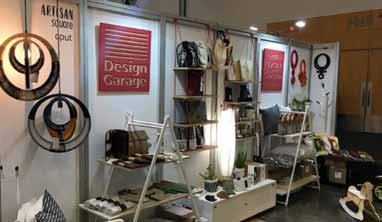
“We are delighted at the exposure offered to our designers by the organisers of the homemakers expo. We’ve always been supportive of the great design talent nurtured at CPuT, and therefore celebrate the fact that through the expo the wider public will come to know just how talented our students and alumni are,” says Mr Pieter Cilliers, manager of the Design Garage.
The stand included colourful prints and products by Surface Design students as well as new products by fourth-year Industrial Design students participating in the 5K project. In the 5K project, students create companies that design and make products with the aim of achieving at least R5 000 profit by the end of the year.

and execute interventions in public space, within a two- to three-year programme, ultimately contributing to Darling’s socio-economic, environmental and cultural agendas. The relation with Fontys Darling Collection is such that one of the major interventions that will be considered is an open-air theatre space, to accommodate future events such as Darling Collection. Service to the community through a collaborative design process results in awareness of design and collaborative processes as well as a usable end product. This provides an opportunity for learning for CPuT students in a Design-Build studio.
Live design, transform life: Relevant technologies and digital services for the wellbeing of the youth@risk – 2017-2019
Students from across CPuT’s six faculties will soon be learning in the state-ofthe-art 4D immersive theatre environment of the new-look Iziko Planetarium. Six months ago, the Planetarium closed to the public for an urgently-needed R28.5 million refurbishment, which included replacing the 30-year-old Minolta projector with a Digital Dome. CPuT, along with academic partners uCT and uWC, financially supported the project after recognising the potential of having advanced digital visualisation technology on their doorstep in Cape Town. The potential of the Digital Dome extends to the in-depth study of animation, chemical structures, human anatomy and the depths of the ocean, to name but a few. The Digital Dome will also spark learner interest in sciences and optimise SA’s eResearch and data visualisation capacity.
Dr Chris Nhlapo, DVC: RTI&P, says the Iziko Planetarium project shows the potential of regional collaboration. “Collaboration is not about competition. It means working together for the common good. The launch of this project is the realisation of a dream. It is the result of lots of hard work and the ability to forge alliances between universities, in order to provide our researchers and students with an opportunity to experience what could only have been dreamt of before. With this technology, we are enabling our researchers to experience what has thus far been out of reach. It creates new experiences and new knowledge without which we cannot build our future,” he says.
This is a transdisciplinary action research project, based on collaborative design and use of digital technology to address some of the foremost health and socioeconomic challenges experienced by youth groups in South Africa and Namibia. We aim to work with local vulnerable groups in identifying and addressing areas for social and economic change. Because the challenges faced by youth groups are multidimensional and interrelated, we will work across multiple disciplines in different application areas of health (maternal health, nutrition and health, e-health for social change, wellbeing and quality of life) and socio-economic development (sustainable livelihoods and safety and security, especially relating to gender-based violence). While following a situated methodological approach in South Africa and Namibia, we will attempt to evaluate and ensure the transferability of results to the region, continent and eventually the global context. The overall objective of this project is to co-develop technology and digital services with youth@risk communities to improve their wellbeing, with a special focus on health, sustainable livelihood and safety, aiming at digital transformation.
The focus here is to design and develop innovative products, services, applications, etc. This is also the place where students work as interns to develop capacity. Notable developments are:
The Design Garage at the FID was opened in 2016 to showcase and promote DfS inspired socially conscious design projects for BTech Industrial Design students.
This is operated as a Living Lab with student interns from multi-disciplines, of multinationalities, multi-levels and multi-cultures.
Innovation is a collective, multi-disciplinary activity that involves both technological and social aspects. Consequently, the research chair Innovation in society operates throughout the entire spectrum of CPUT activities. The chair builds expertise and competences around topics with societal relevance in the field of science, technology and innovation. here, the focus is less upon the emergence of new knowledge and more on the uptake, absorption and adaption of or resistance to new technologies and innovations in Africa.
Such insights are particularly timely as the latest wave of new and powerful technologies that shape all aspects of our social and economic lives has created a great sense of insecurity. While techno-optimists only see positives, others fear the loss of jobs and a society in which few benefit and many more lose out. ensuring that the new wave of technologies is beneficial to human society, a strong societal consensus on what is wanted and what can be rejected is needed. Such decision processes, though, are novel for many emerging economies. The next technological revolution will build on new manufacturing technologies (e.g. additive technologies), new ways of connectivity (Internet of Things), data science and artificial intelligence. These technologies are characterised by fast-declining hardware costs, as the prices of 3D-printers and industry sensors have demonstrated. This is in stark contrast to previous waves of technological revolution, in which access to technologies was the core difficulty. The true potential of this new technology lies in its knowledge component that meaningfully connects large data-sets with technologies to unlock value for its users. The following topics are of special interest:
ever-expanding mega-cities have become a feature of economic growth in Africa. One focus of urban policy and planning rests on the use of new technologies to support smart specialisation strategies in order to generate dynamic location advantages and local economic growth. especially in the global south, the influx of rural people into the city in search of jobs and better lives and the rapid incorporation of rural areas overwhelm both urban management and public infrastructure construction. This results in extensive landuse changes involving stakeholders with different socioeconomic needs and – consequently – in land-use conflicts. New participatory approaches to urban design have been identified as drivers for social inclusion and a better sense of belonging. Furthermore, community-based participatory design and inclusive socio-economic and environmental planning promise sustainable development and resilient cities. Participatory urban planning processes often repeat the power structures of urban planning, and the process tends to fail as it is a process among unequal partners, like ‘experts’ and ‘non-experts’. In order to overcome these limitations, policy papers mention the use of ‘inclusive platforms’ to enable real public participation in planning and decision making (UN, 2016; UNPAN, 2014). The topic is developed in close cooperation with Prof Kenneth Findlay, Research Chair: Oceans economy, and the Focus Area: Design for Sustainable Development.
Prof Thomas Thurnerthurnert@cput.ac.za
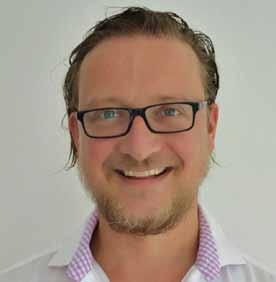
CPuT has appointed Prof Thomas Thurner as the new Research Chair: Innovation in Society. Over the next five years, Prof Thurner will develop and support research activities in the Faculty of Informatics & Design and the Faculty of health & Wellness Sciences. he joined CPuT in April from the higher School of economics in Moscow, Russia, where he established himself as a leading researcher in innovation management with a specific focus on state-owned enterprises. his research has been published in leading journals, including the International Journal of Innovation Management.
AT CPuT, Prof Thurner will focus on collaborative innovation processes through communities of practice. Such informal communities include a wide range of actors and organisations active in a field and across different levels and types of knowledge. “In Africa, we should not focus too much on the supply side of technological innovations, but rather should study users and their processes of making things work. There is enormous potential in innovation processes outside of organisations.”
The aim is to establish a self-financed research group, which will be connected to international universities and provide a steady flow of research papers on African innovation experiences. Prof Thurner says the first major step towards reaching excellence in innovation studies at CPuT is to identify areas with great strategic potential for research and the involvement of relevant stakeholders. Prof Thurner will also work on building up critical research skills in the faculties and actively engage in the supervision of master’s and doctoral students.
Following estimations by the uN’s Food and Agriculture Organisation, the world population will reach 9.77 billion by 2050 (UN, 2017). Global demand for food will increase by 30-50% (FAO, 2017), and distribution channels will have to find ways to make large quantities of agricultural products and processed foods available in densely populated areas as most people will live in cities. The solutions to maintaining the global food supply lie in the largescale adoption of new technologies (Omenn, 2006; King, 2017). Still, the topic of technology application in food production is controversial. In order to identify technological opportunities to increase food security and to study technology acceptance, this topic is developed in cooperation with CPuT’s Agrifood Technology Station.
Digitalisation is changing the manner of product design. Physical-to-digital technologies and new approaches to modeling and simulation will reduce the time from conception to production, and will enable the rapid re-design of individual products and entire production lines. These developments will also allow for a much higher degree of customisation: digital platforms will strengthen the service factor in products and help to integrate customer needs and real-time information sharing. New production methods will build on ongoing data collection and monitoring, as the foundation of artificial intelligence systems, to respond quickly to changes in market
structure or in the technological environment. Research on the future of production is pursued together with the Faculty of engineering.
Affordable healthcare is one of the greatest challenges to socio-economic development in South Africa. A solution to provide large-scale access to high quality healthcare to the poor is the provision of low-cost technological solutions that are adjusted to the emerging economic reality. Biotechnology and robotics will open new opportunities as rapid technological development drives the creation of advanced complex systems of medical equipment, in particular the bio-sensing of various body functions. Such technologies will significantly lower the economic burden on the country’s health system, as early intervention will reduce expensive complications and premature deaths along with all their economic consequences. This research is pursued together with the Faculty of health & Wellness Sciences.
CPuT Research Chair: Innovation in Society has been operational since April 2017 and consists of one person with international standing. Two papers where accepted by Scopus-ranked journals this year.

The Product Lifecycle management Competency Centre trains students and professionals in the art of system engineering, product design, and product lifecycle management, as well as hosting and supervising design projects. The centre uses a high-end design, modelling and simulation software suite, CATIA™ V6, to deliver on these core activities. The PLmCC is a partnership between the French ministry of education, Dassault systèmes and CPUT. The centre was launched in march 2012.
Big data refers to the use of data analytics to extract relevant information out of large-scale data sets derived from advanced data transmission and sensor technology. To create a platform for big datarelated research and its far-reaching applications, Prof Thomas Thurner, CPuT’s Research Chair: Innovation in Society, started the Big Data and Digital Innovation Research Focus Group.
During the launch in November, Prof Thurner presented a big data approach to identifying new trends and food sources in agriculture and food production technologies in response to a rising population. Mr hjalmar Mulder, an experienced IT consultant, outlined big data’s influence in and potential for businesses, while Prof Ken Findlay, CPuT’s Research Chair: Oceans economy, spoke about the use of big data in remote sensing (scanning the earth by satellite or aircraft) ocean ecosystems.
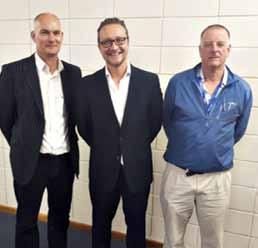
Stephen Bosman: Manager (Industrial and Systems Engineering)

Donovan Cogan (Mechanical Engineering)
Dennit Adams (Industrial and Systems Engineering)
Shane Martin (Mechanical Engineering)
Nadine de Lille (BTech: Mechatronics)
In 2017, the PLMCC focused on projects that required the modelling of systems and their behaviours. These design projects included a Lego mind storm line follower, a waste water treatment reactor, a mechanical bird, product workstations for an industrial partner in the motor refurbishment industry, and the modelling of coal-powered turbines.
Mr Stephan Bosman
bosmans@cput.ac.za
The Lego mind storm line follower project is a collaboration between the PLMCC and the mechatronics department. The PLMCC has completed the supervision of two mechatronic BTech students, who are doing the line follower as their final project. The students involved in the project were trained to use CATIA™ V6, as well as CATIA Systems. This project was completed and involved modelling and simulating the behaviour of the line follower on CATIA Systems. The project will be used as learning material to train students to model the behaviour of cyberphysical systems. It is envisaged that the ability to model and simulate the behaviour of a complete system will boost innovation capability tremendously. A poster and Ieee journal article have been generated as deliverables for this project.
The waste water treatment reactor (WWTR) project was the result of a collaboration with CoorTech, the chemical engineering department from Cape Town campus, and Prof Verushka Fester’s textile project. The textile dyeing industry uses on average 25 000 litres/hour of water during the dyeing and washing process. The use of these vast volumes of water puts pressure on our natural water resources and exacerbates the current water scarcity. The PLMCC will provide product design and development services to CoorTech / Professor Fester in a collaborative environment to construct a 1000 l/hr reactor for textile wastewater treatment. The requirements include the characterisation of the internal flow of the system, upscaling the existing prototype, and designing the system for commercialisation into industry. Subsystems will then be designed and specified to perform desired system functions. Interfaces between subsystems will also be specified. The final system specification will be
confirmed, and an engineering development model (EDM) will be produced. This will be done on a Catia’s 3D modelling software package and the project will be completed in June 2018.
The mechanical bird design project started as a result of a collaboration between Supméca, a French university, and the PLMCC. Two students from Supméca completed a six-month internship at the PLMCC. Stemming from the quadcoptor project, an alternative design in the form of a mechanical bird, an Albatross, was suggested. The main project was to model the mechanical bird using CATIA Systems. As part of this ongoing project, the students have successfully completed the first iteration by producing a theoretical model that flaps its wings, flies with a natural motion and can soar without wind. The motivation was to model an alternative to the principles of drone design to explore natural options. A bird would in theory be able to soar, reducing the visual pollution in the sky. It may be stealthier than the current military quadcopter drones, while allowing for optimisation of the design and tailoring it to a specific mission.
Another partnership is with the hochshule Deutschland (HSD), a German university with a PLM lab in Dusseldorf. One student from hSD completed a six-month internship at the PLMCC working in collaboration with an industry partner to help with the design and optimisation of a process to complete the refurbishment of a MTu 16V400 class diesel engine. This company is an international engine refurbishment company located in South Africa. The design of the product and workstations was modelled in CATIA™ V6 and CATIA systems such as Delmia software.
Academic projects hosted and supervised by the PLMCC in 2017:
• Two EPPEI (Eskom Power Plant Engineering Institute) projects aimed at the modelling of coal-fired turbines (Jeanssy Diankouika, MEng: Mechanical Engineering and Landry Katende, MEng: Mechanical Engineering)
• Alternative design concepts using additive manufacturing for Cube satellites (Shane Martin, MEng: Mechanical Engineering)
• Technological advances in the rapid construction of housing (Chriss Bondo, MTech: Mechanical Engineering)
• Design and development of a quadcopter to supplement crop scouting in agriculture for smallholder farmers (Jonathan Moses, MTech: Mechanical Engineering)
uNIVeRSITY COuNTRY INTeRNS
Supméca France 2
Hochschule Düsseldorf Germany 1
CPUT (Mechatronics) SA 2
CPUT (Mechanical Engineering) SA 1
Deputy Vice-Chancellor (Acting): Research, Technology Innovation & Partnerships
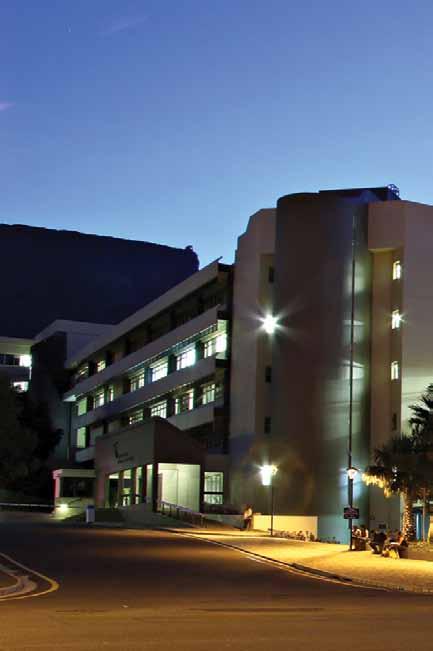
Prof Marshall Sheldon
021 959 6203 021 959 6002 sheldonm@cput.ac.za
Room 228, Administration Building, Bellville
Ms Liziwe Poni Secretary to the DVC 021 959 6242 021 959 6002 ponil@cput.ac.za
Room 228, Administration Building, Bellville
Director (Acting): RTI s trategic Initiatives & Partnerships
Prof René Pellissier 021 460 3402 pellissierr@cput.ac.za
Room 6.18, Administration Building, Cape Town
Director
Prof Dina Burger Director: Research
021 953 8455
burgerd@cput.ac.za
CPGS offices, New Library Building, Bellville
Mr Clement Matasane Manager: Research
021 460 3383 matasanec@cput.ac.za
Room 2.8, Administration Building, District 6
Ms Luyolo Kamati Coordinator: Research Information Management System (RIMS)
021 460 3843 kamatil@cput.ac.za
Room 2.8, Administration Building, District 6
Ms Pumza Makaula Research Grants Officer
021 460 3895 makaulap@cput.ac.za
Room 2.8, Administration Building, District 6
Mr Marvin La Meyer Research Finance Administrator
021 460 3798
lameyerm@cput.ac.za
Room 2.8, Administration Building, District 6
Ms edwina Pedro Secretary to the Director
021 953 8456 pedroe@cput.ac.za
CPGS offices, New Library Building, Bellville
Ms Tania holmes-Watts Manager: Research Grants
021 460 4240 / 021 959 6699 holmes-wattst@cput.ac.za
Room 2.8, Administration Building, District 6
Ms Lara Smith Coordinator: Research Writing, Information & Publications
021 460 3328 smithll@cput.ac.za
Room 2.8, Administration Building, District 6
Ms Ntombenhle Goba Research Grants Administrator
021 460 3241
gobant@cput.ac.za
Room 2.8, Administration Building, District 6
Ms hlengiwe Nzama Research Administrator
021 460 3887
nzamah@cput.ac.za
Room 2.8, Administration Building, District 6
Dr Patricia Smit Manager: Capacity Development
021 460 3539 / 021 959 6249 smitpa@cput.ac.za
Room 2.8, Administration Building, District 6
B2.07 New engineering Building, Bellville
Ms Cheryl-Anne Wyngaard Coordinator: Finance
021 460 8473 wyngaardc@cput.ac.za
Room 2.8, Administration Building, District 6
Ms Shafeeqa hendricks-Dramat Research Finance Administrator
021 460 4241
dramats@cput.ac.za
Room 2.8, Administration Building, District 6
Ms Phathiswa Swaartbooi Research Finance Administrator
021 460 3796
swartbooip@cput.ac.za
Room 2.8, Administration Building, District 6
Director
Dr Revel Iver
Director of Technology: Transfer & Industrial Linkages
021 959 6431
iyerr@cput.ac.za
Technology Transfer Office Technology Institute, Bellville
Managers
Mr Marlin Fransman
Tech Transfer Manager: Legal
Mr Nicholas Goniwe Tech Transfer Manager: IP 021 959 6044
fransmanm@cput.ac.za
Technology Transfer Office Technology Institute, Bellville
Ms halimah Rabiu
Coordinator: Technology Promotion
021 959 6879
rabiuh@cput.ac.za
Technology Transfer Office Technology Institute, Bellville
Ms Jayde Barends
Tech Transfer Officer: Marketing
021 959 5871
barendsj@cput.ac.za
Technology Transfer Office Technology Institute, Bellville
021 959 5895
goniwem@cput.ac.za
Technology Transfer Office Technology Institute, Bellville
Ms Karen Martin TTO Officer
021 959 6044
martink@cput.ac.za
Technology Transfer Office Technology Institute, Bellville
Ms Matamela Sigweda
Tech Transfer Officer: IP
021 959 5871
sigwedam@cput.ac.za
Technology Transfer Office Technology Institute, Bellville
Ms Nomaphelo Ndindwa Assistant TTO Officer
021 959 6044
ndindwan@cput.ac.za
Technology Transfer Office Technology Institute, Bellville

Director
Prof Dina Burger Acting Director
021 953 8455
burgerd@cput.ac.za
Centre for Postgraduate Studies
New Library Building, Bellville
Statistician
Dr Corrie uys
CPGS Statistician
021 460 3258
uysc@cput.ac.za
Centre for Postgraduate Studies
New Library Building, Bellville
Ms Phaphama Mhlekwa evaluation & Monitoring Officer
021 953 8462
mhlekwap@cput.ac.za
Centre for Postgraduate Studies
New Library Building, Bellville
Ms Mtembukazi Sibindlana Bursary Administrator
021 953 8600
sibindlanam@cput.ac.za
Centre for Postgraduate Studies
New Library Building, Bellville
Ms edwina Pedro Secretary to the Acting Director
021 953 8456
pedroe@cput.ac.za
Centre for Postgraduate Studies
New Library Building, Bellville
Ms ethne Mentoor Finance Administrator
021 959 6505
mentoore@cput.ac.za
Centre for Postgraduate Studies
New Library Building, Bellville
The 2017 Research Report is published by the CPuT Research Directorate. The editors acknowledge, with thanks, the contributions of:
• The Marketing and Communication Department at CPuT for photographs and items retrieved from the News Archive

• Dr André Steenkamp (Faculty of Education), for the Afrikaans translation of the Vice-Chancellor’s message
• Dr Zakhile Somlata (Faculty of Education), for the isiXhosa translation of the Vice-Chancellor’s message
• Researchers, faculties, research entities and centres e ditorial team
Ms Lara Smith smithll@cput.ac.za
Prof Gareth Cornwell dgncornwell@gmail.com
Ms Luyolo Kamati kamatl@cput.ac.za
Design
Bridgette hunt bahunt@wol.co.za
Printing
RSA Litho www.rsalitho.co.za






